HYUNDAI MOBIS ADC30C6AN-1 DIGITAL CAR AVN SYSTEM User Manual Manual Part 1
HYUNDAI MOBIS CO., LTD. DIGITAL CAR AVN SYSTEM Manual Part 1
Contents
- 1. Manual Part 1
- 2. Manual Part 2
Manual Part 1

D9MS7-BD001
CAR MULTIMEDIA SYSTEM
USER'S MANUAL
D9EUH06
(영어 | 미국) 표준5세대

Thank you for purchasing this multimedia
system.
This user's manual explains how to use
the Kia Motor multimedia system.
Before using the product, read the con-
tents of this user's manual carefully and
use this product safely.
•
The screens shown in this manual may
differ with the actual screens of the
product.
•
The design and specification of this
product may change without prior notifi-
cation for product improvement.
•
When transferring the vehicle to another
individual, include this user's manual so
that the next driver can continue its use.
Precaution for safe usage
•
Driving while distracted can result in a
loss of vehicle control, that may lead to
an accident, severe personal injury, and
death. The driver’s primary responsibil-
ity is in the safe and legal operation of a
vehicle, and use of any handheld devices,
other equipment, or vehicle systems which
take the driver’s eyes, attention and focus
away from the safe operation of a vehicle
or which are not permissible by law should
never be used during operation of the
vehicle.
•
Do not operate the
multimedia system
while driving.
•
Do not disassemble, assemble, or modify
the
multimedia system
.
•
Do not watch the screen for prolonged
periods of time while driving.
•
Set the volume to a level which allows the
driver to be aware of external conditions.
•
Do not operate the
multimedia system
for
prolonged periods of time with the vehicle
ignition in ACC. Such operations may lead
to battery discharge.
•
Be cautious not to spill water or introduce
foreign objects into the device.
•
Do not cause severe shock to the device.
Direct pressure onto the front side of the
monitor may cause damage to the LCD or
touch panel.
•
In case of product malfunction, please
contact your place of purchase or service
center.
•
When cleaning the touch screen, make
sure to turn off the device and use a dry
and smooth cloth. Never use tough materi-
als, chemical cloths, or solvents (alcohol,
ammonia, benzene, thinners, etc.) as such
materials may damage the device panel or
cause color and quality deterioration.
•
SiriusXM service requires a subscrip-
tion, sold separately, after 3-month trial
included with vehicle purchase. If you
decide to continue your SiriusXM ser-
vice at the end of your trial subscription,
the plan you choose will automatically
renew and bill at then-current rates until
you call Sirius XM at 1-866-635-2349 to
cancel. See our Customer Agreement
for complete terms at www.siriusxm.
com. Programming subject to change.
Sirius satellite service is available only
to those at least 18 and older in the 48
contiguous USA, D.C., and PR (with
coverage limitations). Traffic informa-
tion not available in all markets. See
siriusxm.com/traffic for details. Sirius,
XM and all related marks and logos are
trademarks of Sirius XM Radio Inc.
WARNING
•Driving while distracted can result in a
loss of vehicle control that may lead to
an accident, severe personal injury, and
death. The driver’s primary responsibil-
ity is in the safe and legal operation
of a vehicle, and use of any handheld
devices, other equipment, or vehicle
systems which take the driver’s eyes,
attention and focus away from the safe
operation of a vehicle or which are not
permissible by law should never be used
during operation of the vehicle.
•
At launch, the Apple iPhone® will be the
only UVO eServices compatible device.
iPhone® is a registered trademark of
Apple Inc.
•
App Store is a service mark of Apple Inc.
No charge for the UVO eServices app.
App runs on your smartphone cellular
data service. Normal data rates will apply.
•
HD Radio™ and the HD Radio™ logo
are proprietary trademarks of iBiquity
Digital Corporation.
•
24-hour Roadside Assistance is a service
plan provided by KIA Motors America,
Inc. Certain limitations apply. Coverage
details are available in the KIA Warranty
and Consumer Information Manual.
For
access to Enhanced Roadside
Assistance,
a connected mobile phone via Bluetooth®
within the cellular service coverage area
is required.
•
Vehicle Diagnostics do not take the place
of regularly scheduled maintenance.
Feature checks powertrain, chassis, and
airbag systems only. For factory-recom-
mended maintenance schedule, see the
Maintenance Feature of UVO eServices
or the Owner’s Manual.
•
911 Connect activates after an airbag
deployment. Feature requires a
connected
mobile phone via Bluetooth.
Dependant on
cellular service coverage.
•
The Rear-Camera display is not a substi-
tute for proper and safe backing-up proce-
dures. The Rear-Camera display may not
display every object behind the vehicle.
Always drive safely and use caution when
backing up.
All Map Database cannot be copied without permission.
Important Notice: This is protected by U.S. copyright laws. All rights not expressly granted are reserved.
You may not otherwise reproduce, modify, and distribute the content without HYUNDAI MnSoft, Inc's prior written consent.
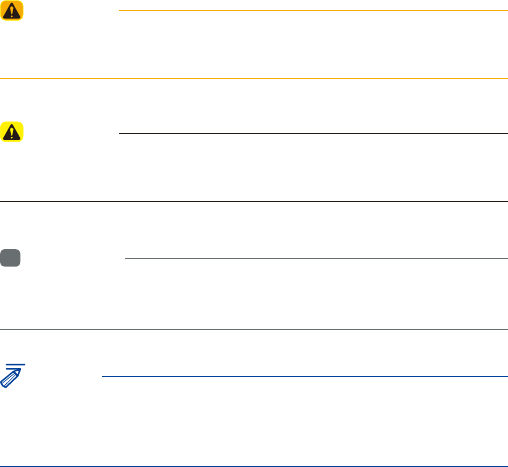
Read the following safety precautions
for your safety
Before using the product, read the contents of this user's manual
carefully and use this product safely.
※ The design and specifications of this product may change without prior
notification for product and service improvement.
The actual images in the vehicle may differ from the illustrations.
For more accurate information about the vehicle, please refer to the
catalogue.
※ This Multimedia system contains open source software, including without
limitation, software distributed and/or modified under the GNU General
Public license, Version 2, June 1991, and the GNU lesser General Public
License, Version 2.1, February 1999.
For additional information and to obtain related materials including
without limitation, the previous referred to licenses and software, please
contact us at MOBIS_OSSrequest@mobis.co.kr
Notations used within this User's Manual
WARNING
• A WARNING indicates a situation in which harm, serious bodily injury or
death could result if the warning is ignored.
CAUTION
• A CAUTION indicates a situation in which damage to your vehicle could
result if the caution is ignored.
i
Information
• Information and tips that provide additional user convenience in using the
product.
NOTICE
• Information on specific features that facilitate proper product use and
functional understanding.
• Information on terminology used within this manual.

2 I Table of Contents
Table of Contents
1. Basic
Warnings and Cautions .............. 1-2
Component Names and
Functions ....................................... 1-5
Head Unit ………………………… 1-5
Steering Wheel Controls ………… 1-7
Starting the System for
the First Time ................................. 1-9
Turning the System On/Off ……… 1-9
System Reset ……………………… 1-9
Battery Warning Message ………1-10
Restrictions on Features for
Safety Measures …………………1-10
Home Screen ………………………1-11
On-Screen Touch Controls ………1-12
2. Radio/Media
FM/AM ............................................ 2-2
HD Radio™ Technology ............. 2-4
HD Radio™ ………………………… 2-5
SiriusXM™ ....................................... 2-6
Selecting through Channel/
Category List ……………………… 2-8
Direct Tune ………………………… 2-8
Viewing Menu ……………………… 2-8
USB ................................................ 2-11
Before Playing a USB MP3 ……… 2-11
Supported USB MP3 music
specifications ……………………… 2-13
USB Music ………………………… 2-14
iPod .............................................. 2-17
Using iPod Devices ………………2-17
iPod ………………………………… 2-21
AUX ............................................... 2-24
Connecting an External Device …2-24
Bluetooth® Audio ........................ 2-25
Bluetooth Connection Settings …2-26
3. Bluetooth
Before Using the Bluetooth®
Handsfree ...................................... 3-2
What is
Bluetooth
®
Wireless
Technology? ……………………… 3-2
Precautions for Safe Driving …… 3-2
CAUTIONS upon Connecting
Bluetooth® Phone ………………… 3-3
Bluetooth Connection ................. 3-4
Pairing a New Device …………… 3-4
Connecting Bluetooth Devices…… 3-4
Disconnecting
Bluetooth Devices ………………… 3-5
Deleting Bluetooth Devices ……… 3-5
Bluetooth Phone .......................... 3-6
Phone Status Icons ……………… 3-6
Dial ………………………………… 3-7
Accept/Reject Call ………………… 3-7
Using the Menu During a
Phone Call ………………………… 3-8
Call History ………………………… 3-9
Contacts …………………………… 3-10
Favorites …………………………… 3-11

Table of Contents I 3
00
4. UVO eServices
The 911 Connect feature may
not operate in the following
situations ........................................ 4-2
About UVO eServices .................. 4-4
Before using UVO eServices ....... 4-5
Connecting Bluetooth ................. 4-5
Pair a device from Bluetooth-
enabled phone ............................ 4-5
Connecting to smartphone
via USB ........................................... 4-6
Activating UVO eServices ……… 4-6
911 Connect ................................. 4-7
911 Connect ……………………… 4-7
Initiating a 911 Call ……………… 4-7
Roadside Assist ............................. 4-8
Roadside Assist …………………… 4-8
Vehicle Diagnostics ..................... 4-9
Conducting Vehicle Diagnostics … 4-9
Schedule Service …………………4-10
Send Report ………………………4-10
Scheduled Diagnostics …………… 4-11
Automatic Diagnostics ……………4-12
My Car Zone ................................ 4-12
Curfew Limit Alert …………………4-13
Speed Alert …………………………4-14
Geo Fence Alert …………………4-14
Parking Minder ........................... 4-15
Sending Parking Location ……… 4-15
My POIs ........................................ 4-15
Sending Points of Interest to Your
Navigation System ………………… 4-15
eServices Guide ......................... 4-16
eServices Guide……………………4-16
UVO eServices Settings ………… 4-16
5. Navigation
Basic Features .............................. 5-2
Operating Navigation Screen …… 5-2
Places ……………………………… 5-3
Changing Map View ……………… 5-3
Navigation Volume ……………… 5-3
Zoom In/Zoom Out ……………… 5-4
Map Scale ………………………… 5-4
Quick Menu................................... 5-5
Route ……………………………… 5-5
Map Display ……………………… 5-6
POI ………………………………… 5-6
Traffic ……………………………… 5-9
Save ………………………………… 5-12
Settings …………………………… 5-12
Destination Search .................... 5-13
Places ……………………………… 5-13
Address …………………………… 5-14
Previous Destinations …………… 5-15
Local Search ………………………5-16
POI Categories ……………………5-17
Gas Stations ………………………5-18

4 I Table of Contents
Restaurants ………………………5-19
Emergency ………………………… 5-19
Address Book ………………………5-20
Coordinates ………………………5-20
Favorite Places ……………………5-21
Route Setting ……………………… 5-22
Route Guidance …………………… 5-24
Route Search .............................. 5-26
Canceling Route …………………5-26
Route Options ……………………5-27
Editing Route ……………………… 5-27
Display Route Information ………5-28
Route Overview ……………………5-29
Avoid Street ………………………5-29
Navigation Settings .................... 5-30
Display ………………………………5-30
Guidance ……………………………5-31
Import/Export ……………………… 5-32
Default ……………………………… 5-32
Troubleshooting ......................... 5-33
6. Voice Recognition
What is Voice Recognition? ....... 6-2
Precautions Required for
Successful Voice
Recognition .................................. 6-2
Starting/Ending and Setting
Voice Recognition ....................... 6-3
Starting Voice Recognition ……… 6-3
Ending Voice Recognition ………… 6-3
Combining Voice Recognition with
On-Screen Commands …………… 6-3
Extending the Listening Time …… 6-4
Skipping Prompt Messages …… 6-5
Adjusting Voice Recognition
Volume ……………………………… 6-5
Voice Recognition Screen
Overview ....................................... 6-6
Start Screen ……………………… 6-6
Help Display ……………………… 6-6
Instructions for Using Voice
Recognition ………………………… 6-7
Voice Commands ........................ 6-8
Types of Commands ……………… 6-8
Call Commands …………………… 6-8
Navigation Commands …………… 6-9
Radio Commands ………………… 6-11
UVO eServices Commands List …6-11
Other Commands List
(Commands used in List/Help) …6-12
“Find <POI>” List ………………… 6-13
UVO Voice Local Search .......... 6-19
What is UVO Voice
Local Search? ……………………6-19
Starting UVO Voice
Local Search ………………………6-19
Siri Eyes Free ................................ 6-20
How to start Siri ……………………6-20
How to use Siri ……………………6-20

Table of Contents I 5
00
7. Data Services
HD Radio™ Data ........................... 7-2
About HD Radio™
Data Services ……………………… 7-2
Accessing HD Radio™ Data …… 7-2
HD Radio™ Weather
Information Mode ………………… 7-2
HD Radio™ Doppler Radar ……… 7-3
SiriusXM™ Data ............................. 7-3
About SiriusXM™ Data Service … 7-3
Accessing SiriusXM™ Data ……… 7-3
SiriusXM™ Weather
Announcement …………………… 7-3
SiriusXM™ Fuel Price
Information ………………………… 7-4
SiriusXM™ Stock Information …… 7-5
SiriusXM™ Sports Information …7-6
SiriusXM™ Movie Information … … 7-8
8. Other Features
Climate ........................................... 8-2
Basic Mode Screen ……………… 8-2
Camera.......................................... 8-4
Steering-linked camera …………… 8-4
9. Setup
Setup .............................................. 9-2
Navigation Settings ...................... 9-2
Sound Settings .............................. 9-2
Display Settings ............................ 9-3
Bluetooth Settings ........................ 9-3
Bluetooth Connection …………… 9-4
Auto Connection Priority ………… 9-5
Bluetooth Voice Prompts ………… 9-5
Bluetooth System Info …………… 9-5
UVO eServices Settings ............... 9-6
911 Connect ……………………… 9-6
Parking Minder …………………… 9-6
My Car Zone ……………………… 9-7
Scheduled Diagnostics …………… 9-9
Trip Info Sync Reminder ………… 9-9
Phone Projection Settings ........ 9-10
Custom Button Settings ............. 9-10
Voice Recognition Settings ...... 9-11
Date/Time Settings .................... 9-11
Language Settings .................... 9-12
Keyboard Settings ..................... 9-12
Screen Saver Settings ................ 9-13
Advanced Settings .................... 9-13
System Info .................................. 9-13
System Update ……………………9-14
10. Appendix
Product Specification................ 10-2
Troubleshooting ......................... 10-3
FAQ ............................................... 10-6
About Pairing Mobile Phones ……10-6
About Making/Answering
Phone Calls ………………………10-7
About
Bluetooth
® Wireless
Technology/Multimedia
System Use Environment …………10-7

Using SD Cards
•Ejecting and Inserting SD Cards
• Ejecting and inserting SD cards while the multimedia system is operating may result in SD
Card or System errors. To eject or insert the SD card, first turn off the multimedia system and
the vehicle ignition.
• Eject/insert SD cards only to update the multimedia system with a new version.
•Usage of SD Cards
• The SD Card is formatted to include only Map and new system update files.
• The SD Card cannot be used to save and play Music.
• Do not add, delete, or format files within the SD Card.
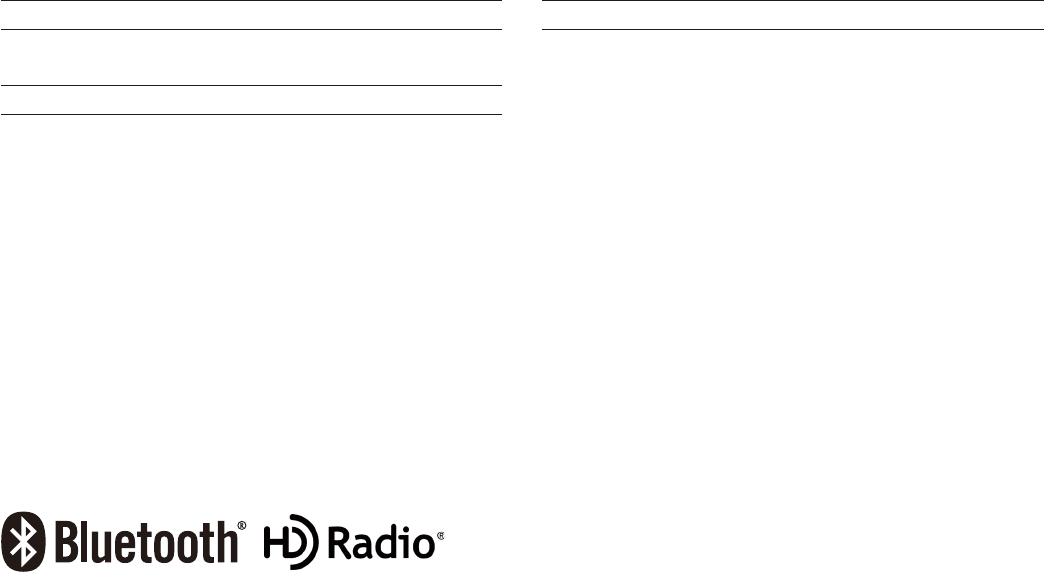
iPod®
iPod® is a registered trademark of Apple Inc.
Bluetooth
®
Wireless Technology
A compatible
Bluetooth
®
Wireless Technology-enabled cell phone is
required to use
Bluetooth
®
Wireless Technology.
The
Bluetooth
® word mark and logos are registered trademarks owned by
Bluetooth SIG, Inc. and any use of such marks by Kia is under license.
Other trademarks and trade names are those of their respective owners.
A Bluetooth® enabled cell phone is required to use
Bluetooth
®
Wireless
Technology.
Bluetooth
®
Wireless Technology phone compatibility can be checked by
visiting http://www.kia.com.
HD Radio™ Technology
HD Radio™ Technology manufactured under license from iBiquity Digital
Corporation. U.S. and Foreign Patents.
For patents see http://patents.dts.com/. HD Radio™ and the HD, HD
Radio™, and "ARC" logos are registered trademarks or trademarks of
iBiquity Digital Corporation in the United States and/or other countries.

Warnings and Cautions
Key Product Features
Component Names and Functions
Starting the System for the First Time
part.1 Basic

1-2 I Basic
Warnings
Do not operate the Multimedia system
while driving, such as entering POIs or
conducting route searches. Such acts
could lead to accidents. Park the vehicle
before operating the device.
•Even when receiving route guidance
from the Multimedia system, please
abide by actual traffic and road regu-
lations. Following only the Navigation
route guidance may lead to violations of
actual traffic and road regulations and
lead to traffic accidents.
• Do not disassemble, assemble, or mod-
ify the Multimedia system. Such acts
could result in accidents, fire, or electric
shock.
•Heed caution not to spill water or intro-
duce foreign objects into the device.
Such acts could lead to smoke, fire, or
product malfunction.
• If you use phone related functions while
driving, you will find it difficult to concen-
trate on operating the vehicle and the
current traffic conditions, so the possibil-
ity of an accident may increase. Please
use phone related functions only when
parked.
• Do not stop or park in parking-restricted
areas to operate the product. Such acts
could lead to traffic accidents.
• For most Audio and multimedia modes,
the display will not operate when the
vehicle is in motion. For your safety, first
park the vehicle to watch or view the
screen.(The screen will only operate
when the parking brake is ON for man-
ual transmission vehicles and when the
parking brake is ON or the gearshift is in
the P (PARK) position for automatic.)
•Some functions other than the one
mentioned above cannot be used while
driving. These functions operate only
when the vehicle is parked.
Basic

Warnings and Cautions I 1-3
01
Cautions
Turn on the car ignition before using this
device. Do not operate the Navigation
system for long periods of time with the
ignition turned off as such operations may
lead to battery discharge.
Pay attention to traffic conditions while
driving.
•In some instances, the navigation may
provide guidance through restricted
areas.
•Upon using the Multimedia system
for more than 10 minutes with the car
engine turned off, the following warning
will be displayed. After 10 minutes, the
warning will be displayed for 5 seconds
every 1 minute.
•Do not subject the device to severe
shock or impact. Direct pressure onto
the front side of the monitor may cause
damage to the LCD or touch screen.
•When cleaning the device, make sure
to turn off the device and use a dry and
smooth cloth. Never use tough materi-
als, chemical cloths, or solvents(alcohol,
benzene, thinners, etc.) as such mate-
rials may damage the device panel or
cause color/quality deterioration. When
experiencing product concerns, inquire
with your place of purchase or service
maintenance center.
•Prevent caustic solutions such as per-
fume and cosmetic oil from contacting
the dashboard because they may cause
damage or discoloration.
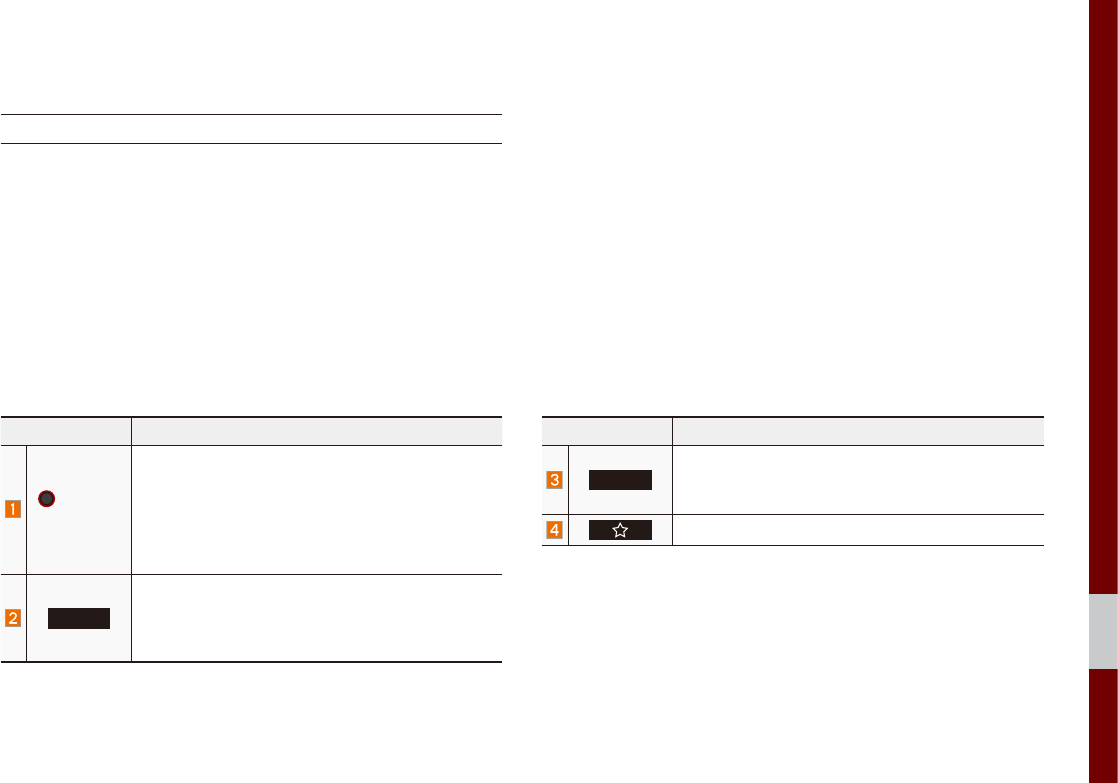
Component Names and Functions I 1-5
01
Component Names and Functions
Head Unit
Name Description
POWER/
VOL
• When power is off, press to turn power on.
•When power is on, press and hold (more than
0.8 seconds) to turn the power off.
• When power is on, press quickly (less than 0.8
seconds) to turn Audio off.
• Turn left/right to adjust the volume.
RADIO
Selects FM/AM/SiriusXM™ mode
•Each time this is pressed, the mode is changed
in the following order: FM → AM → SiriusXM™
→ FM.
Name Description
MEDIA
Selects MEDIA mode.
• If the media is not connected MEDIA mode will
not be activated.
Moves to the function set by the user.
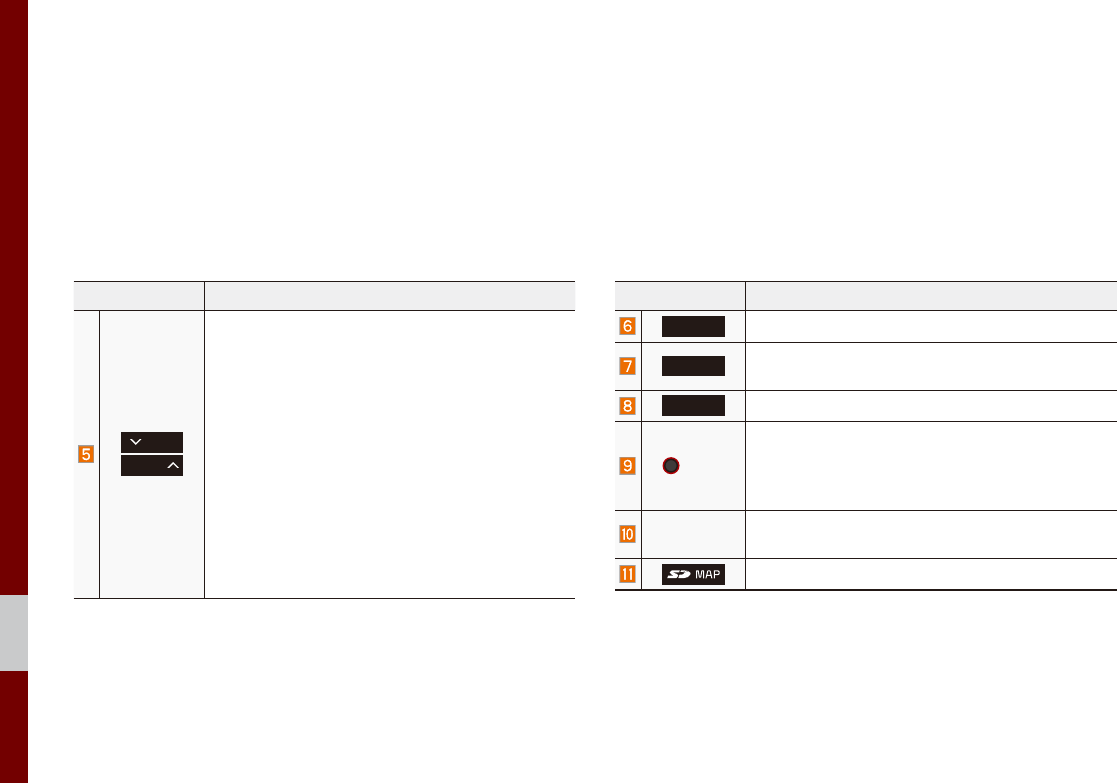
1-6 I Basic
Name Description
TRACK
SEEK
When pressed quickly (less than 0.8 seconds),
•FM/AM mode: Plays the previous/next fre-
quency.
• SiriusXM™ mode: Changes the channel.
•MEDIA mode: Changes the track, file or title
(except for AUX).
When pressed and held down (more than 0.8 sec-
onds),
• FM/AM mode: Moves quickly through all of the
frequencies. The moment that you release the
button, the system seeks the next available fre-
quency.
•MEDIA mode: Rewinds or fast forwards the
track or file (except for AUX, Bluetooth Audio).
Name Description
MAP
Displays the map for the current position.
NAV
Takes you to the menu screen where you can find
your destination and set the route.
SETUP
Moves to the Setup screen.
TUNE
• FM/AM mode: Changes the frequency.
• SiriusXM™ mode: Changes the channel.
•MEDIA mode: Changes the track, file or title
(except for AUX, Bluetooth Audio).
RESET Resets the system settings. (Preset radio channels
and other data will not be deleted)
SD Card insert slot
※ The actual image in the vehicle may differ from the illustration.
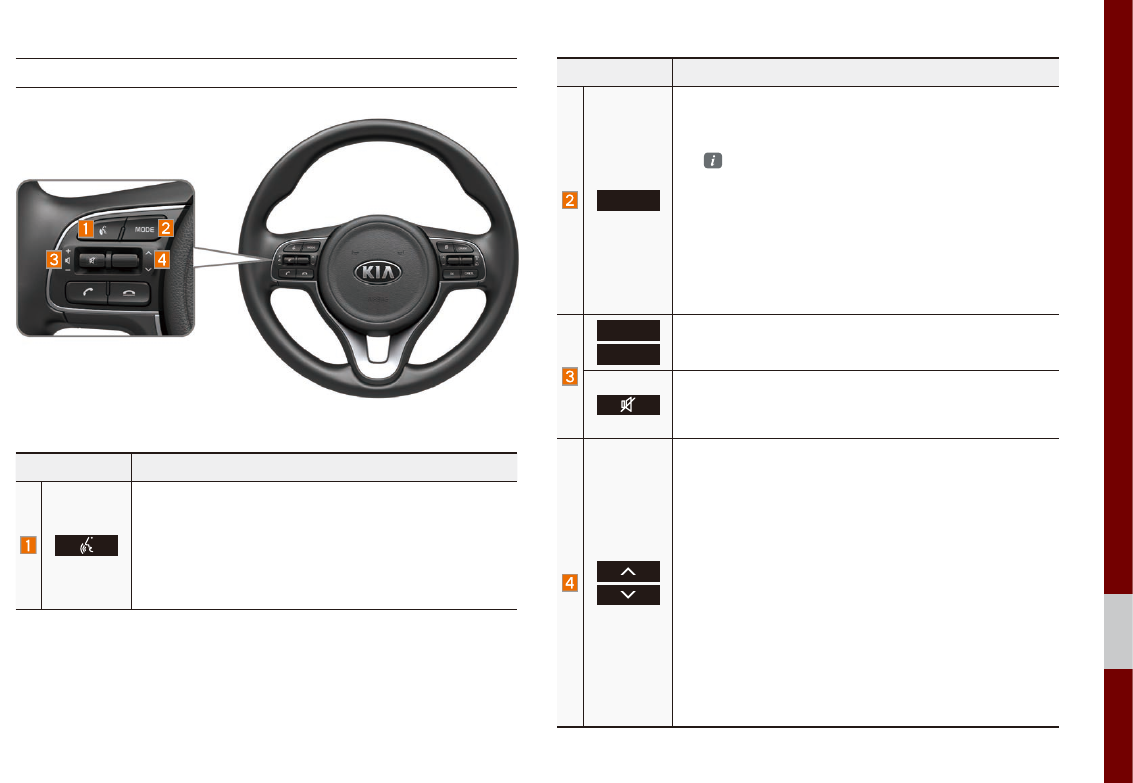
Component Names and Functions I 1-7
01
Name Description
When pressed quickly (less than 0.8 seconds),
• Activates voice recognition.
When pressed and held (more than 0.8 seconds),
• Ends voice recognition.
•If iOS device is connected through Bluetooth,
activates or ends Siri Eyes Free.
Name Description
MODE
•Each time this is pressed, the mode is changed
in the following order: FM → AM → SiriusXM™ →
USB or iPod → AUX → Bluetooth Audio → FM
You can select which mode to use in
Advanced settings.
• If the media is not connected, the corresponding
modes will be disabled
•Press and hold (more than 0.8 seconds) to turn
the Audio system on/off
•When power is off, press button to turn power
back on
+
-
Use to adjust the volume of audio or call.
Mutes the audio. (Media will be paused in some
media modes.)
Mutes the microphone during a call.
When pressed quickly (less than 0.8 seconds),
•FM/AM mode: searches broadcast frequencies
saved to Presets
•SiriusXM™ mode: searches broadcast channels
saved to Presets
•MEDIA mode: changes the track, file or title
(except for AUX)
When pressed and held (more than 0.8 seconds),
•FM/AM mode: automatically searches broadcast
frequencies
• SiriusXM™ mode: automatically searches broad-
cast channels
• MEDIA mode: quickly looks up songs (except for
AUX, Bluetooth Audio)
Steering Wheel Controls
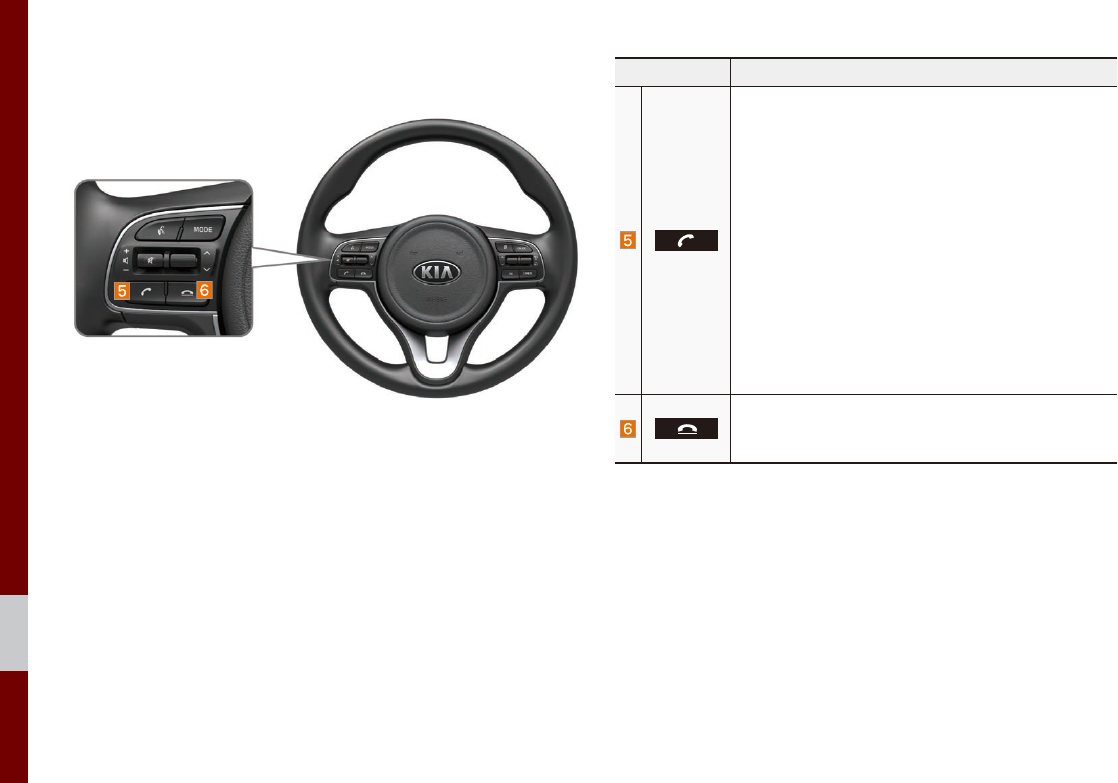
1-8 I Basic
Name Description
When pressed quickly (less than 0.8 seconds),
• When pressed in the dial screen, makes a call
•When pressed in the incoming call screen,
answers the call
•When pressed during call waiting, switches to
waiting call (Call Waiting)
When pressed and held (more than 0.8 seconds),
•When pressed in Bluetooth
®
Hands-free, redials
the last dialed call
•When pressed during a Bluetooth
®
Hands-free
call, switches call back to mobile phone (Private)
• When pressed while calling on the mobile phone,
switches call back to Bluetooth
®
Hands-free
(operates only when Bluetooth
®
Hands-free is
connected)
• When pressed during a call, ends the phone call
• When pressed in the incoming call screen, rejects
the call
※ The actual image in the vehicle may differ from the illustration.
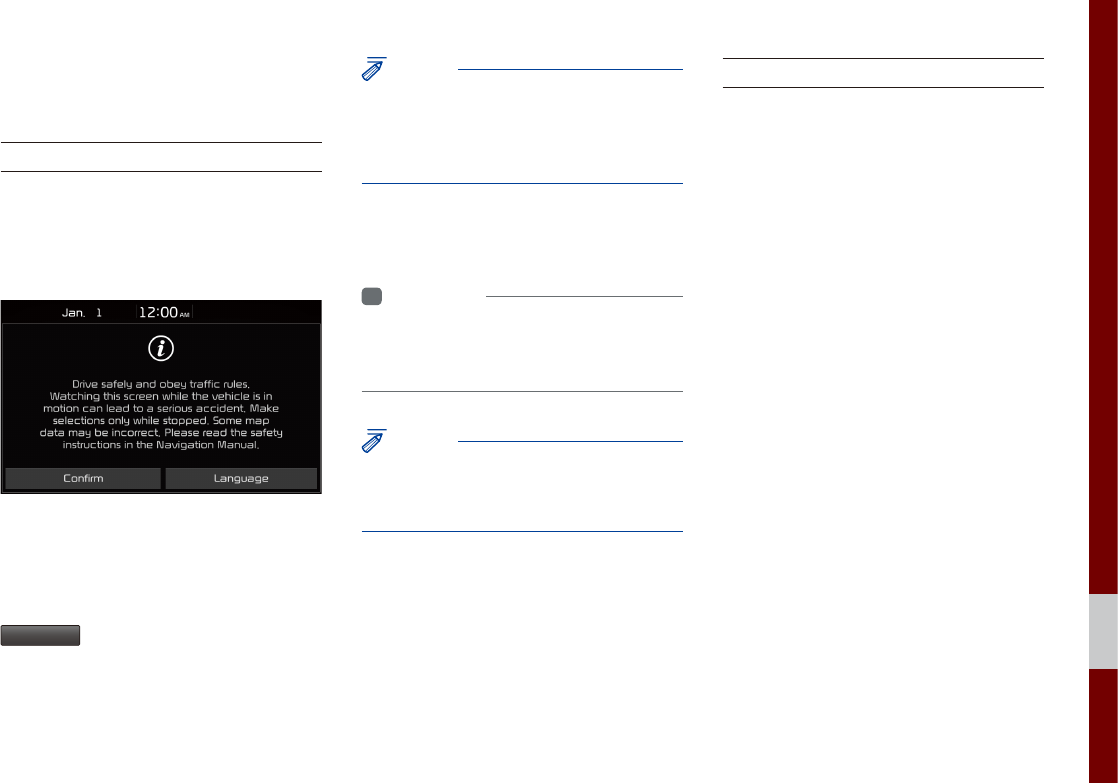
Starting the System for the First Time I 1-9
01
Starting the System for
the First Time
Turning the System On/Off
Press the engine start button or set the
ignition key to On or ACC. Each time you
turn on the system, a boot logo and safety
warning will appear.
Pressing the power key on the head unit
will display the safety guide. To change the
system language between English,
French, Spanish and Korean, select the
Language
button.
NOTICE
• You cannot operate the system while it is
booting up. It may take some time for all of
features of the system, particularly the voice
recognition system, to be ready for use.
Pressing and holding the power key on the
head unit will turn off the system.
i
Information
• If you turn off the system during a phone call
using the Hands-free feature, then the call will
automatically switch to your mobile phone.
NOTICE
• Check the volume when turning on the
system. Before turning on the system, adjust
the volume to a reasonable level.
System Reset
The System Reset function restores the
system when it is not operating correctly.
Press and hold the RESET key for a sec-
ond or longer. (It is recommended that you
press the RESET key using a tool, such as
a pin or a clip.)
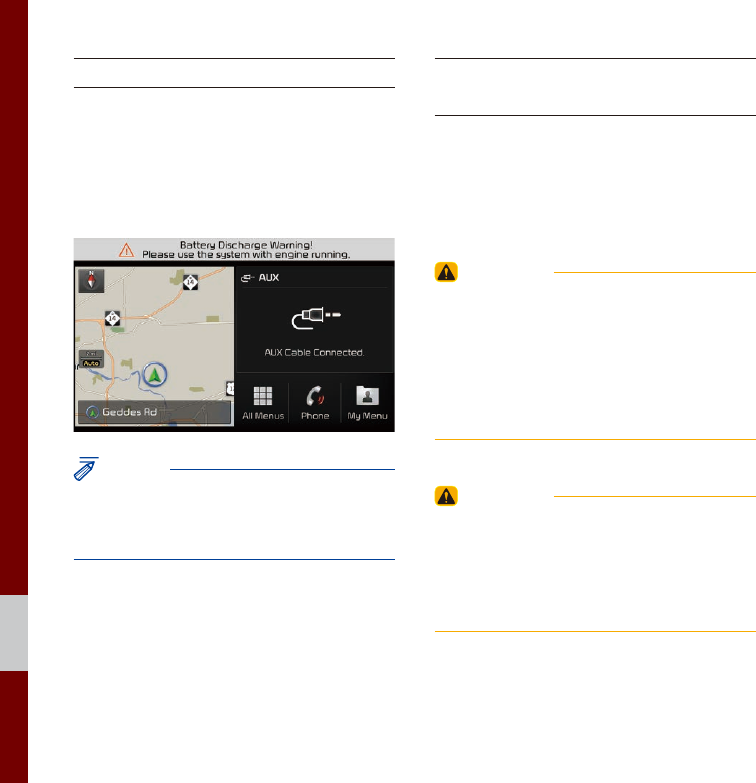
1-10 I Basic
Battery Warning Message
Always use the system while the car
engine is running. If you turn on the sys-
tem while the engine is off, a battery warn-
ing message will appear. When the engine
starts, the message will disappear.
NOTICE
• If you use the system for a long time with
the engine off, the battery may become
completely discharged.
Restrictions on Features for
Safety Measures
Several features are limited while driving.
The restriction screen will disappear when
shifting gears into P or putting the parking
brake on.
WARNING
- Blank Screen
• Refrain from use if the screen is blank or
no sound can be heard as these signs may
indicate product malfunction. Continued use in
such conditions could lead to accidents (fires,
electric shock).
WARNING
- T ouching the Antenna During A
Thunder Storm
• Do not touch the antenna during thunder or
lightning as such acts may lead to lightning
induced electric shock.
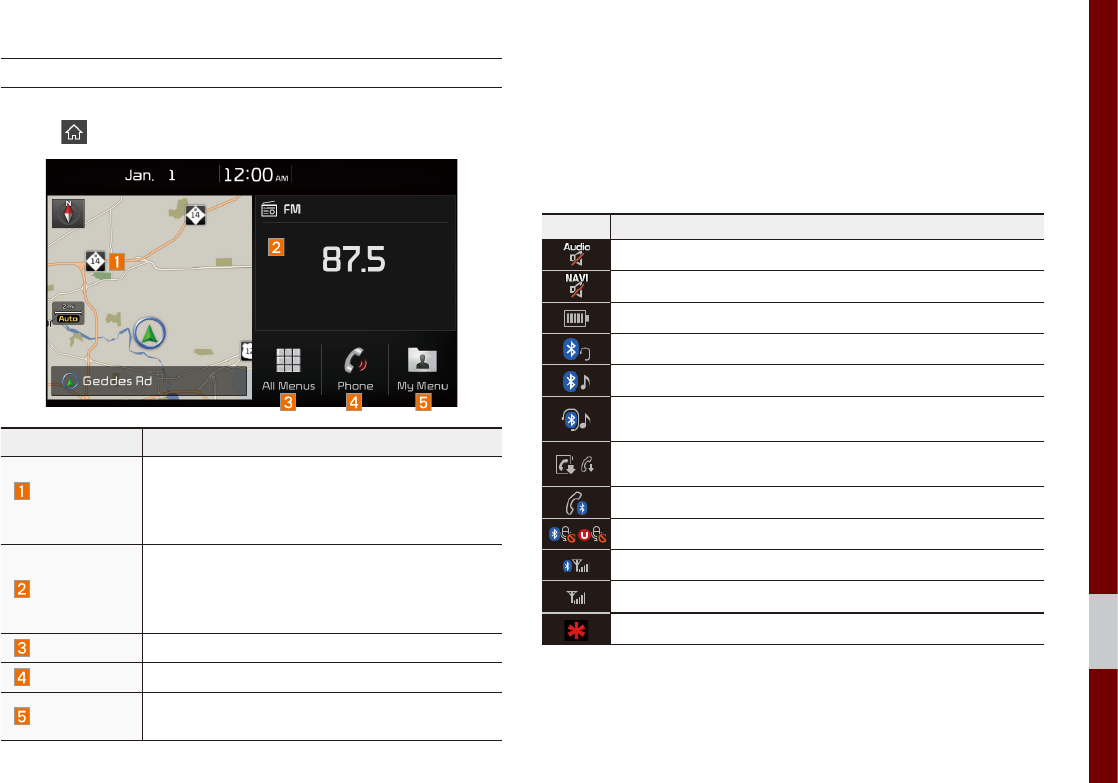
Starting the System for the First Time I 1-11
01
Home Screen
Controls Menu Configuration for the Home Screen
Tap the icon on any screen to display the Home Screen below.
Features Description
Navigation
Widget
• Provides a brief view of the navigation map
and the route screen.
•Touch any area on the screen to move to the
navigation screen.
AV Widget
•Shows brief information on the radio or
media that is now playing.
•Tap the area to move to the mode that you
are listening to.
All Menus Shows all of the items in the system menu.
Phone Displays user to phone screen.
My Menu Add your favorite menus to have quick and easy
access to them.
Information Display on the Status Bar
Displays the date and time, along with the system status shown by
the various icons to the right of the clock.
The icons in the following table indicate the various types of sys-
tem status details and events.
Icon Description
Displayed when the audio is muted.
Displayed when the navigation sound is muted.
Displays the remaining battery of the Bluetooth phone.
Displayed when connected to Bluetooth for handsfree.
Displayed when connected to Bluetooth for streaming audio.
Displayed when connected to Bluetooth for streaming audio and
handsfree.
Displayed when downloading contacts or recent calls from the
Bluetooth phone.
Displayed while on a call with the Bluetooth phone.
Displayed when the microphone of the Bluetooth or UVO phone is muted.
Displays the signal strength of the Bluetooth phone.
Displays the signal strength of the UVO.
Displayed when 911 connect is available.
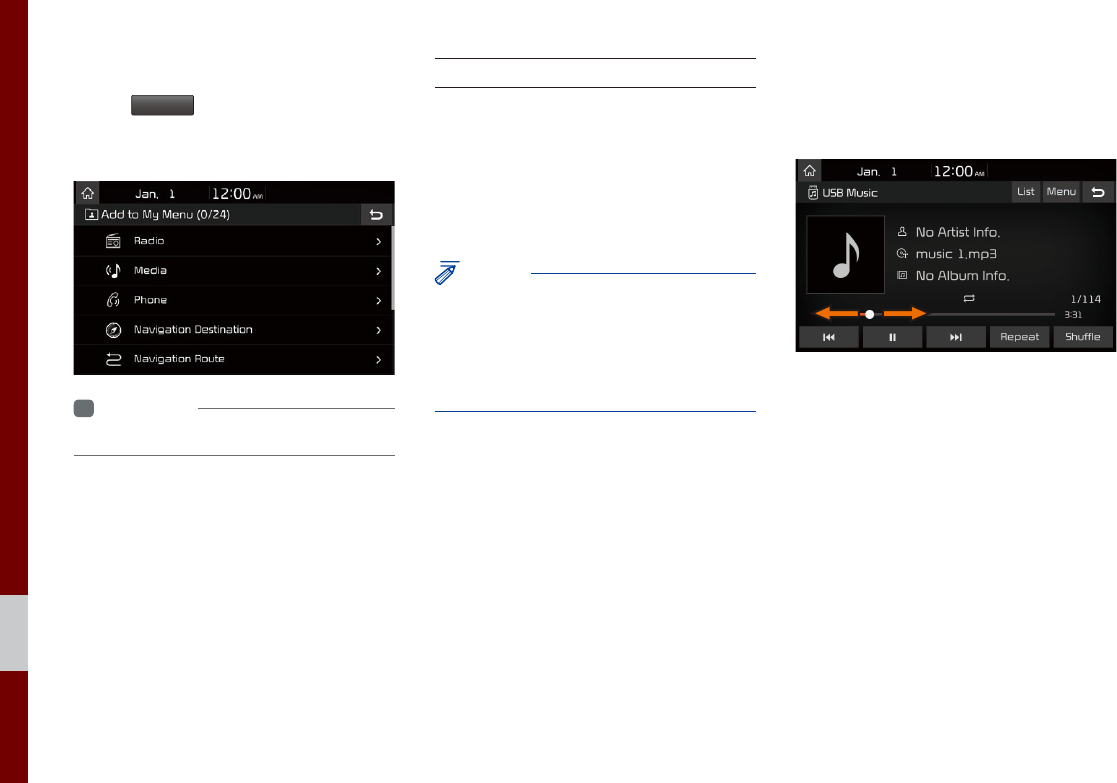
1-12 I Basic
Adding a Feature to My Menu
Select
My Menu
on the Home Screen to
add the most frequently used menus,
change the menu order, or delete menus.
i
Information
• Up to 24 menus can be added to My Menu.
On-Screen Touch Controls
Learn how to touch the screen to operate
the system.
Select
Tap lightly on a menu or an item to select it.
NOTICE
• The system will not recognize your touch if
you wear a glove or other non-conductive
material. Touch the screen using your finger,
an electrostatic touch-screen glove, or a stylus
pen.
Drag & Drop
Select a menu or item you want, then drag
and drop it to where you want to place it.
Drag or touch the slider along the play bar
in the music screens to jump to the point
that you want to play from.
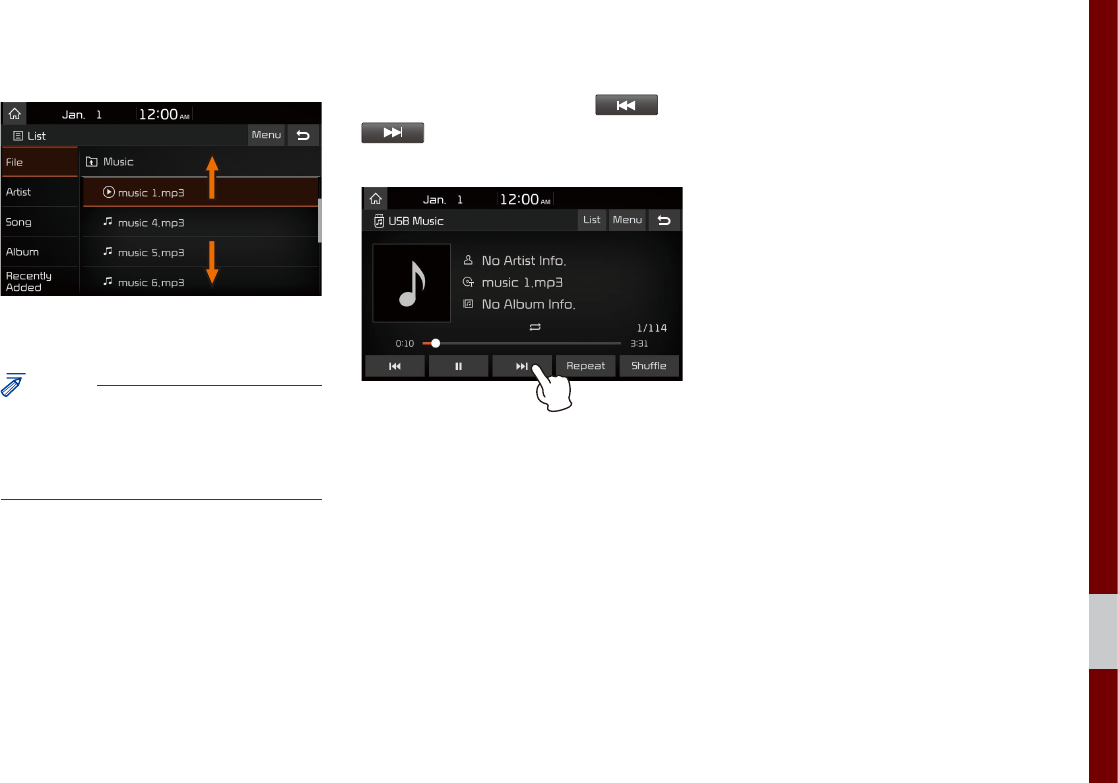
Starting the System for the First Time I 1-13
01
Flick (Quick Scrolling)
Quickly moves up and down in the list.
NOTICE
• Moving the list when there are many items will
display a handler on the right of the display.
You can easily move many items at a time
with the handler.
Select and Hold
Selecting and holding the or
buttons in the music player will
rewind or fast forward the music.

MEMO

FM/AM
HD Radio™ Technology
SiriusXM™
USB
iPod
AUX
Bluetooth® Audio
part.2 Radio/Media
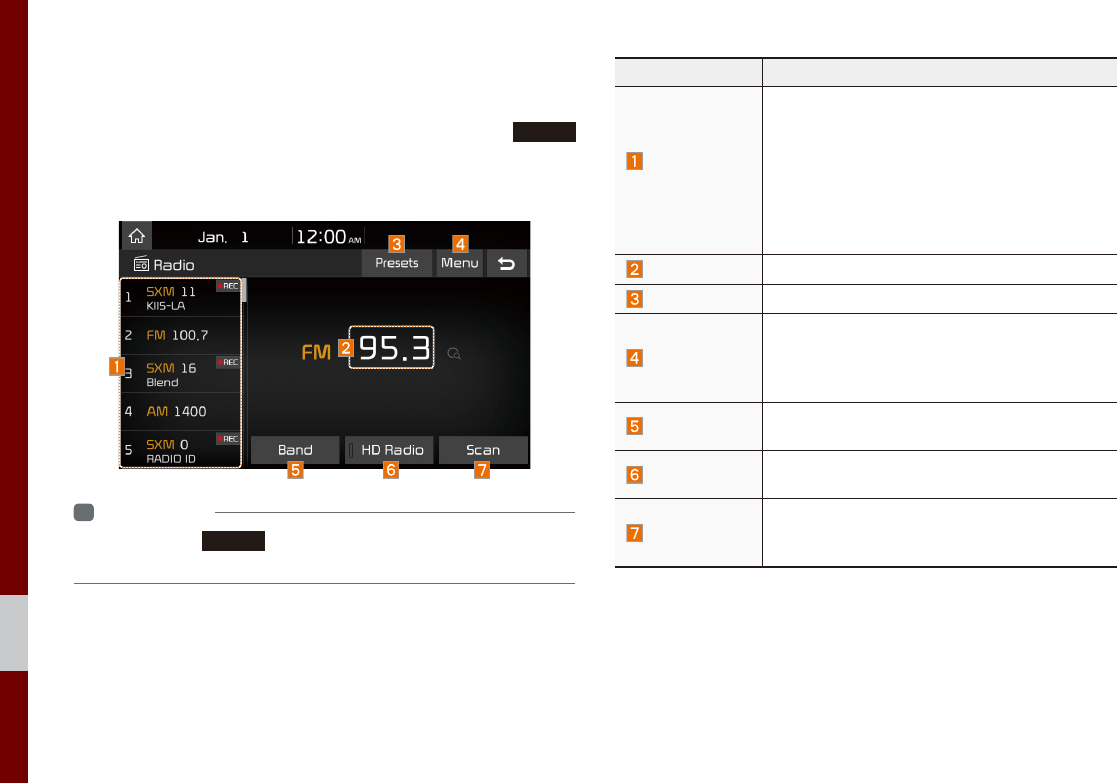
2-2 I Radio/Media
FM/AM
You can access the radio player either by pressing the
RADIO
key or by selecting the Radio menu from All Menus on the Home
screen.
i
Information
• If you press the
RADIO
key when power is off, the power will turn on
and a radio broadcast will be tuned from the current mode.
Features Description
Preset
Frequencies
•The stored preset frequencies are displayed
for user selection.
• After selecting frequency, press and hold
the preset button for more than 0.8 seconds.
A beep sound will be heard and the frequency
is to be stored in the selected preset button.
• Flick the preset frequencies up/down to scroll
quickly through presets.
Frequency Displays the current frequency.
Presets Shows the stored presets for user selection.
Menu
• Station List: Moves to the station list.
• Info: Turns the Radio text information transmit-
ted from the broadcasting station on and off.
•Sound Settings: Moves to the Sound Settings.
Band Changes to the desired band from among FM,
AM, and SiriusXM™.
HD Radio Used to set whether to turn HD Radio™ recep-
tion On or Off.
Scan
Shortly plays the broadcasts for the frequen-
cies with superior reception for 5 seconds per
item.
Radio/Media
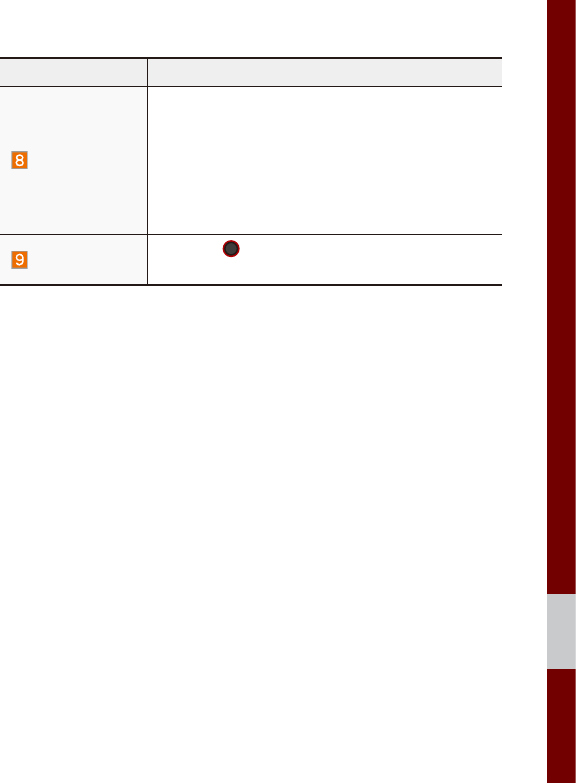
02
FM/AM I 2-3
Features Description
SEEK/TRACK
•When pressed quickly (less than 0.8 sec-
onds): Seeks the previous/next frequency.
• When pressed and held (more than 0.8 sec-
onds): Moves quickly through all of the fre-
quencies. The moment that you release the
button, the system seeks the next available
frequency.
TUNE Turn the
TUNE
knob to manually seek avail-
able frequencies.
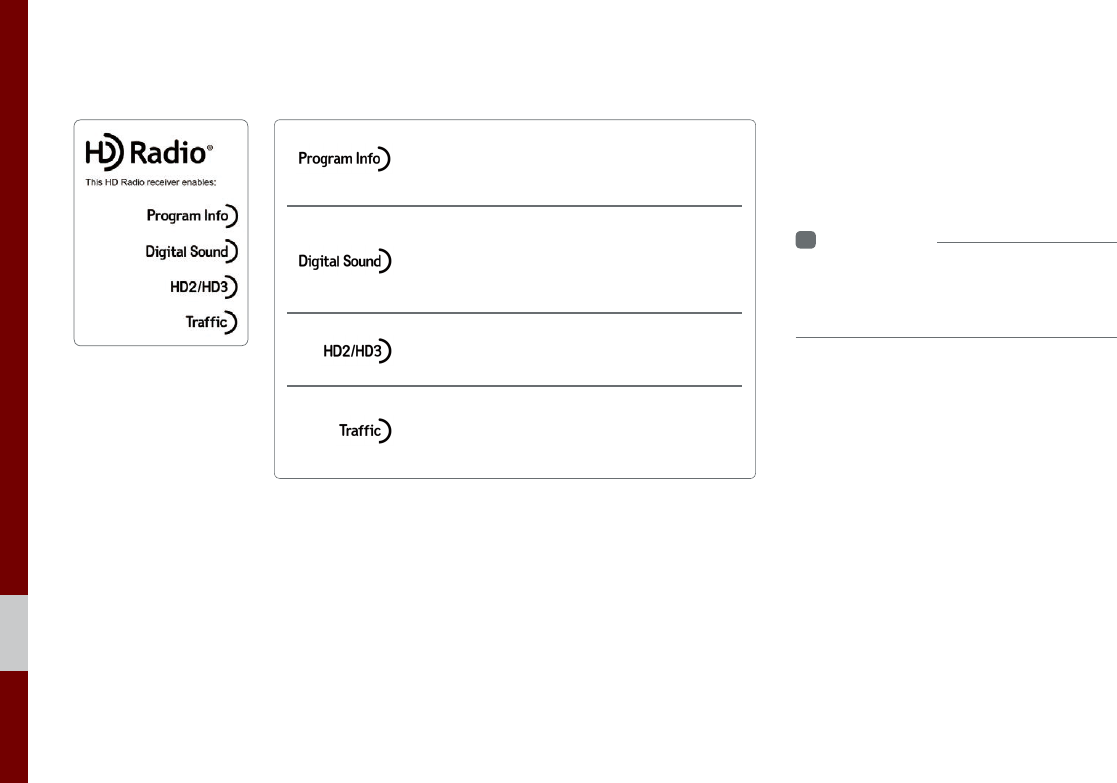
2-4 I Radio/Media
If an HD Radio™ broadcast is received,
the radio mode will switch from analog
broadcast to HD Radio™ broadcast.
i
Information
• The
HD Radio™
screen is displayed only
when a HD Radio™ broadcast is being
received.
HD Radio™ Technology
Program Info: Presents song name, artist, station
IDs, and other relevant data streams.
Digital, CD-quality sound. HD Radio™
Technology
enables local radio stations to broadcast a clean
digital signal. AM sounds like today’s FM and FM
sounds like a CD.
FM stations can provide additional digital-only
audio programming on HD2/HD3 Channels.
Real-Time Traffic reports, alerts, and flow data
displayed on screen via interactive traffic maps
and/or data.
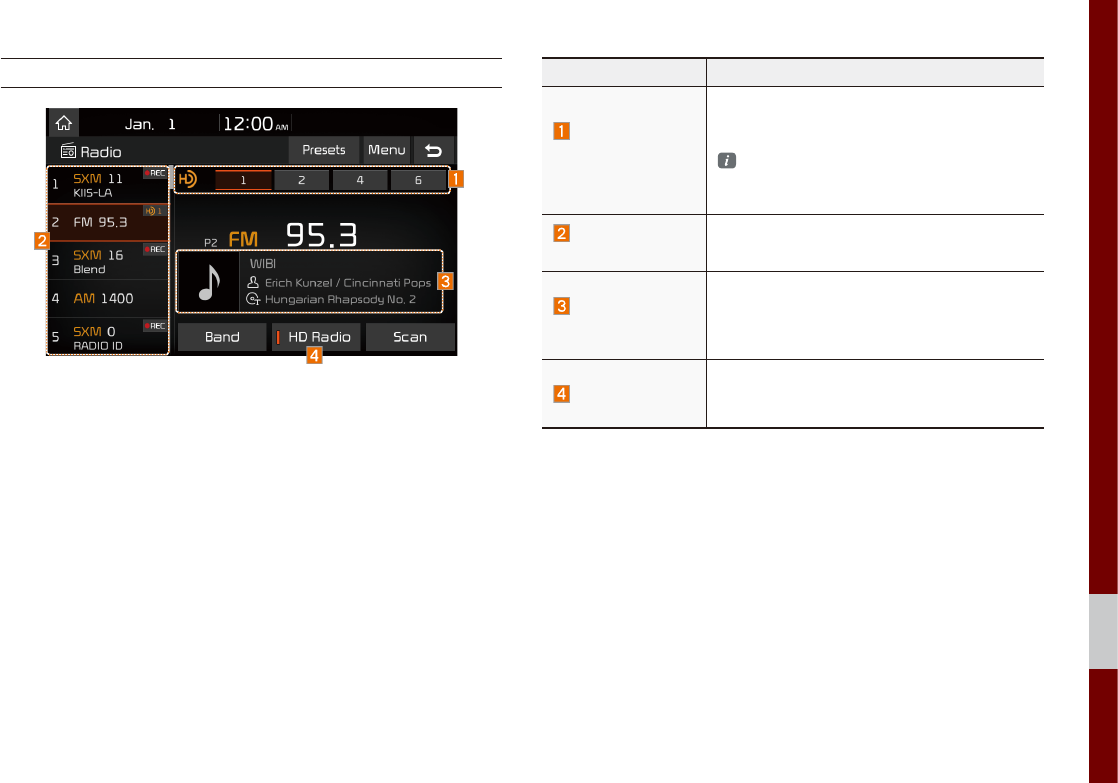
HD Radio™ Technology I 2-5
02
HD Radio™
Features Description
HD Radio™
Reception &
Channel buttons
Displays main HD Radio™ channels and
used to directly select the current available
channels.
The HD Radio™ related icon display
becomes active within regions where an
HD Radio™ signal can be received.
HD Channel
Number
Analog station and corresponding HD Radio
channel number saved in the preset list.
HD Radio
Broadcast Info
Displays detailed information about the cur-
rent broadcast (the details of the information
shown are different depending on whether
the Info button is selected)
HD Radio
When the HD Radio soft button is ON (the
red indicator on the HD Radio button is illu-
minated), HD Radio signals will be received.
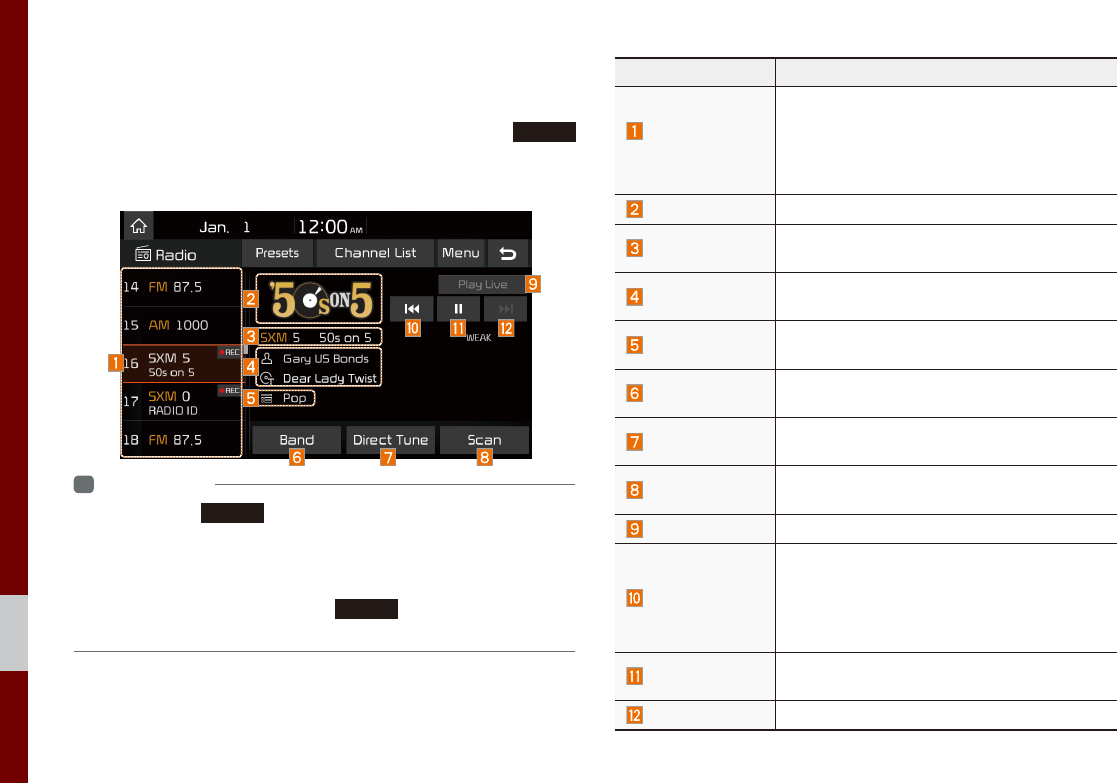
2-6 I Radio/Media
SiriusXM™
You can access the radio player either by pressing the
RADIO
key or by selecting the Radio menu option from All Menus on the
Home screen. Select the SiriusXM™ band from the radio player.
i
Information
• If you press the
RADIO
key when the power is off, the power will turn
on and a radio broadcast will be tuned from the current mode.
• If you are in the SiriusXM™ mode, select the SiriusXM™ radio widget
from the Home screen to access the radio player.
• When the power is off, pressing the
RADIO
key will turn the power on
and play a SiriusXM™ Radio broadcast.
Features Description
Preset
Frequencies
• Shows the stored presets for user selection.
• After selecting frequency, press and hold
the preset button for more than 0.8 seconds.
A beep sound will be heard and the frequency
is to be stored in the selected preset button.
Channel Logo Displays the current channel logo.
Channel Info Displays the current channel number and
name.
Content Info Displays the artist, title and other information
about the current playing song.
Category Info Displays the category of the currently playing
song.
Band Changes to the desired band from among FM,
AM, and SiriusXM™.
Direct Tune Used to search for the desired channel by
entering the channel number.
Scan Plays all receivable channels for 5 seconds
per item.
Play Live Switches to the live broadcast mode.
Skip Backward
Repeats the previously broadcasted program.
• Holding for less than 0.8 seconds: Moves to
the previous segment.
•Holding for more than 0.8 seconds: Moves
to the previous 5 seconds.
Play/Pause Pauses/plays the current broadcasting pro-
gram.
Skip Forward Moves to the next segment.
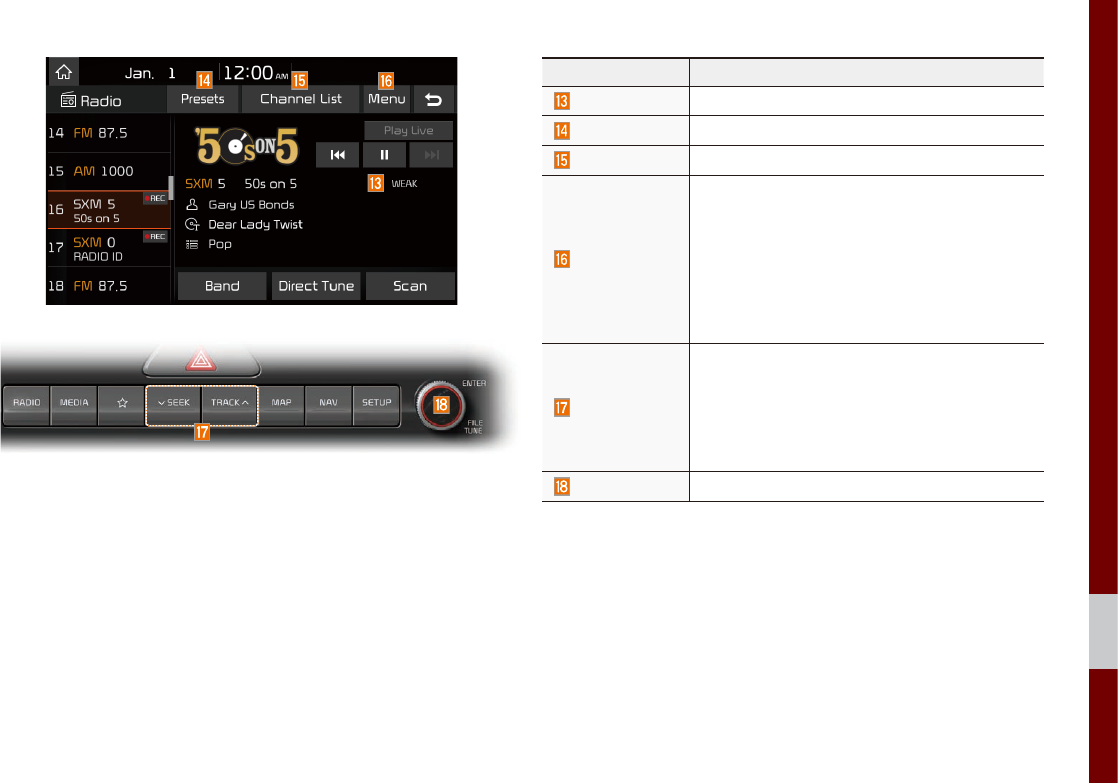
SiriusXM™ I 2-7
02
Features Description
Weak Signal Displays the weak radio reception.
Presets Shows the stored presets for user selection.
Channel List Moves to the channel list.
Menu
• What is on My Presets?
The program schedule saved in my preset.
(For more details, see Section 2.8. Viewing
Menu.)
•Featured Favorites: Theme channels recom-
mended by SiriusXM™. (For more details,
see Section 2.8. Viewing Menu.)
•Sound Settings: Moves to the Sound Settings.
SEEK/TRACK
•When pressed quickly (less than 0.8 sec-
onds): Plays the previous/next channel.
• When pressed and held (more than 0.8 sec-
onds): Continuously changes the channel
until the key is released and plays the current
channel.
TUNE Changes the channel.
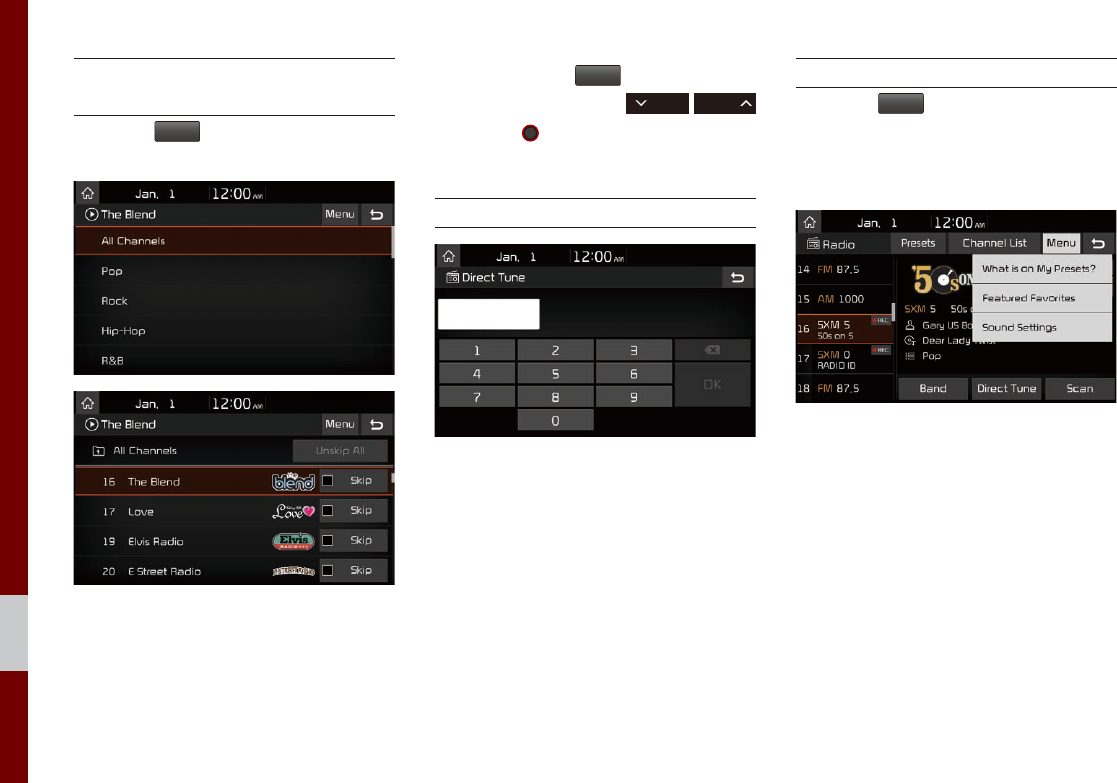
2-8 I Radio/Media
Selecting through
Channel/Category List
Select the
List
▶ Select the desired cat-
egory and channel.
Select the desired category and the chan-
nel. Once selected, the previous screen
will be restored and the selected channel
will begin playing.
If you select the
Skip
button, you can
scan channels using the
SEEK
TRACK
key or the
TUNE
knob by skipping the
channels that you chose to skip.
Direct Tune
Enter the number of the channel you want
to receive.
Viewing Menu
Using the
Menu
button on the right, you
can view the program schedule and infor-
mation about the Featured Favorites pro-
vided by SiriusXM™.
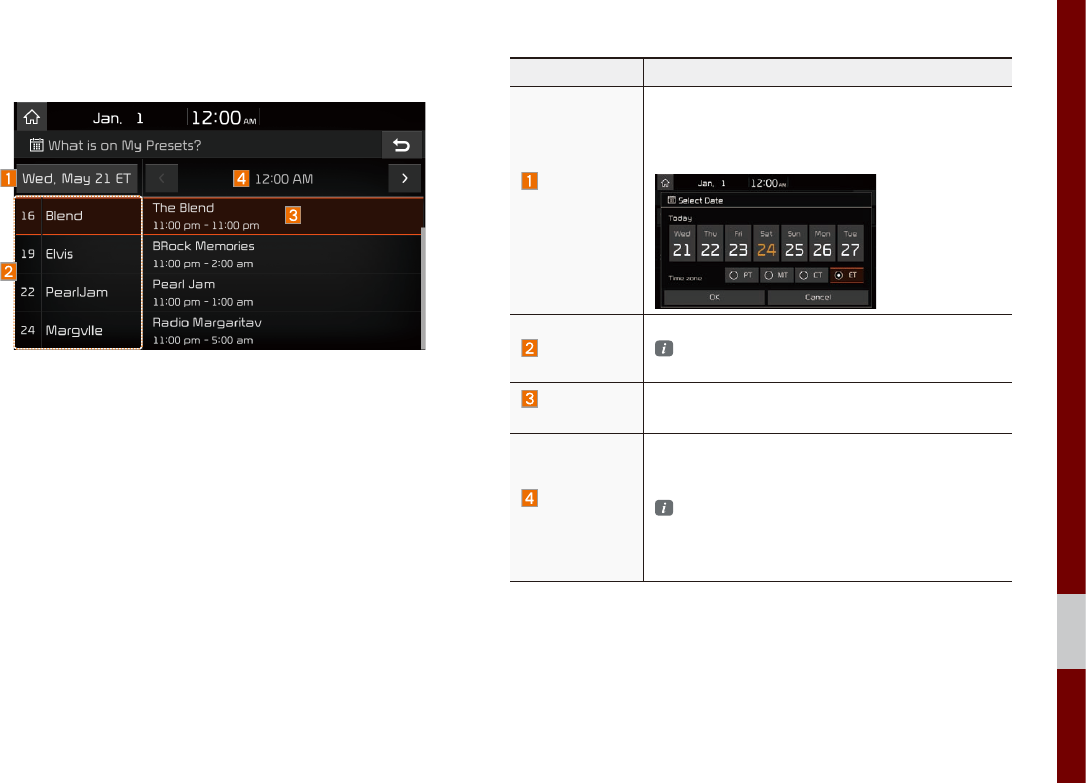
SiriusXM™ I 2-9
02
What is on My Presets? (Program Schedule)
You can select Menu to see program information and the sched-
ules of broadcast channels listed in the presets.
Name Description
Change
Broadcast
Date
By selecting this option, you can select a broad-
casting date.
Broadcast information will be provided for one
week from the current date.
Preset
Shows saved presets for user selection
A total of 40 frequencies for SiriusXM™ modes
can be displayed.
Broadcasting
Time You can select the time that you want.
Program
Information
Shows you the program titles to be broadcasted
at the time that you have chosen.
Select a program to see more details.
If there is more information on the program you
selected, an arrow button will be displayed on
the right of the list. You can see more program
information by selecting the arrow button.
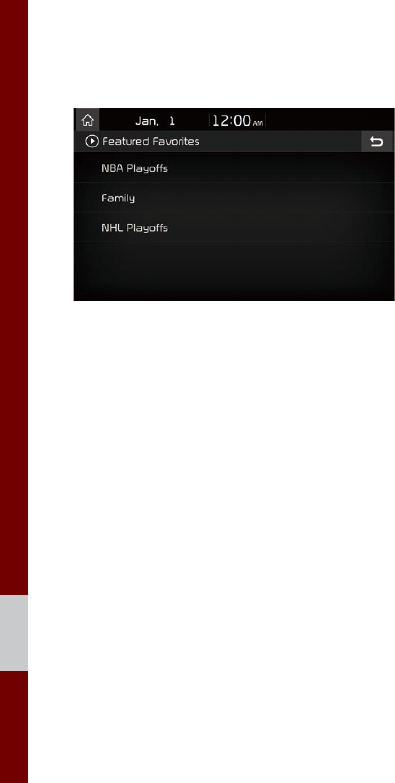
2-10 I Radio/Media
Featured Favorites
Featured Favorites feature allows
SiriusXM™ to broadcast additional presets.
•Example 1: “Martha’s Favorites” may
represent Martha Stuart’s favorites pre-
sets on her radio.
•Example 2: During holidays, “Holiday
Music” may represent all the SiriusXM™
channels that are playing the holiday
music for easy access by users.
Multiple sets Featured Favorites data
can be broadcast by SiriusXM™ and can
change from time to time.

USB I 2-11
02
USB
Before Playing a USB MP3
Connect the USB device after turning on the engine. The USB
device may become damaged if it is already connected when the
ignition is turned on.
• Files that are not standard format music files will not be played.
• For MP3/WMA/OGG files, only music files with compression
rates between 8Kbps ~ 320Kbps can be played.
• Heed caution to static electricity when connecting/disconnecting
external USB devices.
• Encoded MP3 Players will not be recognized when connected
as an external device.
• When connecting an external USB device, the device may not
properly recognize the USB is in some states.
• Only products formatted with byte/sectors under 64Kbyte will be
recognized.
• USB devices, formatted to the FAT12, FAT16, or FAT32 file sys-
tem, are recommended. File systems other than FAT12, FAT16,
FAT32, exFAT, and NTFS are not supported.
• Some USB devices may not be supported due to compatibility
issues.
• Take caution so that the USB connector does not come in con-
tact with body parts or objects.
• Repeated connecting/disconnecting of USB devices within short
periods of time may result in product malfunction.
• Make sure to connect/disconnect external USB devices with the
audio power turned off.
• The amount of time required to recognize the external USB
device may differ depending on the type, size, or file formats
stored on the USB.
• The use of USB devices for purposes other than playing music
files is prohibited.
• Do not use the USB I/F to charge batteries or USB accessories
that generate heat. Such acts may lead to worsened perfor-
mance or damage to the device.
• The device may not recognize the USB device if separately
purchased USB hubs and extension cables are being used.
Connect the USB directly with the multimedia terminal of the
vehicle.
• When using mass storage USB devices with separate logical
drives, only files saved to the root drive can be played.
• When application programs are installed to specific USBs, files
may not properly play.
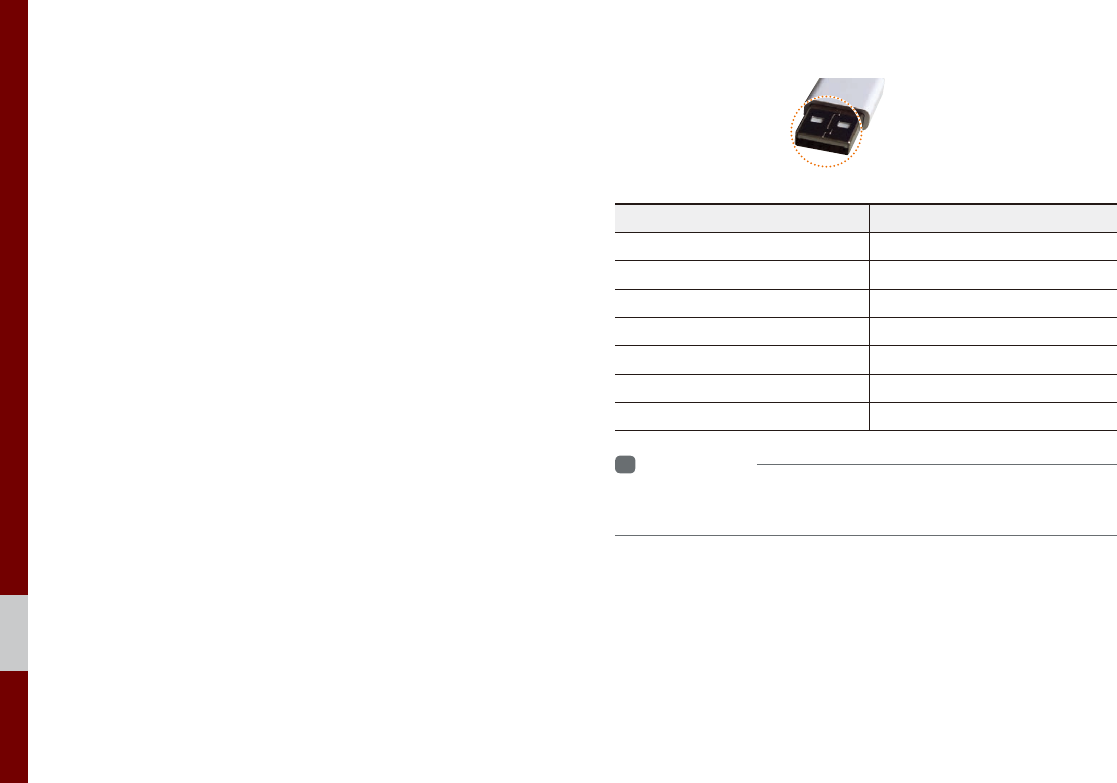
2-12 I Radio/Media
•The device may not operate normally if MP3 Players, cellu-
lar phones, digital cameras, or other electronic devices (USB
devices not recognized as portable disk drives) are connected
with the device.
•Charging through the USB may not work for some mobile
devices.
•The device may not support normal operation when using a
USB memory type besides Metal Cover Type USB Memory.
•The device may not support normal operation when using for-
mats such as HDD Type, CF, or SD Memory.
• When playing iPods, please use a dedicated iPod car cable.
• Normal operation cannot be guaranteed when other cables are
being used.
•The device will not support files locked by DRM (Digital Rights
Management).
• USB memory sticks used by connecting an Adaptor (SD Type or
CF Type) may not be properly recognized.
• Only use Plug type connector products, as shown in the figure
below.
•To play USB MP3, the USB device must be connected to the
USB port in the front multibox. The USB port in the center con-
sole storage (if equipped) is for charging only.
Product Name Manufacturer
XTICK LG
BMK BMK Technology
SKY-DRV Sky Digital
TRANSCEND JetFlash Transcend
Sandisk Cruzer SanDisk
Micro ZyRUS ZyRUS
NEXTIK Digiworks
i
Information
• Problems that occur through use of USB devices not listed within the
above table are not covered by the product warranty.
Plug Type Connector
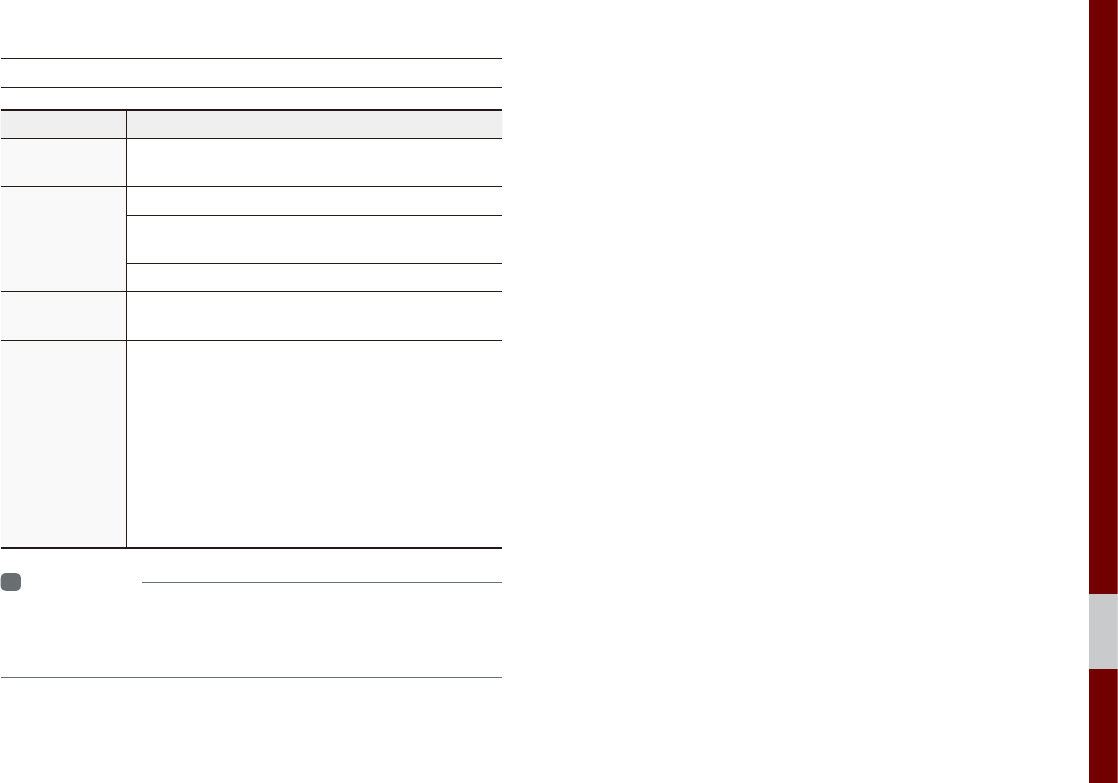
USB I 2-13
02
Supported USB MP3 music specifications
Name Description
MP3 File
Specification Specification: MPEG1 AUDIO LAYER 3
Recommended
Bit Rates and
Sampling
Frequency
Acceptable sampling frequency: 32, 44.1, 48 (kHz)
Acceptable bit rate: 32, 40, 48, 56, 64, 80, 96, 112,
128, 160, 192, 224, 256, 320 (Kbps)
96, 128, 192 Kbps fixed bit rate/44.1kHz
ID3 Tag Supports ID3v1.0 and ID3v1.1, ID3v2.2, ID3v2.3,
ID3v2.4 ID3 tags
Detailed
Specifications
Maximum directory layers: 20 layers
Maximum length of folder name/file name: 255Bytes
Supported characters for folder name/file name:
Alphanumeric characters, Korean standard charac-
ter set 2,350 characters, Simplified Chinese 4888
characters
Maximum number of folders which can be stored
onto one USB: 2000 folders (including ROOT)
Maximum number of files which can be stored onto
one USB: 8000
i
Information
• The sound quality of MP3 files that use bitrates exceeding
192 Kbps cannot be guaranteed. When using files without fixed bit rates,
some features (FF/REW features) may not properly operate.
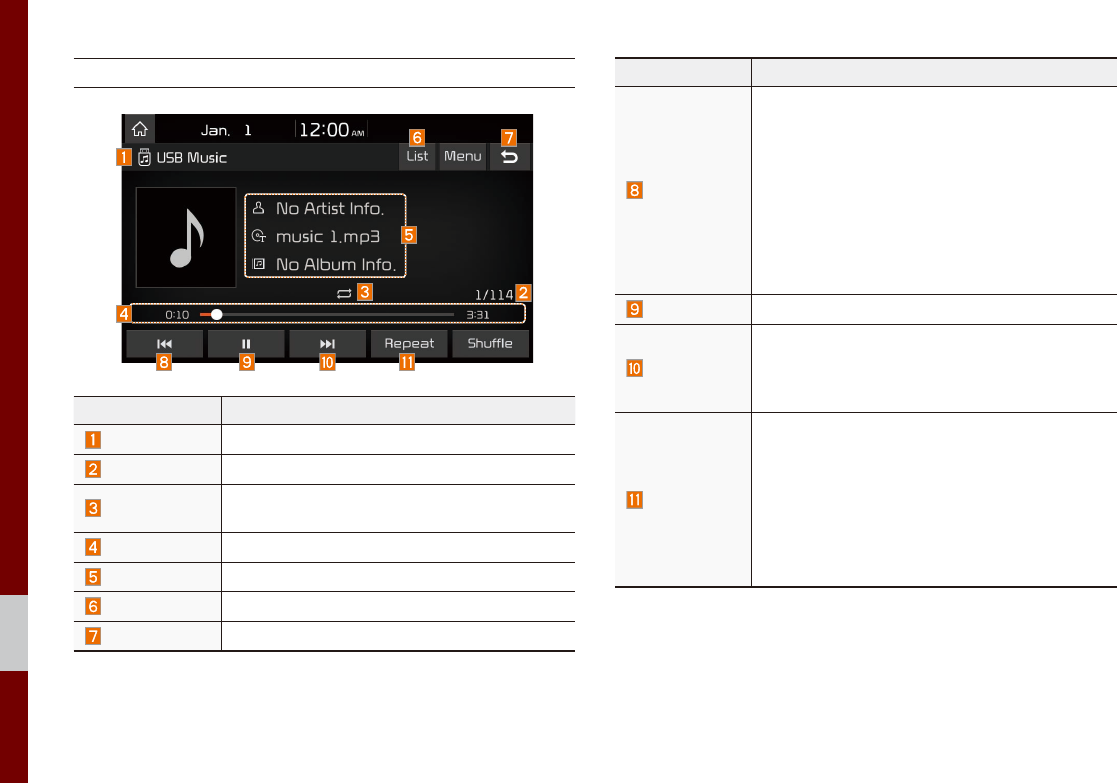
2-14 I Radio/Media
USB Music
Features Description
Mode Displays the current operating mode
File Index Shows the current file/total files within the USB
Repeat/Shuffle From Repeat/Shuffle, displays the current oper-
ating function
Play Time Displays the current play time/total play time
Song Info Displays the artist/title/album info
List Moves to the list screen
Back Button Converts to basic mode screen
Features Description
Previous File
•If button is pressed (less than 0.8 seconds):
Moves to the previous file or play the current
file from the beginning (Depends on the play
time)
- If play time is less than 3 seconds, moves to
previous file
- If play time is more than 3 seconds, play the
current file from the beginning
•If button is pressed (over 0.8 seconds) it
rewinds the track
Play/Pause Plays/pauses the current file
Next File
•If button is pressed (less than 0.8 seconds):
Moves to the next file.
•If button is pressed (over 0.8 seconds): It
fast-forwards the track.
Repeat
Repeats the current file.
• If select the file in the file tab on the list screen:
select this button to switch between repeating
the current file, repeating folder, and repeating
all files.
•If select the file in the other tabs on the list
screen: select this button to switch between
repeating the current file and repeating all files.
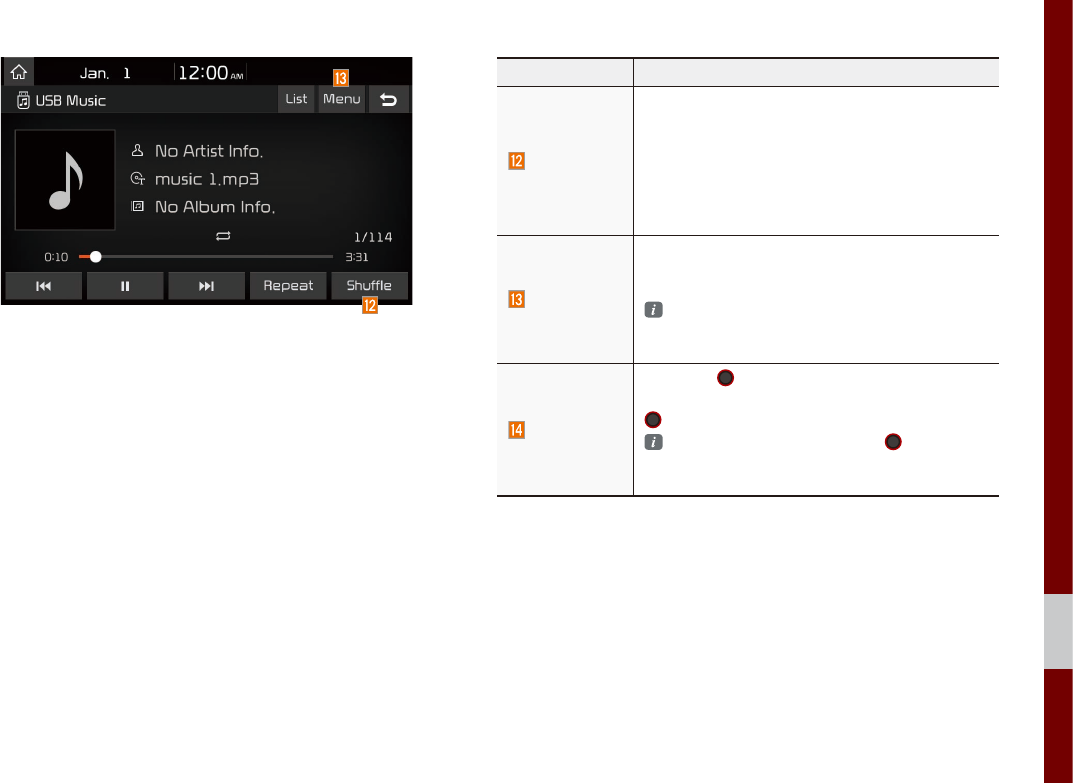
USB I 2-15
02
Features Description
Shuffle
Plays files in random order.
•If select the files in the file tab on the list
screen: select this button to switch between
shuffle folder, shuffle all, and turning off.
• If select the track in the other tabs on the list
screen: select this button to switch between shuf-
fle category and turning shuffle off.
Menu
•Hide Current File: a selected file can be
deleted. Deleted file can be found in the
“Hidden_” folder.
This function is only supported when USB for-
mat is compatible with FAT16 or FAT32.
• Sound Settings: Moves to the Sound Settings.
TUNE
Turn the
TUNE
knob to search a desired
track. If the desired track is displayed, select the
TUNE
knob to play the track.
If you do not anything with the TUNE knob
for 5 seconds of searching tracks, the track
info for the current track is restored.
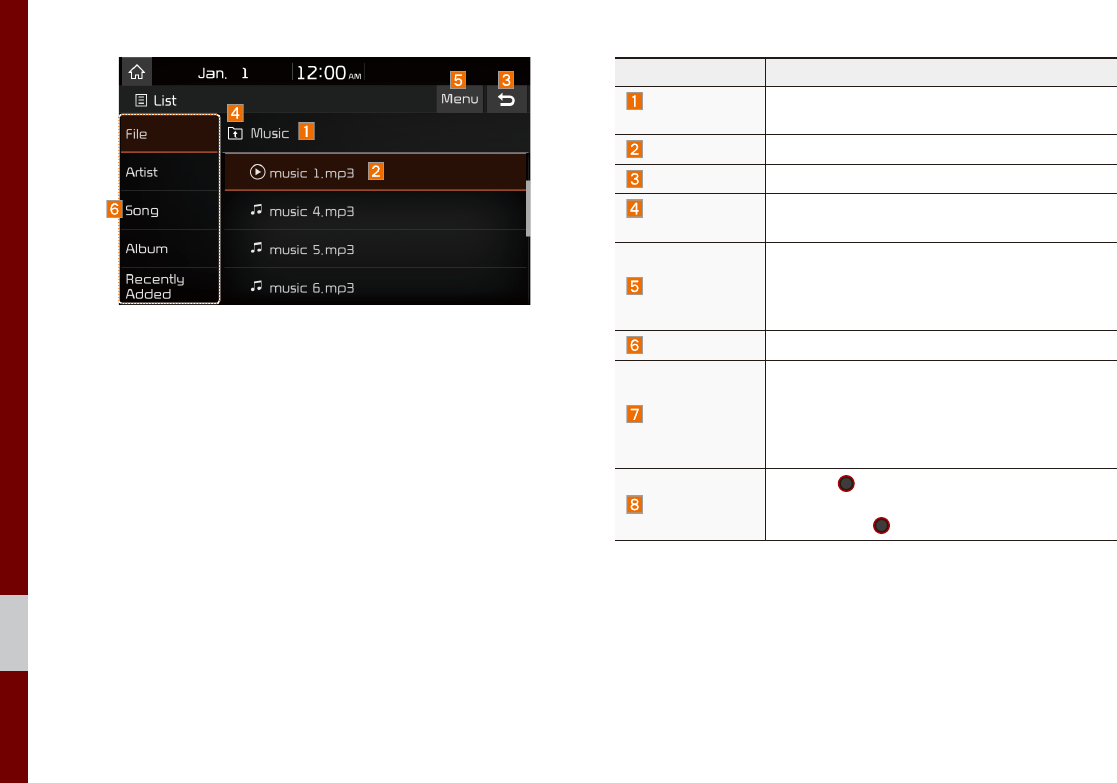
2-16 I Radio/Media
Features Description
Folder/
Category Name Displays folder/category name in the list
Current Song Displays the current playing file name
Back Button Converts to basic mode screen
Upper Folder/
Category Moves to Upper Folder/Category
Menu
Now Playing: When moving to a different list
screen, moves to the list page where the cur-
rent file is located (Becomes disabled when the
current list includes the current file)
Search Menu Search songs by the list type.
SEEK/TRACK
•If button is pressed (less than 0.8 seconds):
Plays previous/next track
•If button is pressed (over 0.8 seconds):
Moves to play screen, and then it will rewind
or fast-forward the track.
TUNE
Turn the
TUNE
knob to move the focus to the
previous/next list. If the desired track is dis-
played, press
TUNE
knob to play the track.

iPod I 2-17
02
iPod
Using iPod Devices
• iPod is a registered trademark of Apple Inc.
•iPod mode will not operate if the con-
nected iPod cannot be recognized due
to operation of unsupported versions
that do not support related protocols,
iPod abnormalities, or iPod device
defects. Some iPods with unsupported
communication protocols may not prop-
erly operate with the Multimedia system.
•For fifth generation iPod Nano devices,
the iPod may not be recognized when
the battery level is low. Please charge
the iPod for use.
•Search/play orders shown within the
iPod device may differ with the orders
shown within the Multimedia system.
•If the iPod malfunctions due to an iPod
device defect, reset the iPod and try
again. (To learn more, refer to your iPod
manual)
•If repeatedly connect and disconnect
iPod/iPhone to the Multimedia system
with USB cable in a short time, it may
cause abnormal operation.
•The time for recognition of iPod/iPhone
may vary depending on device type,
firmware version and iOS version.
•For some iPod Touch and iPhone
devices, connecting Bluetooth® while the
iPod is operating may result in discon-
tinued iPod sound. When such devices
with Bluetooth® support are connected,
this problem occurs as the sound source
is changed from the Dock Connector
(USB connector cable) to Bluetooth.
•To prevent this symptom, Bluetooth
Audio function in the Multimedia system
is limited if iPod/iPhone is connected
to the system through both cable and
Bluetooth. To listen to the iPod sound,
use either iPod menu with USB connec-
tion or Bluetooth Audio with Bluetooth
connection.
•To listen to the iPod sound, reconnect
the USB cable or change the audio out-
put settings in iPod/iPhone to Dock.
• In order to use the iPod while operating
the keys, you must use a dedicated iPod
cable. (the cable that is supplied when
purchasing iPod/ iPhone products)
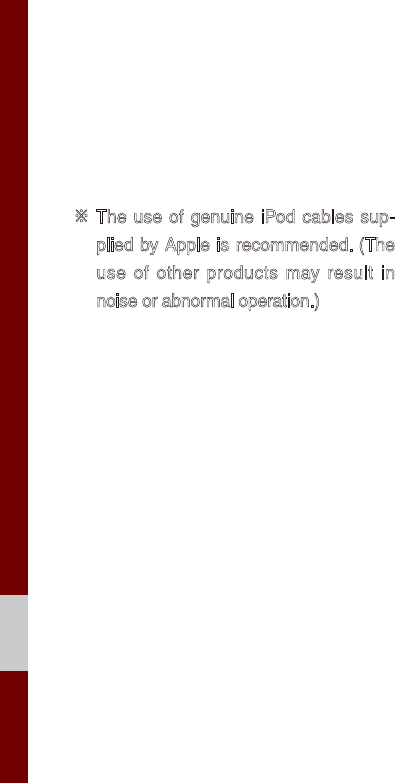
2-18 I Radio/Media
※ During ACC ON state, connecting the
iPod through the iPod cable (The cable
that is supplied when purchasing iPod/
iPhone product.) will charge the iPod
through the head unit.
※ The use of genuine iPod cables sup-
plied by Apple is recommended. (The
use of other products may result in
noise or abnormal operation.)
※ To play iPod music through cable con-
nection, the iPod/USB cable must be
connected to the USB port in the front
multibox. The USB port in the center
console storage (if equipped) is for
charging only.
• When connecting with the iPod cable,
make sure to fully insert the jack to pre-
vent communication interference. If the
iPod is connected to the vehicle while it
is playing, a high pitch tone may sound
for about 1~2 seconds immediately
after connection. If possible, connect
the iPod to the vehicle with the iPod
stopped/paused.
• Within iPhones, streaming audio and
iPod control may occasionally conflict.
If problems persist, remove the iPhone
and connect again.
• When connecting to iPod Nano/Classic,
the Kia Motor logo appears on the Apple
device. For the iPod Nano 6 genera-
tion, however, the logo image does not
appear since it is not supported. Also, all
iPhone and iPod Touch products do not
support this function.
• In Apple’s iOS 6.0 version or later,
Podcast and Audiobook media files
are designed to be played with the
Podcasts and iBooks applications spe-
cifically designed for Apple products. If
the Apple device does not provide the
Podcast and Audiobook lists, the playlist
may not be displayed and played in the
iPod mode.
• If the Apple Podcasts and iBooks apps
are not installed on the Apple device, but
the Apple device provides the Podcast
and Audiobook lists, you can play files in
other categories in iPod mode.
• The screen of multimedia system can
be different when you run other music
players (e.g. iHeartRadio) on your con-
nected device.

iPod I 2-19
02
•While using a connected iPhone/iPod
Touch device, it may not operate nor-
mally if the user changed some func-
tions in the device.
•When calling with an iPhone connec-
tion, song may stop playing due to an
Apple device feature. If sound does
not resume after the call is terminated,
check the device status.
• If lots of songs have the same informa-
tion, skipping may occur when previous/
next song is executed due to an Apple
device feature. Also problems may
occur depending on device type or iOS
version.
• If lots of songs have the same informa-
tion, it may occur difference of playing
songs between the Multimedia system
and Apple device. Reset the device or
delete the same songs in the Apple
device using iTunes.
•If you control pause, repeat, shuffle, or
seek songs when the play time is less
than 3s before the song is finished play-
ing, it may occur difference of playing
song between the Multimedia system
and Apple device. Access to iPod music
from another mode or pause a song and
then play a song again in Apple device.
•If the iPhone/iPod Touch supports
Bluetooth, the Apple device will not be
able to use the Bluetooth function if the
device is connected through both the
USB port and via Bluetooth. Disconnect
the USB connection then use Bluetooth
Audio.
•If iPod/iPhone connected to the
Multimedia system through both USB
and AUX. iPod/iPhone keeps output
sound via AUX, thus it may occur sound
will not output in iPod mode.
•If AUX cable connected to iPod/iPhone
but not connect to the Multimedia sys-
tem, it may occur sound will not output
in iPod mode due to iPod/iPhone’s fea-
ture. Especially, if you use AUX cable
like pictures, this problem may occur.
• Disconnect AUX cable from iPod/iPhone
first, then connect to the Multimedia
system via USB. Or change settings to
“Dock” in iPod/iPhone.
•If connect to the Multimedia system
while podcast or iTunes music down-
loading to iPod/iPhone, it may occur
some problems when you select song
in the list. Reconnect iPod/iPhone to the
Multimedia system when downloading
is finished or the file deleted.
•If connect to the Multimedia system
while sync, it may occur some problems.
Try to use iPod/iPhone connection after
sync complete. (To learn more, refer to
your iPod manual)
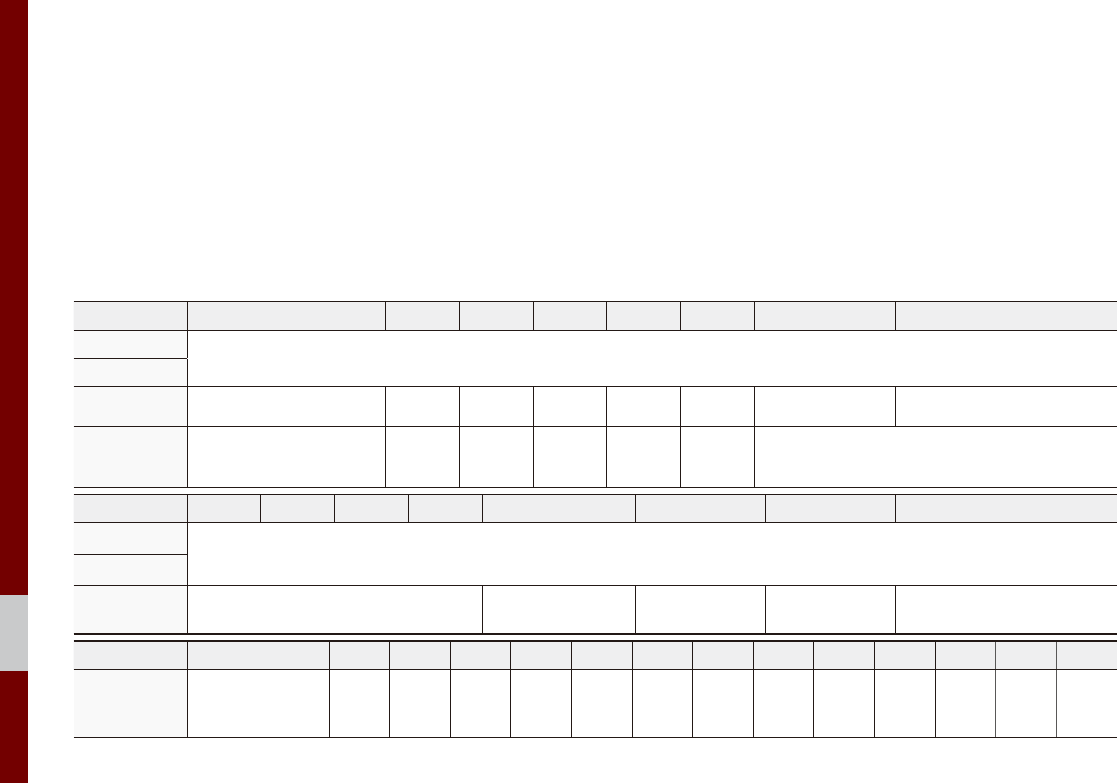
2-20 I Radio/Media
• iPhone and iPod Touch devices are
guaranteed to work normally on iOS
9.3.2 or below. However, they may not
work normally on future iOS versions
as their operations have not yet been
tested.
• We recommend that your Apple device
uses the latest firmware since some
problems may occur due to an outdated
firmware or other software related
issues.
Type 1G 2G 3G 4G 5G 6G 6.5G 7G
iPod Mini Not Supported
iPod Shuffle
iPod Nano ○ ○○○○○Not released ○
iPod Touch ○
(iOS 1.1 not supported) ○○○○○ Not released
Type 1G 2G 3G 4G 5G 6G 6.5G 7G
iPad ○ (Unable to charge, Not verified, Normal operation not guaranteed)
iPad Mini
iPod Classic Not Supported ○
(iPod with Video)
○
(iPod Classic)
○
(iPod Classic) Not released
Type 3G 3GS 44S 55C 5S 66+ 6S 6S+ SE 77+
iPhone
Not verified,
Normal operation
not guaranteed
○○○○○○○○○○○○○
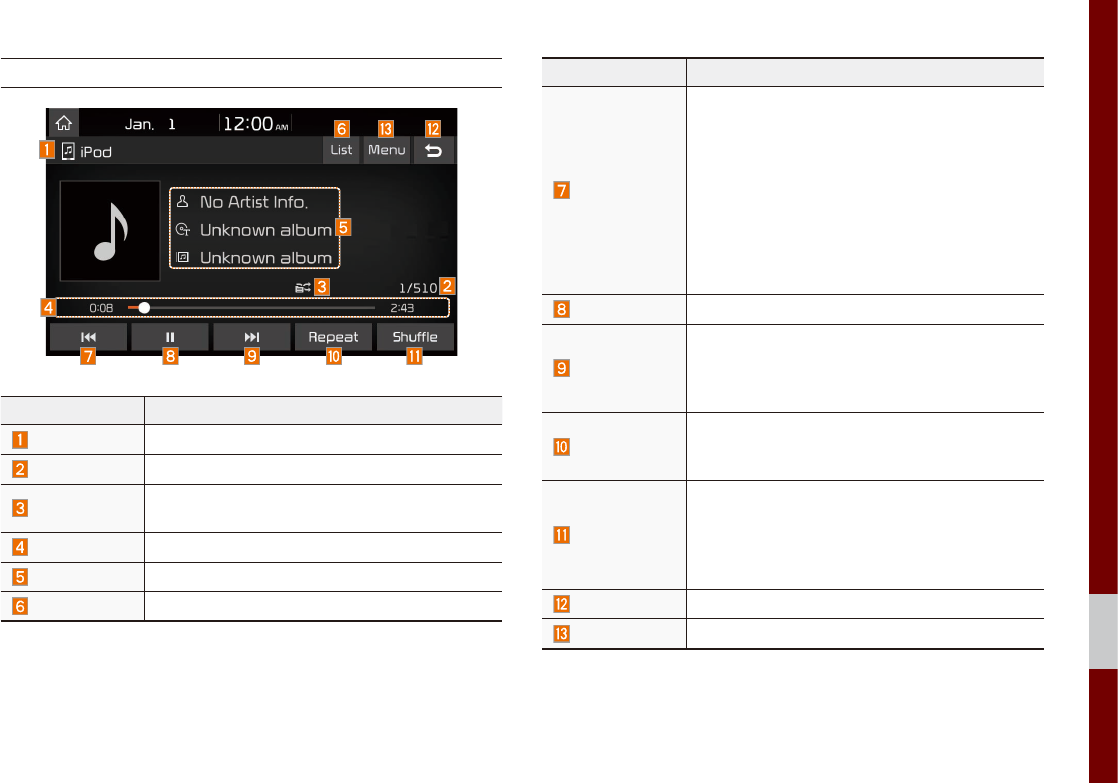
iPod I 2-21
02
iPod
Features Description
Mode Displays the current operating mode
Song Index Shows the current song/total songs
Repeat/Shuffle From Repeat/Shuffle, displays the current oper-
ating function
Play Time Displays the current play time/total play time
Song Info Displays the artist/title/album info
List Moves to the list screen
Features Description
Previous File
•If button is pressed (less than 0.8 seconds):
Moves to the previous file or play the current
file from the beginning (Depends on the play
time)
- If play time is less than 3 seconds, moves
to previous file
- If play time is more than 3 seconds, play
the current file from the beginning
•If button is pressed (over 0.8 seconds) it
rewinds the track
Play/Pause Plays/pauses the current file
Next File
•If button is pressed (less than 0.8 seconds):
Moves to the next file.
•If button is pressed (over 0.8 seconds): It
fast-forwards the track.
Repeat
Repeats the current song.
Select this button to switch between repeating
the current song and repeating all songs.
Shuffle
Plays songs in random order.
Select this button to switch between shuffle cat-
egory and turning shuffle off.
•Shuffle Category: shuffle song in the current
category.
Back Button Move to home/previous mode screen
Menu Sound Settings: Moves to the Sound Settings.
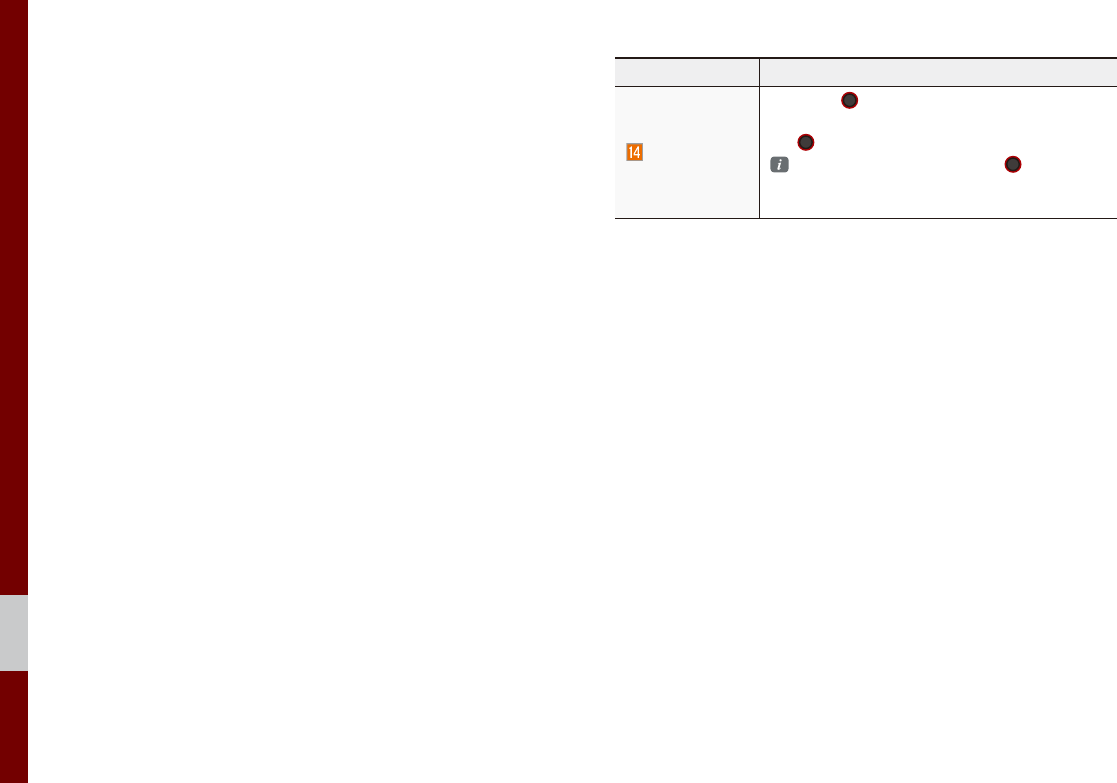
2-22 I Radio/Media
Features Description
TUNE
Turn the
TUNE
knob to search a desired
track. If the desired track is displayed, press
the
TUNE
knob to play the track.
If you do not anything with the TUNE knob
for 5 seconds of searching tracks, the track
info for the current track is restored.
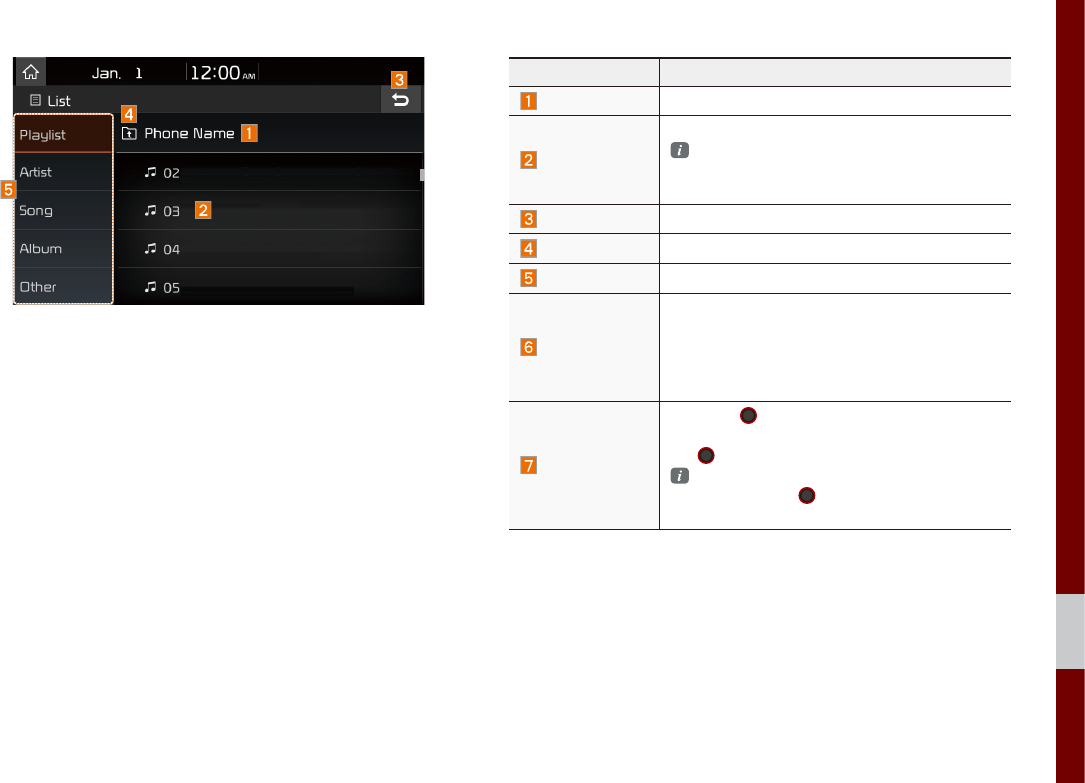
iPod I 2-23
02
Features Description
Category Name Displays the category name
Category List
Displays the contents of selected category
If there are many items in the list, items are
added in order and the scroll bar on the right
is adjusted accordingly.
Back Button Converts to basic mode screen
Upper Category Moves to Upper Category
Search Menu Search songs by the list type.
SEEK/TRACK
•If button is pressed (less than 0.8 seconds):
Plays previous/next track
•If button is pressed (over 0.8 seconds):
Moves to play screen, and then it will rewind
or fast-forward the track.
TUNE
Turn the
TUNE
knob to search a desired
track. If the desired track is displayed, press
the
TUNE
knob to play the track.
If you do not anything with the knob for
5 seconds, the
TUNE
knob search will be
terminated.
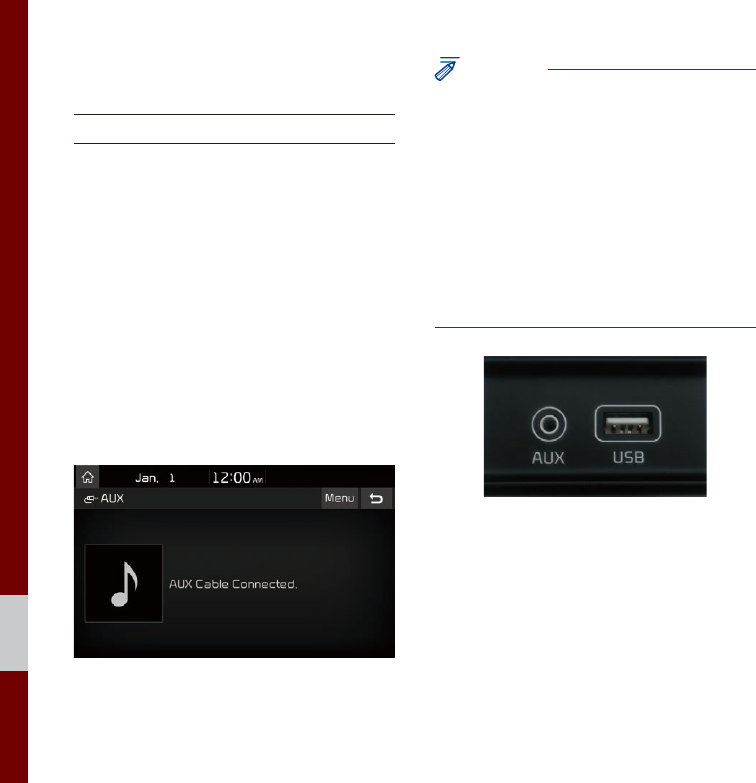
2-24 I Radio/Media
AUX
Connecting an External Device
If an external device connector is con-
nected with the AUX terminal, then AUX
mode will automatically operate. Once the
connector is disconnected, the previous
mode will be restored.
•AUX mode can be used only when an
external audio player has been con-
nected.
• The AUX volume can also be controlled
separately through the connected
device.
NOTICE
•If only a cable is connected to the AUX
without an external device, the mode will
be changed to AUX, but noise may occur.
When an external device is not being
used, remove the connector jack.
•When the external device power is
connected to the power jack, playing the
external device may output noise. In such
cases, disconnect the power connection
before use.
※ The actual image in the vehicle may
differ from the illustration.
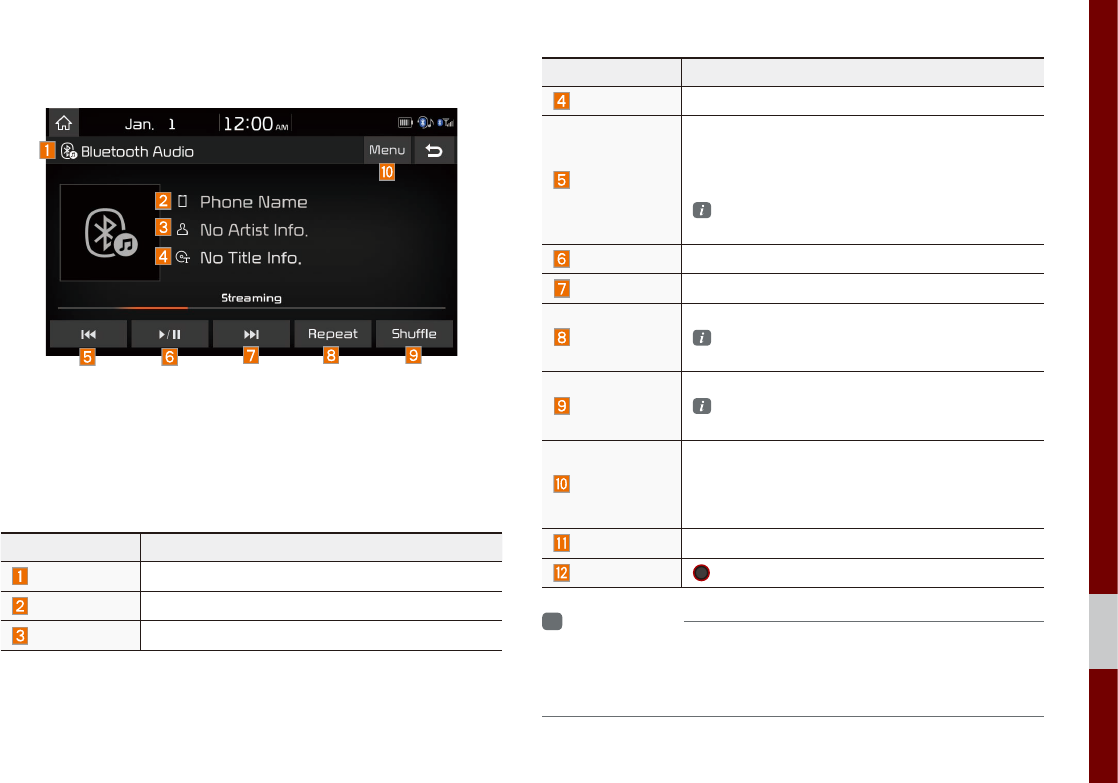
02
Bluetooth® Audio I 2-25
Bluetooth
®
Audio
Features Description
Mode Displays the current operating mode
Phone Name Displays name of connected phone
Artist Info Name of current artist
Features Description
Title Name of current song
Previous File
•If play time is less than 3 seconds, moves to
the previous file
• If play time is more than 3 seconds, plays the
current file from the beginning
This function may differ depending on the
model of mobile phone.
Play/Pause Plays/Pauses Bluetooth Audio
Next File Moves to the next file
Repeat
Repeats the current file.
This function may differ depending on the
model of mobile phone.
Shuffle
Plays files in random order.
This function may differ depending on the
model of mobile phone.
Menu
• Connections: Moves to the Bluetooth Settings
screen. You can pair a new device or change/
delete paired device(s).
• Sound Settings: Moves to the Sound Settings.
SEEK/TRACK Plays the previous/next file
TUNE
TUNE
is not supported
i
Information
• Artist info and Title may not be supported by mobile phone.
• While in use of other functions after connecting your mobile phone
through a USB cable, the Bluetooth audio is disabled.
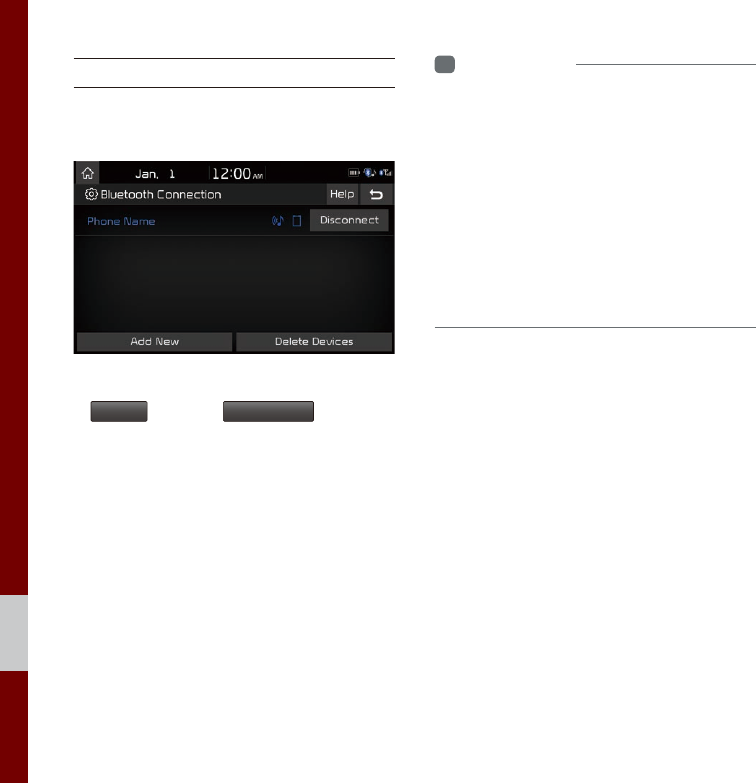
2-26 I Radio/Media
Bluetooth Connection Settings
Settings for pairing, connection and dis-
connection of a Bluetooth device.
•In Bluetooth Audio play screen, select
Menu
and then
Connections
.
i
Information
•If the music in the mobile phone is not
played after changing to audio streaming
mode, press the play button. Thus check if
the music is playing in the Bluetooth device
after changing to audio streaming mode.
Audio streaming may not be supported for
some mobile phones.
•Please check the Bluetooth compatibility
in below website: KIA Motors Corporation
http://www.kia.com

Before Using the Bluetooth® Handsfree
Bluetooth Connection
Bluetooth Phone
part.3 Bluetooth

3-2 I Bluetooth
Before Using the
Bluetooth
®
Handsfree
What is
Bluetooth
®
Wireless Technology?
•
Bluetooth
® Wireless Technology refers
to a short-distance wireless network-
ing technology which uses a 2.45GHz
frequency to connect various devices
within a certain distance.
• Supported within PCs, external devices,
Bluetooth® phones, PDAs, various elec-
tronic devices, and automotive environ-
ments,
Bluetooth®
Wireless Technology
to be transmitted at high speeds without
having to use a connector cable.
• Bluetooth® Handsfree refers to a device
which allows the user to conveniently
make phone calls with Bluetooth®
mobile phones through the Multimedia
system.
• The Bluetooth® Handsfree feature may
not be supported in some mobile phones.
For more information on mobile phone
compatibility, visit the KIA Motor website
- KIA Motors Corporation: http://www.kia.com
WARNING
- Distracted Driving
• Focus on the road while driving. The driver's
primary responsibility is in the safe and legal
operation of the vehicle. Drivers should not
use any hand held devices or other equipment
or vehicle systems that distract the driver
during vehicle operation.
• Do not stare at the multimedia screen for long
periods of time while driving. Staring at the
screen for prolonged periods of time can lead
to traffic accidents and can result in personal
injuries.
Precautions for Safe Driving
• Bluetooth® is a feature that enables driv-
ers to make handsfree calls. Connecting
the head unit with a Bluetooth® phone
allows the user to conveniently make
calls, receive calls, and manage the
phonebook. Before using
Bluetooth®
Wireless Technology, carefully read the
contents of this user’s manual.
•Excessive use or operations while driv-
ing may lead to negligent driving prac-
tices and be the cause of accidents. Do
not operate the device excessively while
driving.
•Viewing the screen for prolonged peri-
ods of time is dangerous and may lead
to accidents. When driving, view the
screen only for short periods of time.
Bluetooth

03
Before Using the Bluetooth® Handsfree I 3-3
CAUTIONS upon Connecting
Bluetooth® Phone
• Before connecting the head unit with the
mobile phone, check to see that the mobile
phone supports Bluetooth® features.
• Even if the phone supports
Bluetooth®
Wireless Technology, the phone will
not be found during device searches if
the phone has been set to hidden state
or the Bluetooth® power is turned off.
Disable the hidden state or turn on the
Bluetooth® power prior to searching/
connecting with the head unit.
• If Auto Connection is used, the
Bluetooth® phone is automatically con-
nected when the ignition is turned on,
making it unnecessary to have to con-
nect the phone with the head unit every
time.
• If you do not want automatic connection
with your Bluetooth® device, turn the
Bluetooth® feature off of the Bluetooth®
device.
• Park the vehicle when connecting the
head unit with the mobile phone.
• Bluetooth® connection may become
intermittently disconnected in some
mobile phones. Follow these steps to try
again.
1. Turn the Bluetooth® function within the
mobile phone OFF/ON and try again.
2. Turn the mobile phone power OFF/
ON and try again.
3. Completely remove the mobile phone
battery, reboot, and then again.
4. Reboot the Multimedia System and
try again.
5. Delete all paired devices from both of
Phone and Head Unit sides and then
try again.
• The Handsfree call volume and quality
may differ depending on the mobile
phone.
• Pairing Bluetooth® devices and use of
other Bluetooth® features are not sup-
ported when the vehicle is in motion. For
safety, please first park your vehicle.
• If you continue having issue download-
ing your contacts to your vehicle, con-
tact your mobile phone provider.
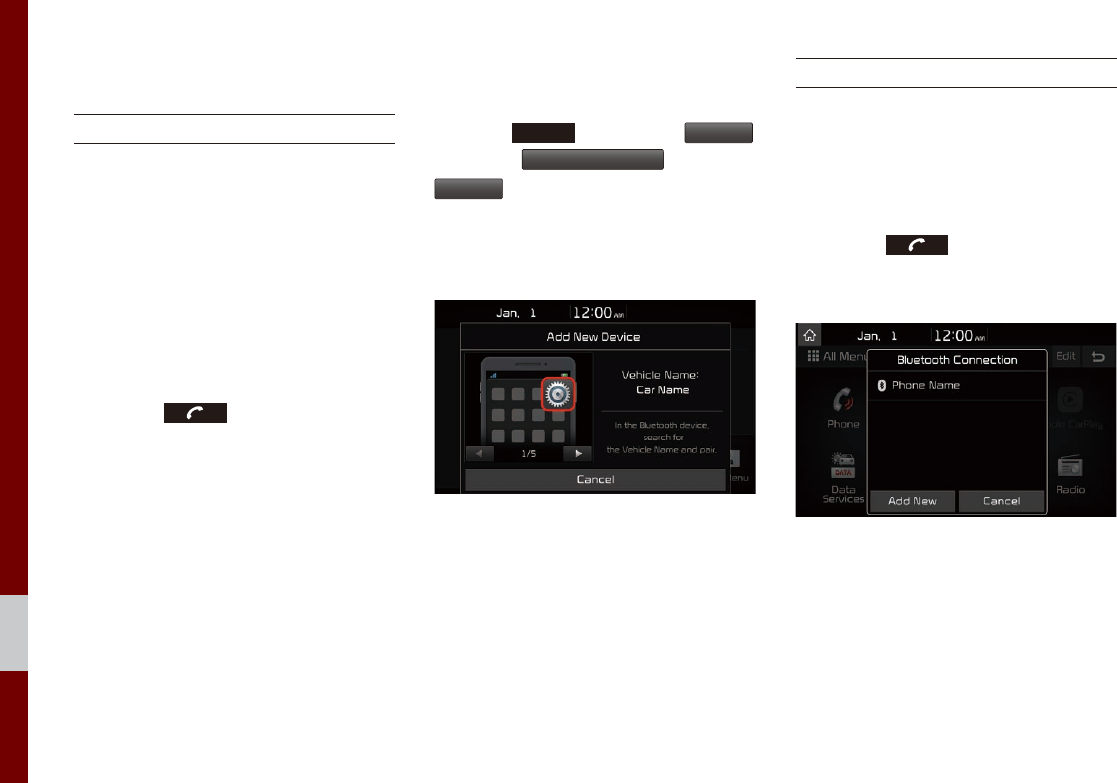
3-4 I Bluetooth
Bluetooth Connection
Pairing a New Device
Before you can use the Bluetooth feature,
you must first pair/connect your mobile
phone to your car.
Up to 5 Bluetooth devices can be paired.
Only one Bluetooth device can be con-
nected at a time.
Pairing a New Device by Selecting
Phone/Call
Press the key in the steering
wheel control. ▶ Pair your car after your
mobile phone detects the Bluetooth
device. ▶ Enter the passkey or accept the
authorization popup. ▶ Connect Bluetooth.
Pairing a New Device Through the
Phone Settings
Press the
SETUP
key. ▶ Select
Bluetooth
.
▶Select
Bluetooth Connection
. ▶ Select
Add New
. ▶ Pair your car after your mobile
phone detects the Bluetooth device. ▶
Enter the passkey or accept the authoriza-
tion popup. ▶ Connect Bluetooth.
The default passkey is 0000.
The vehicle name above is an example.
Check the actual information on the product.
Connecting Bluetooth Devices
Connects the Bluetooth devices that you
add.
Connecting Devices by Selecting
Phone/Call
Press the key in the steering
wheel control. ▶ Select the name of the
device to connect. ▶ Connect Bluetooth.
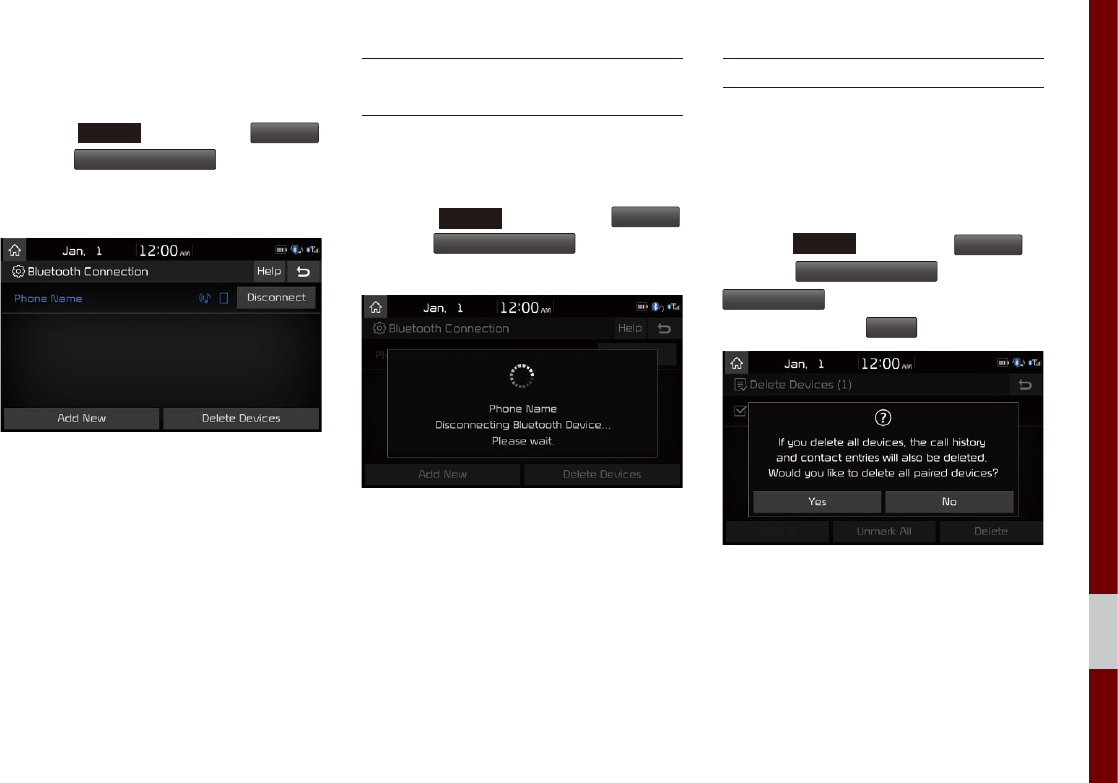
Bluetooth Connection I 3-5
03
Connecting Devices Through the
Phone Settings
Press the
SETUP
key. ▶ Select
Bluetooth
.
▶ Select
Bluetooth Connection
. ▶ Select the
name of the device to connect. ▶ Connect
Bluetooth.
Disconnecting
Bluetooth Devices
Disconnects Bluetooth devices that are
connected.
Press the
SETUP
key. ▶ Select
Bluetooth
.
▶ Select
Bluetooth Connection
. ▶ Select the
name of the device to disconnect.
Deleting Bluetooth Devices
Deletes the Bluetooth devices that you
added. Note that deleting a Bluetooth
device will delete all Call History and
Contact Info downloaded along with it.
Press the
SETUP
key. ▶ Select
Bluetooth
. ▶
Select
Bluetooth Connection
. ▶ Select
Delete Devices
. ▶ Select the device name
to delete. ▶ Select
Delete
.
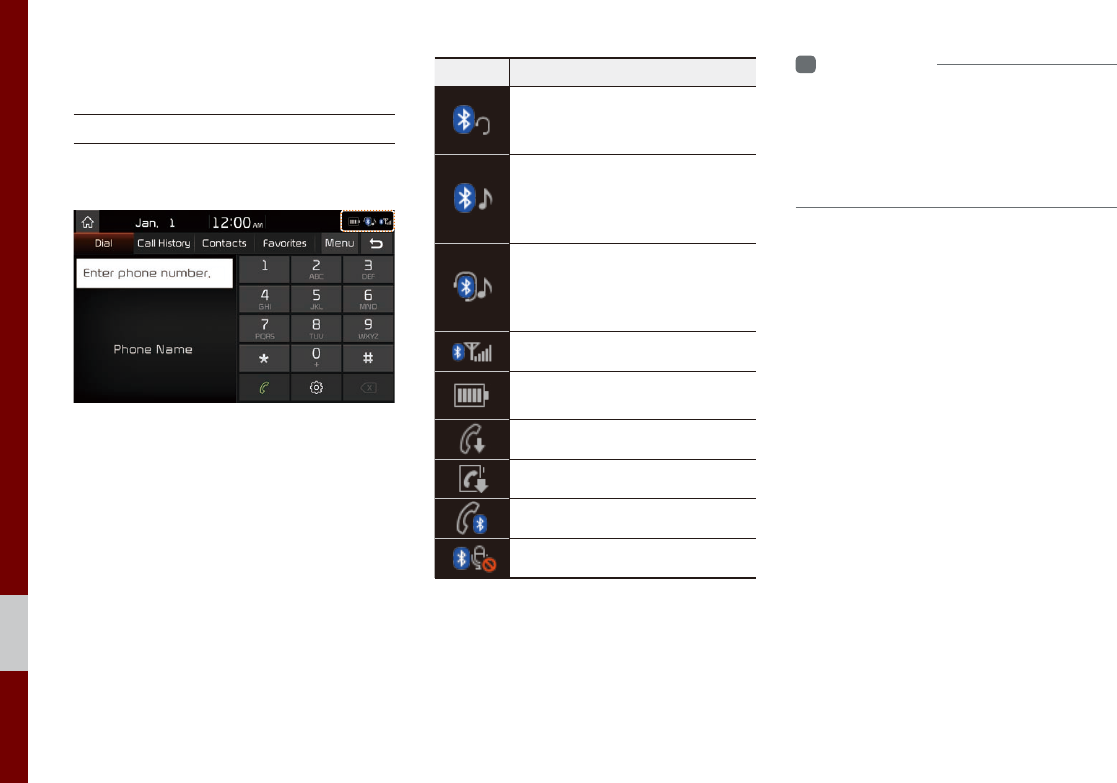
3-6 I Bluetooth
Bluetooth Phone
Phone Status Icons
Shows the current phone status in the
right top of the display.
Icons Description
You can use Bluetooth phones
when a Bluetooth Hands-free
connection is established.
You can use Bluetooth audio
features when a Bluetooth
audio connection is estab-
lished.
You can use Bluetooth phones
and audio features when both
Bluetooth Hands-free and audio
connections are established.
Call signal strength indicator
Battery level of the Bluetooth
devices connected
Downloading Call History list
Downloading Contacts
In a Bluetooth phone call
Microphone muted
i
Information
• The battery level icon and the call signal
strength indicator may not be supported in
some Bluetooth devices.
• The battery level may differ from the actual
level remaining.
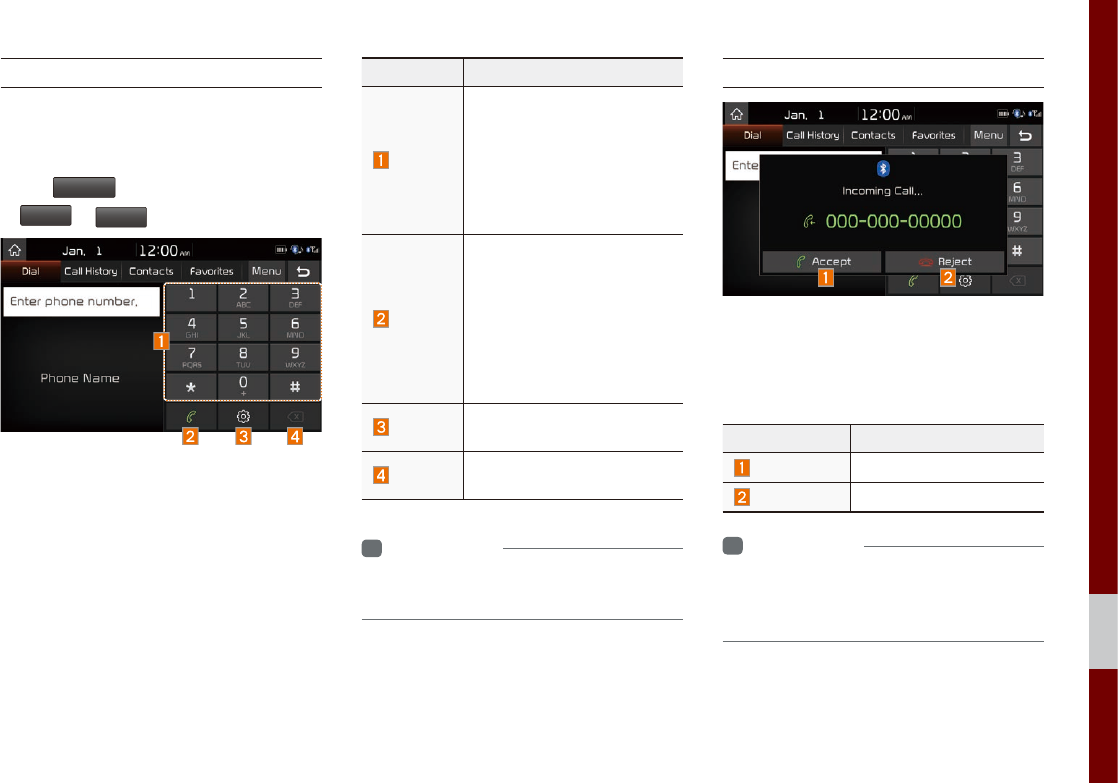
Bluetooth Phone I 3-7
03
Dial
Dials a call after the Bluetooth devices are
connected.
Select
All Menus
from Home Screen display
▶
Phone
▶
Dial
.
Name Description
Keypad
Use the keypad to enter
the phone number that you
want to call. Select and
hold the last number of a
speed dial to dial a num-
ber that you added to the
Speed Dial list in the phone
Call
Makes a call after you dial
a number and select this
button. If the number is
listed in Dialed Calls, you
can select the number and
select this button to auto-
matically dial that number
again.
Settings Moves to a screen of
Bluetooth Connection.
Delete Deletes the numbers that
you entered.
i
Information
• Some types of mobile phones may not
support the Speed Dial function.
Accept/Reject Call
If there is an incoming call after you made
a Bluetooth connection, a popup message
will appear.
Name Description
Accept Answers the call.
Reject Ignores the call.
i
Information
• In some mobile phones, the caller's number
may not be displayed, and the Reject feature
may not be supported.
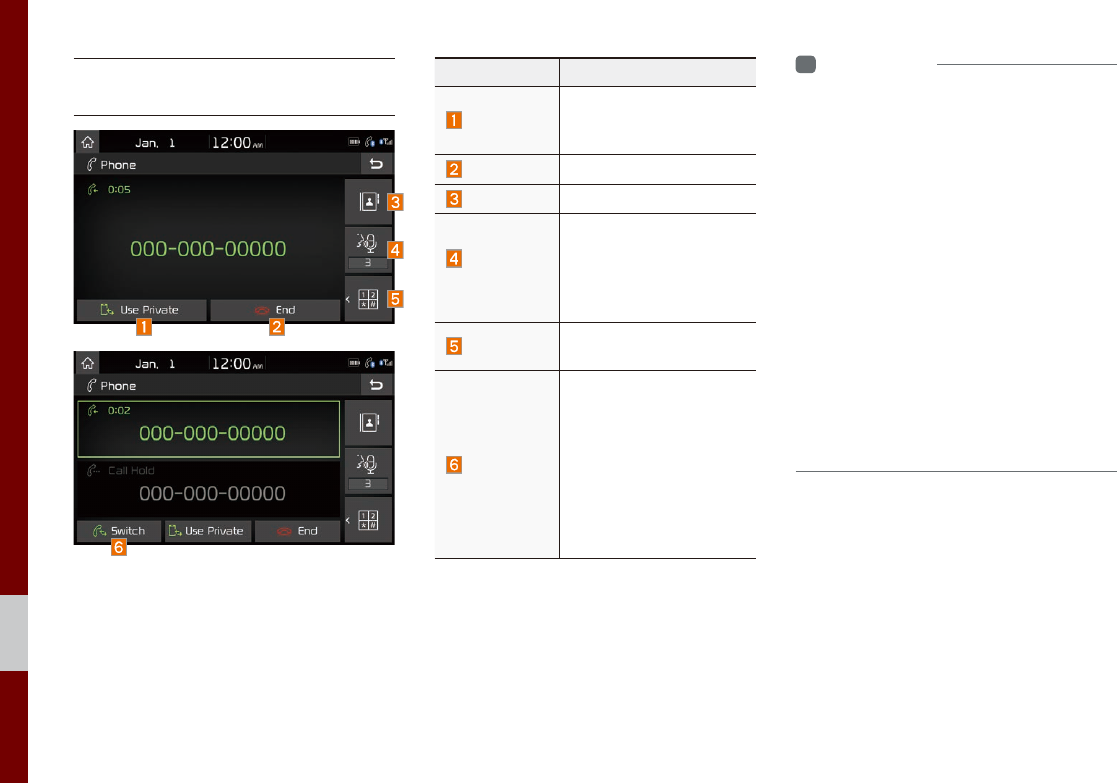
3-8 I Bluetooth
Using the Menu During
a Phone Call
When making a call, you can use the fol-
lowing menu items.
Name Description
Use Private
Switches a voice call
from the car Hands-free
to the mobile phone.
End Ends a call.
Contacts Displays the Contacts list.
Outgoing
Volume
Displays the Mic Volume
settings. You can adjust
the in-call volume that
the other party hears
(level 1 - 5).
Keypad Moves to a screen for
entering ARS numbers.
Switch
Switches to a call on
hold, if any. You can also
switch calls by select-
ing the number in the
Information Display. The
Switch function switches
the current call to a wait-
ing call in order to answer
a new incoming call.
i
Information
• If the caller's number is listed in Contacts, the
caller's name will be displayed. Otherwise,
only the number will be displayed. In some
mobile phones, the phone number may not
be displayed.
• In some Bluetooth devices, the Use Private
feature may not be supported.
• In some Bluetooth devices, the Switch feature
may not be supported.
• During a phone call on a Bluetooth Hands-
free, you cannot access other modes, such as
Radio and Settings.
• Depending on handset types, the in-call
volume the other party hears may differ. If the
other party hears your voice too low or too
loud, adjust the mic volume.
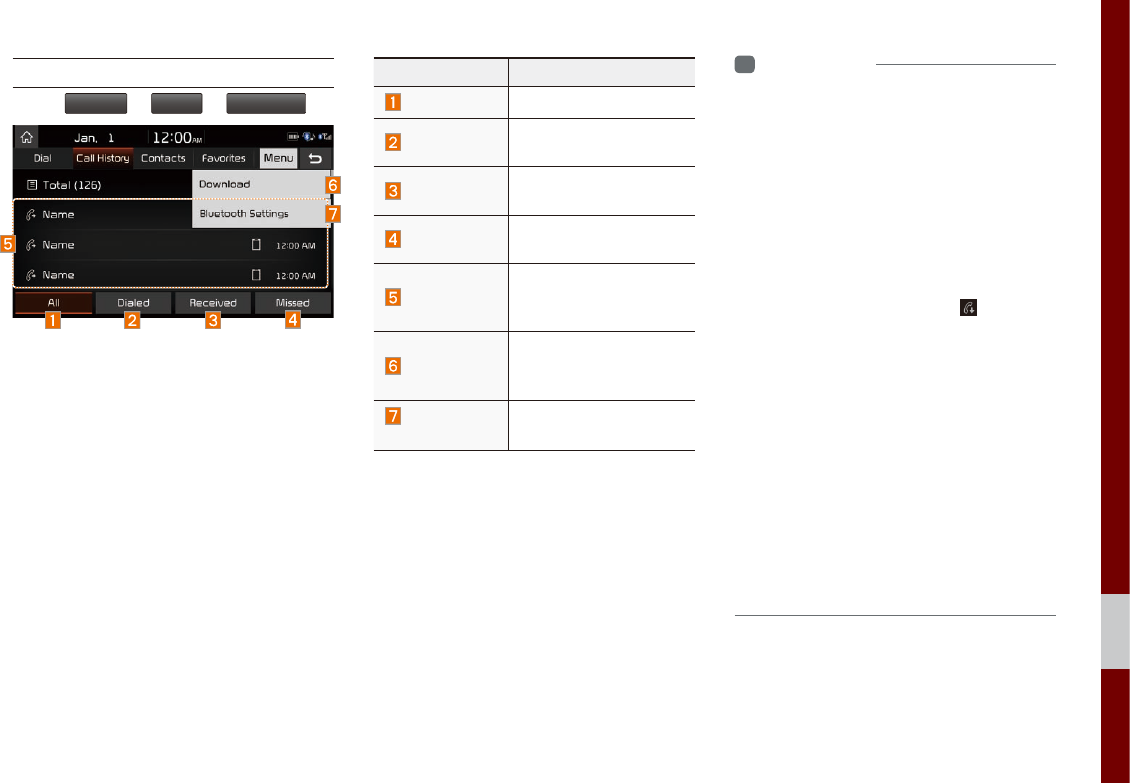
Bluetooth Phone I 3-9
03
Call History
Select
All Menus
▶
Phone
▶
Call History
.
Name Description
All Lists the all call history.
Dialed Lists the calls that you
made.
Received Lists the calls that you
have received.
Missed Lists the calls you
missed.
Call History
Displays all of your call
history. Select from the
list to dial the number.
Download
Downloads the call
history information from
your mobile phone.
Bluetooth
Settings
Moves to a screen of
Bluetooth Settings.
i
Information
• In some mobile phones, call records may not
be added to your Call History.
• Calls from restricted ID's are not added to
your Call History Information.
• Up to 50 calls can be added in each Dialed
Calls/Received Calls/Missed Calls list.
• The durations of each dialed/received call are
not displayed in your car's Call History list.
• While the call history download is in progress,
the status bar displays an icon ( ).
• If the call history download is turned off on the
Bluetooth device, the call history download
will fail.
• Some devices require a device authentication
for downloading your call history. If download
fails, check if the Bluetooth Settings or display
status are normal.
• Some devices do not support call history
download. Check if your Bluetooth device
supports download feature. For details regarding
Bluetooth-supported devices and their functional
compatibility, visit http://www. kia.com
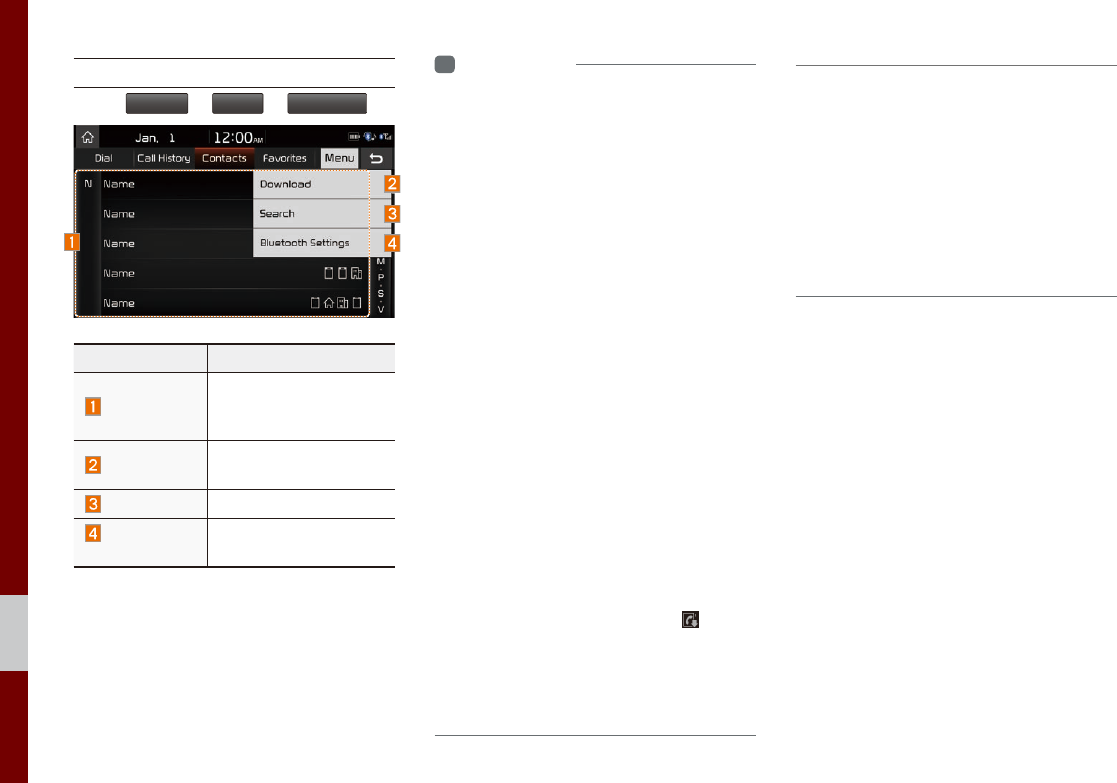
3-10 I Bluetooth
Contacts
Select
All Menus
▶
Phone
▶
Contacts
.
Name Description
Contacts List
The list of Contacts.
Select from the list to
dial the number.
Download Downloads contacts
from your mobile phone.
Search Searches Contacts.
Bluetooth
Settings
Moves to a screen of
Bluetooth Settings.
i
Information
• Up to 5000 phone numbers can be
downloaded from a single, paired Bluetooth
device.
• You cannot edit or delete downloaded phone
numbers from your car.
• Contacts can be viewed only when the
Bluetooth device is connected.
• Even if the Bluetooth device is disconnected,
the downloaded data will remain. (Note that
deleting a paired phone will also delete all
downloaded Contacts and Call History data)
• Downloaded phone numbers may be lost
depending on the condition of the Multimedia
system. Keep your important data in a safe
place.
• Contacts from both the SIM card and your
mobile phone are downloaded at the same
time by default.
• Only supported contacts format can be
downloaded and displayed from the Bluetooth
device, contacts from some applications will
not be included.
• The status bar displays a ( ) while
downloading contacts.
• The download will not be available if the
contacts download function is turned off on
your Bluetooth device.
• Some devices require a device authentication
for downloading your contacts. If download
fails, check your phone screen and confirm
the download if necessary.
• Some devices do not support contacts
download feature. Check if your Bluetooth
device supports contacts download. For
Bluetooth supporting devices details and
compatibility, visit http://www.kia.com
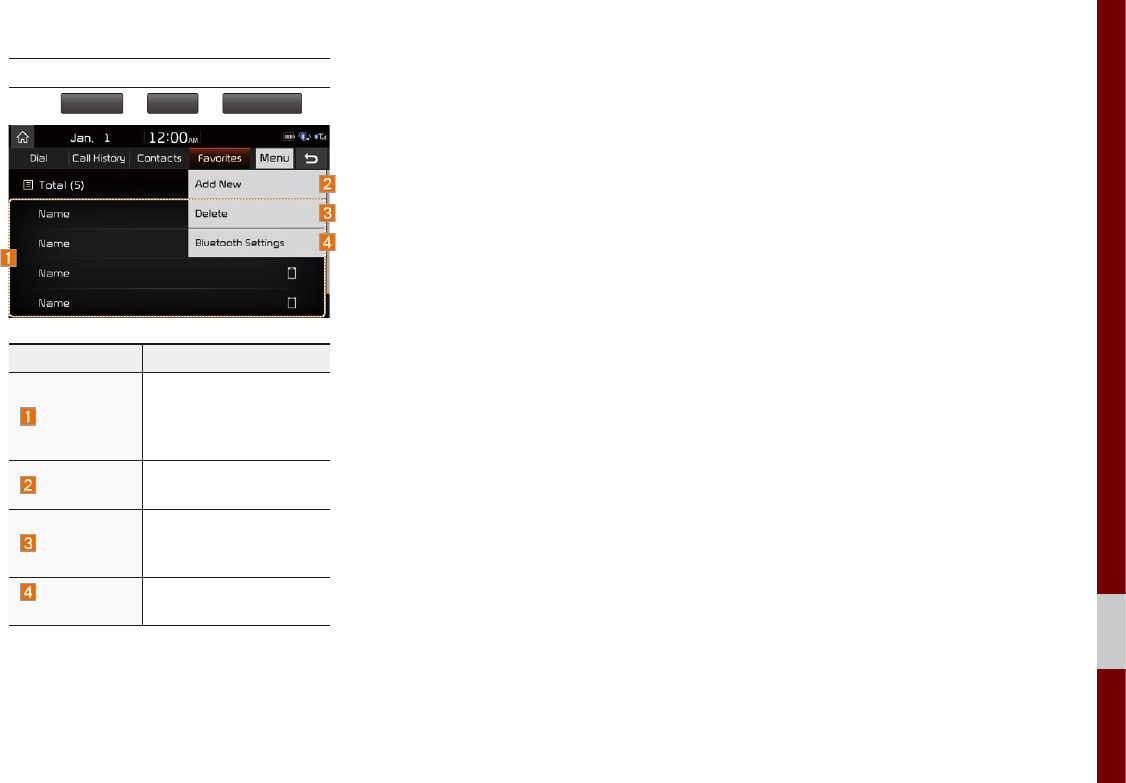
Bluetooth Phone I 3-11
03
Favorites
Select
All Menus
▶
Phone
▶
Favorites
.
Name Description
Favorites
Lists the phone num-
bers saved as Favorites.
Select from the list to
dial the number.
Add New Adds a new number to
Favorites.
Delete
Deletes numbers
that you select from
Favorites.
Bluetooth
Settings
Moves to a screen of
Bluetooth Settings.

MEMO

The 911 Connect feature may not operate in the following situations
About UVO eServices
Before using UVO eServices
Connecting Bluetooth
Pair a device from Bluetooth-enabled phone
Connecting to smartphone via USB
911 Connect
Roadside Assist
Vehicle Diagnostics
My Car Zone
Parking Minder
My POIs
eServices Guide
part.4 UVO eServices

4-2 I UVO eServices
UVO eServices
The 911 Connect feature may not
operate in the following situations
When the vehicle ignition is not turned on.
When the phone Bluetooth® feature is set to off.
When the phone Bluetooth® cannot be connected or becomes
disconnected.
When there are no phones paired with the vehicle.
When cellular service is unavailable.
When the power turns off due to phone power (battery) issues.
When a Bluetooth® device without phone feature support has
been connected, such as an MP3 device.
When the system is booting.
When the system power supply is unstable.
When the attempted call is blocked due to user operations.
When the 9-1-1 call is unstable due to phone or other commu-
nication network issues.
When the call feature is not operating due to phone settings set
by the user.
When the phone cannot be controlled via Bluetooth® due to
phone specifications or characteristics.
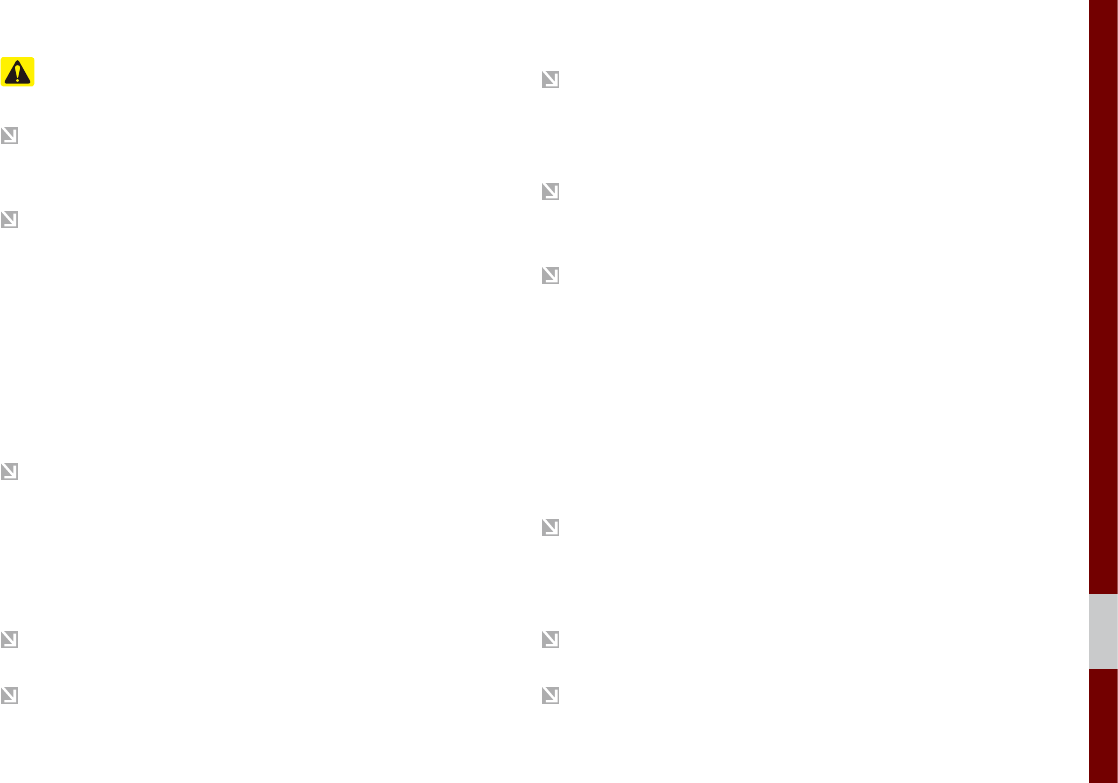
Using UVO eServices and Precautions I 4-3
04
Using UVO eServices and Precautions
Download the UVO eServices App and install it on your smartphone.
The app can be downloaded from your smartphone’s app store.
For using UVO eServices call features such as 911 Connect,
Roadside Assist and eServices Guide, a smartphone must be
connected with the vehicle via Bluetooth. Pair and connect your
smartphone with the vehicle. For information on connecting
your Bluetooth device, refer to the smartphone user’s manual
and instructions on the Phone Help screen on your radio. Up to
five Bluetooth devices can be paired to the vehicle and only
one device can be connected at a time.
For using data communication of Vehicle Diagnostics, Parking
Minder, and My Car Zone, smartphone must be connected with
the vehicle via USB cable.
※
The use of genuine cable is recommended. (The use of
other products may result in abnormal or non-proper operation.)
Login and activate the UVO eServices App on your smartphone.
Some UVO eServices features will only be available when your
smartphone is connected with the vehicle via USB and the
UVO eServices App is running.
UVO eServices may not operate properly with incompatible
smartphones. To view the list of compatible smartphones,
please visit MyUVO.com
Communication between the vehicle and smartphone app may
temporarily disconnect depending on the phone state.
If the feature is not operating properly, you may need to reset
the UVO eServices App or the smartphone and try again
according to the following steps.
1. Try feature again in the Head Unit
2. Restart smartphone app
3. Re-connect Bluetooth and USB cable
4. Reset smartphone
5. Delete Device and pair again
Some services use the customer’s mobile phone data plan for
data communication. Therefore, the features will function in
accordance with the cellular plan.
Use of the most up-to-date app version is recommended.
For smartphone related inquiries, please visit MyUVO.com.
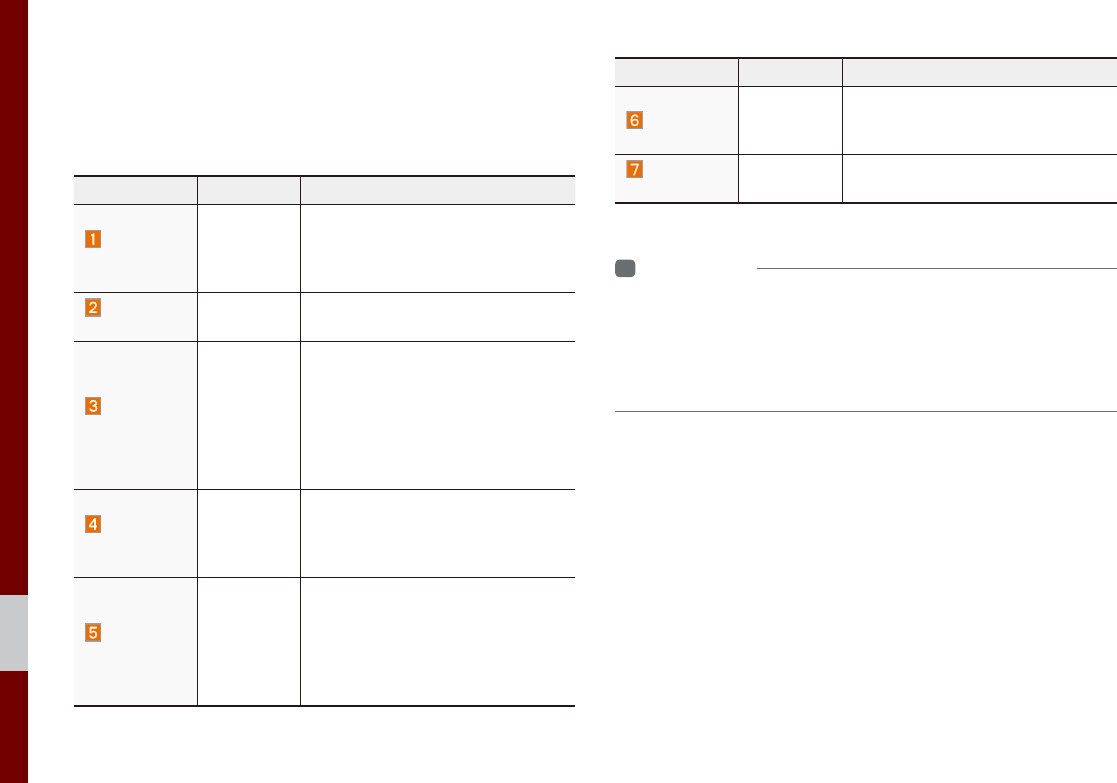
4-4 I UVO eServices
About UVO eServices
UVO eServices provides the following features through Bluetooth
and/or USB connection to your smartphone.
Name Connection Description
911
Connect BT & USB
If an airbag deploys, your vehicle
automatically initiates a call to 9-1-1
and sends your vehicle’s location
information to the 9-1-1 operator.
Roadside
Assist BT & USB If a diagnostic issue exists, you can
connect with a Roadside Assist.
Vehicle
Diagnostics USB
Informs you if there is a diagnostic
issue found in your vehicle. If an
issue is found, you can contact a
call center through Roadside Assist
or reserve an appointment with
your preferred Kia dealer through
Schedule Service.
My Car
Zone USB
Keeps track of predefined triggered
alerts such as Speed Alert and
Curfew Limit Alert from the My Car
Zone feature.
Parking
Minder USB
Saves the location of your parked
vehicle on your UVO eServices
smartphone app.
You can check where your vehicle is
parked through the UVO eServices
App on your smartphone.
Name Connection Description
My POIs USB
Downloads Points of Interest to your
multimedia system from Google
Maps and MyUVO.com
eServices
Guide BT & USB Receive guidance on how to use
UVO eServices.
i
Information
• 24-hour Roadside Assistance is a
service plan provided by Kia Motors
America, Inc. Certain limitations apply. Coverage details are available
in the Kia Warranty and Consumer Information Manual. For access
to Enhanced Roadside Assistance, a conn
ected mobile phone via
Bluetooth within the cellular service coverage area is required.
To use UVO eServices, the following conditions must be met.
1. The UVO eServices smartphone app must be installed and
you must log in using your MyUVO account credentials.
2. The smartphone must be connected via Bluetooth and USB
cable to the vehicle.
3. Once this is complete, eServices must be activated.
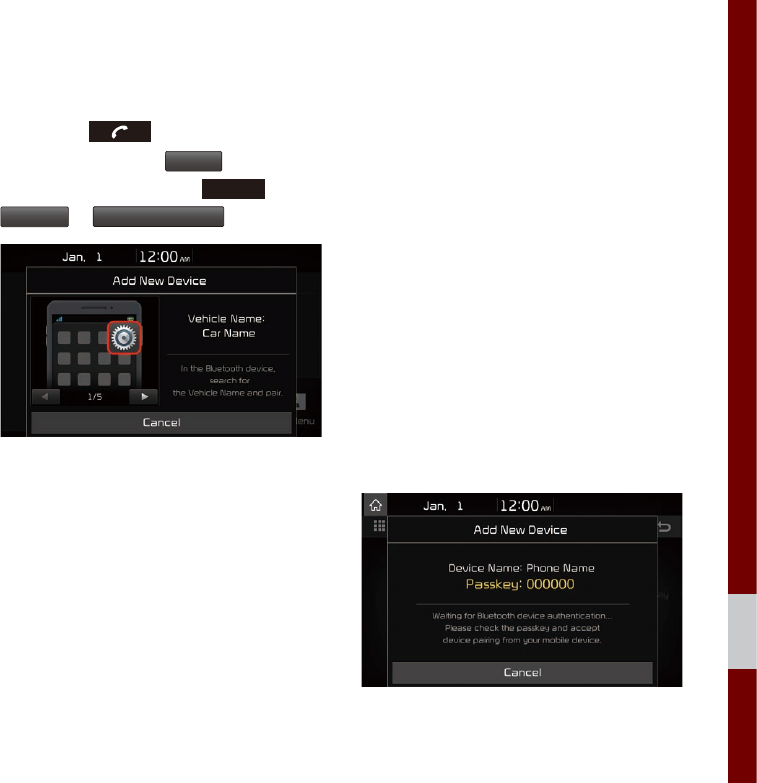
Pair a device from Bluetooth-enabled phone I 4-5
04
Before using UVO
eServices
Installing the UVO eServices App on your
smartphone
1. Download and install the UVO eSer-
vices App on your smartphone.
The app can be downloaded from the
Apple App Store or Google Play.
2. Register your vehicle and account at
MyUVO.com
Note: MyUVO.com is accessible from
your phone’s browser.
3. Start the UVO eServices App on your
smartphone and log in.
Connecting Bluetooth
Press the key on the steering
wheel or select the
Phone
icon on the
Home screen. Press
SETUP
key▶
Bluetooth
▶
Bluetooth Connection
.
Pair a device from
Bluetooth-enabled phone
1. Turn on the Bluetooth feature on your
smartphone’s Bluetooth Settings screen.
2. Search Bluetooth devices on your
smartphone.
3. Select the Vehicle Name on the phone
that matches the name shown on the
screen.
4. Verify the passkey shown on the touch-
screen.
If the phone supports SSP, check the
passkey on your Bluetooth® device and
confirm the authentication.
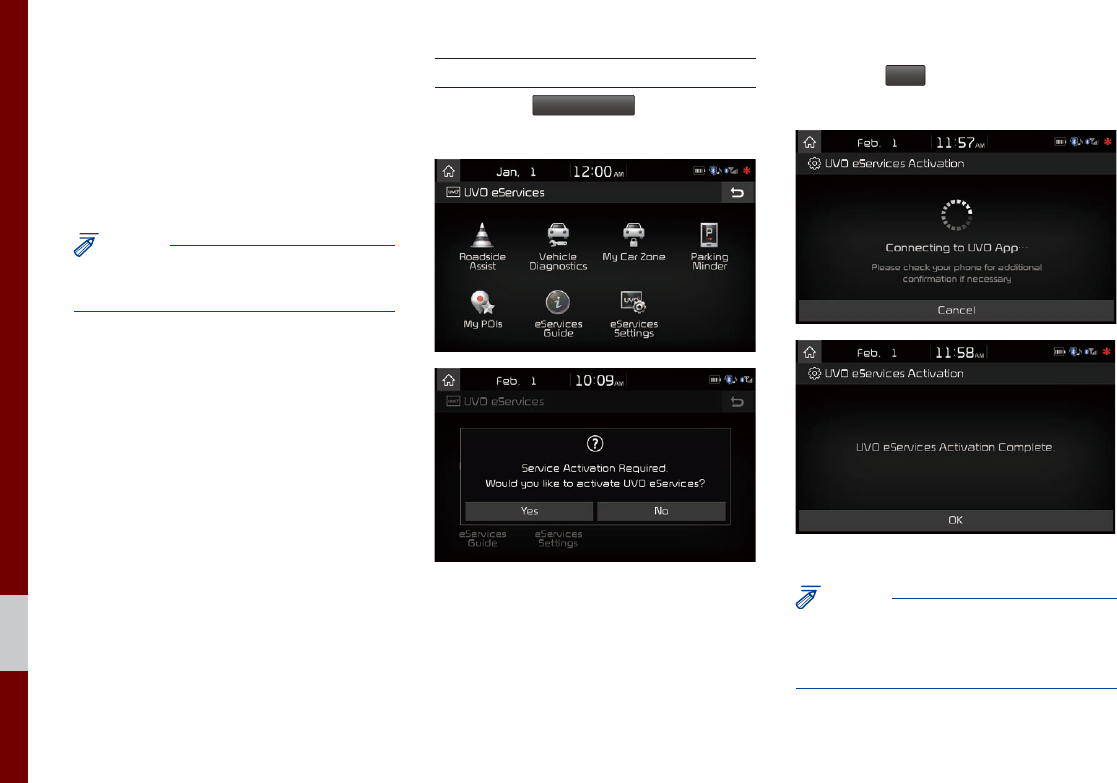
4-6 I UVO eServices
Connecting to
smartphone via USB
1. Connect your smartphone with the vehi-
cle via USB cable.
NOTICE
• For smartphone related inquiries, please visit
MyUVO.com.
Activating UVO eServices
Select the
UVO eServices
icon from All
Menus on the Home screen.
Press the
Yes
button, then the UVO
eServices activation process will begin.
NOTICE
• Before activating UVO eServices, ensure
your phone is connected to the vehicle via
USB cable.
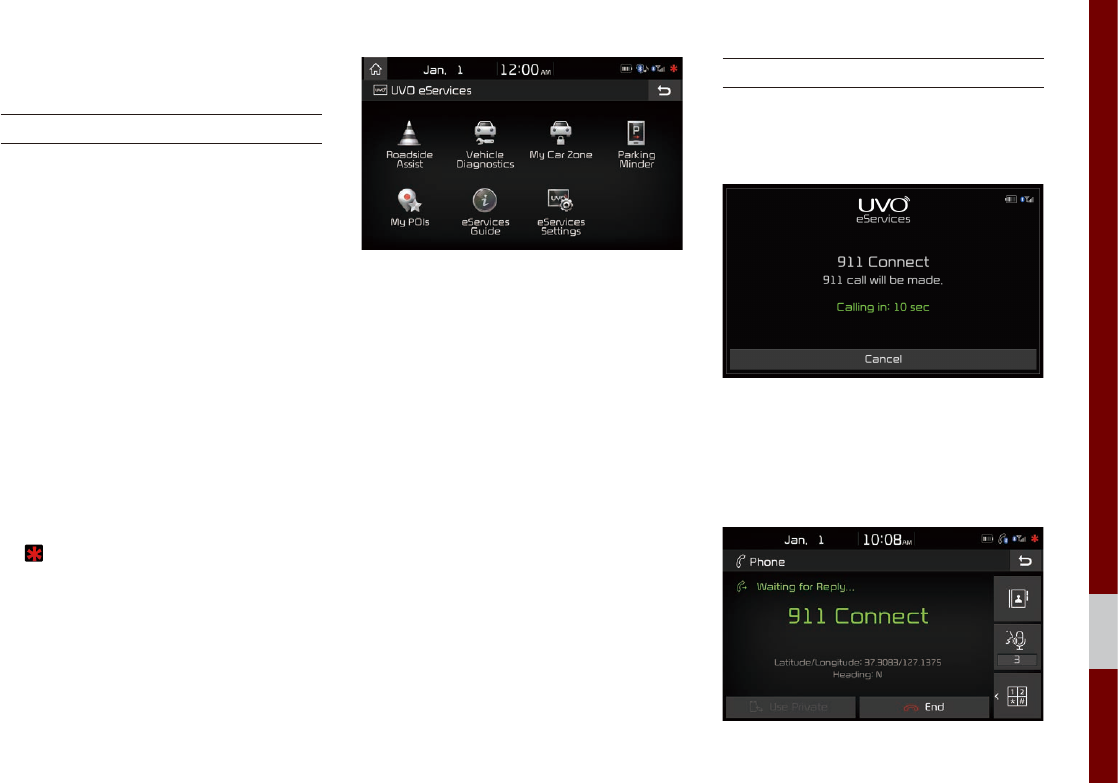
911 Connect I 4-7
04
911 Connect
911 Connect
If an airbag deploys, your vehicle automat-
ically initiates a call to 9-1-1 and sends
your vehicle’s location information to the
9-1-1 operator.
The 911 Connect feature is available only
when the mobile phone is connected via
Bluetooth.
By default, this feature is turned off. To turn
it on, you must turn it on in the eServices
Settings menu. By enabling this feature,
you are agreeing to the 911 Connect
terms of use.
A ( ) icon is displayed at the top of the
touch screen as shown below when phone
is connected to UVO eServices system via
Bluetooth and the 911 connect feature is
turned on.
Initiating a 911 Call
If an airbag deploys, the following screen
is displayed and a call is automatically
placed to 9-1-1 after 10 seconds.
Once a call is connected with a 9-1-1
operator, it is possible to request emer-
gency services to be dispatched to your
location.
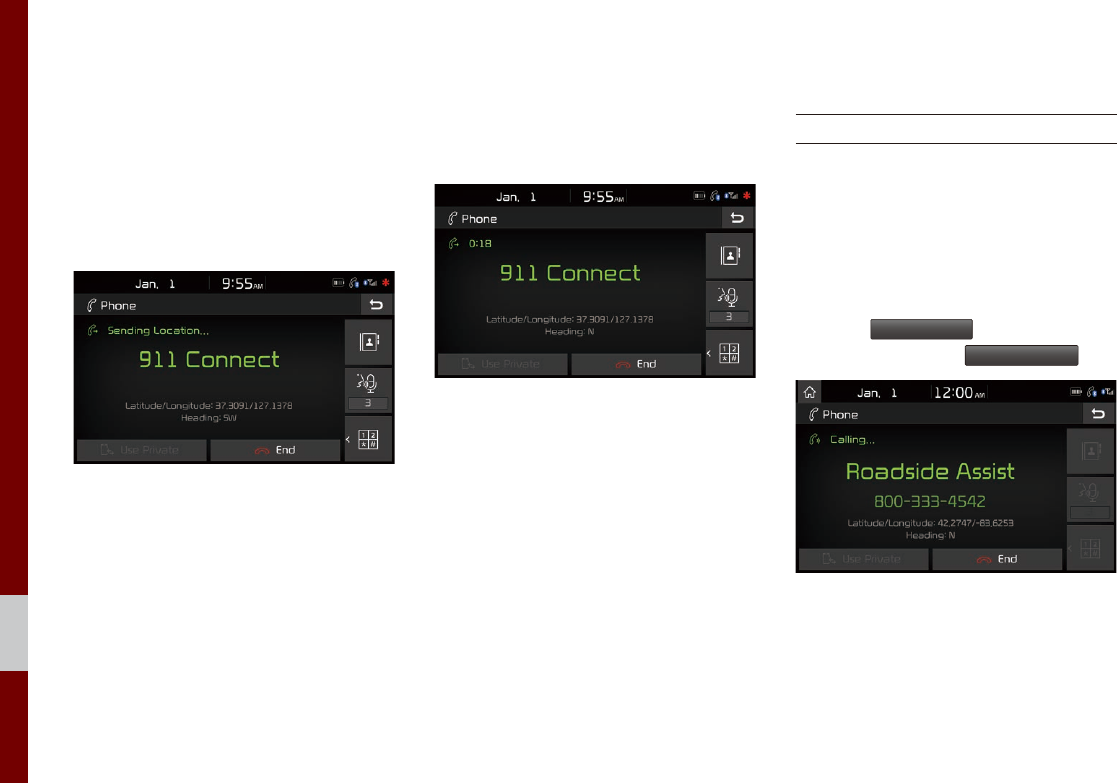
4-8 I UVO eServices
The 9-1-1 operator may request informa-
tion on the current location of your vehicle.
When the 9-1-1 operator requests your
vehicle location, “Sending Location” is
displayed on the screen and the vehicle
location is automatically sent to the 9-1-1
operator.
When the 9-1-1 operator attempts to talk
to the driver again, the call time is dis-
played and allows the driver to speak with
the 9-1-1 operator.
Roadside Assist
Roadside Assist
If there is any issues in the vehicle, you
can connect with a Roadside Assist agent.
The Roadside Assist feature can be used
only when your phone is connected via
Bluetooth.
Select the
UVO eServices
icon from All Menus
on the Home screen ▶
Roadside Assist
.
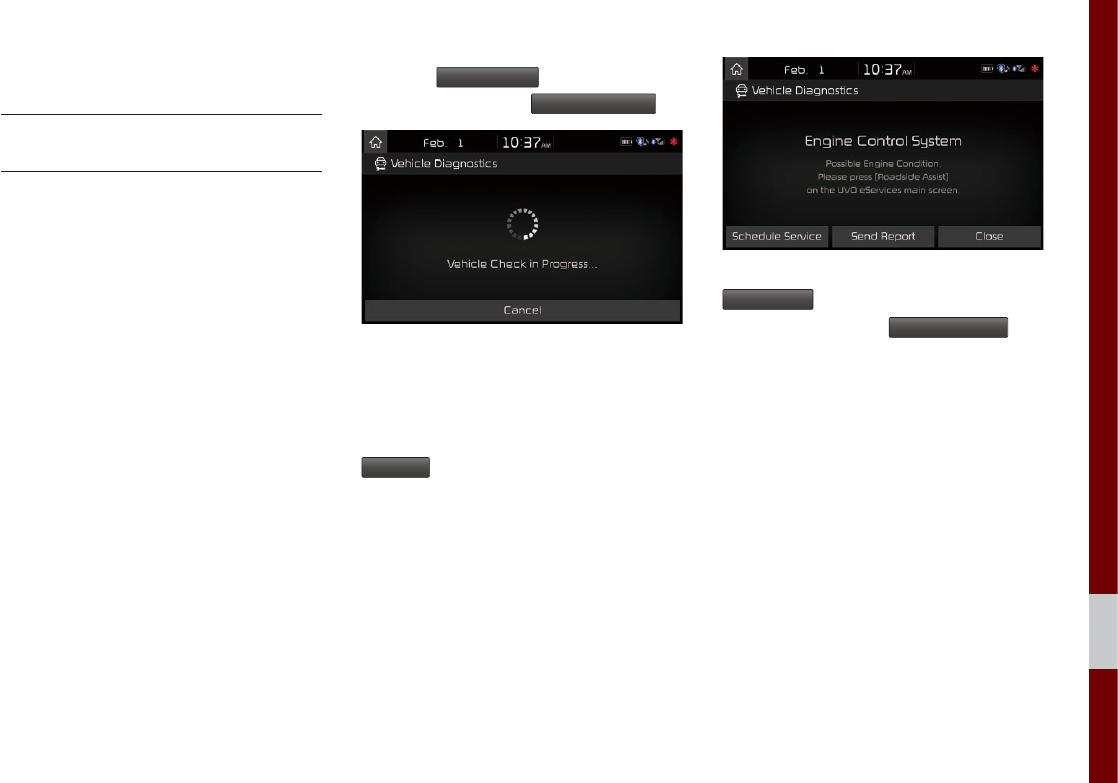
Vehicle Diagnostics I 4-9
04
Vehicle Diagnostics
Conducting Vehicle
Diagnostics
Vehicle Diagnostics is available only when
the ignition is turned on and the vehicle is
parked.
It also requires that UVO eServices is
activated, and the Phone is connected
via USB cable before starting Vehicle
Diagnostics.
Select the
UVO eServices
icon from All Menus
on the Home screen ▶
Vehicle Diagnostics
.
The Vehicle Diagnostics process will begin.
When a diagnostics check is in progress,
keep the vehicle in park with the ignition
on. To cancel diagnostics, press the
Cancel
button on the touch screen or
any hardkey.
If diagnostic issues are found, press the
Send Report
button to send to your MyUVO
account or press the
Schedule Service
but-
ton to schedule an appointment with your
preferred or nearby Kia dealer.
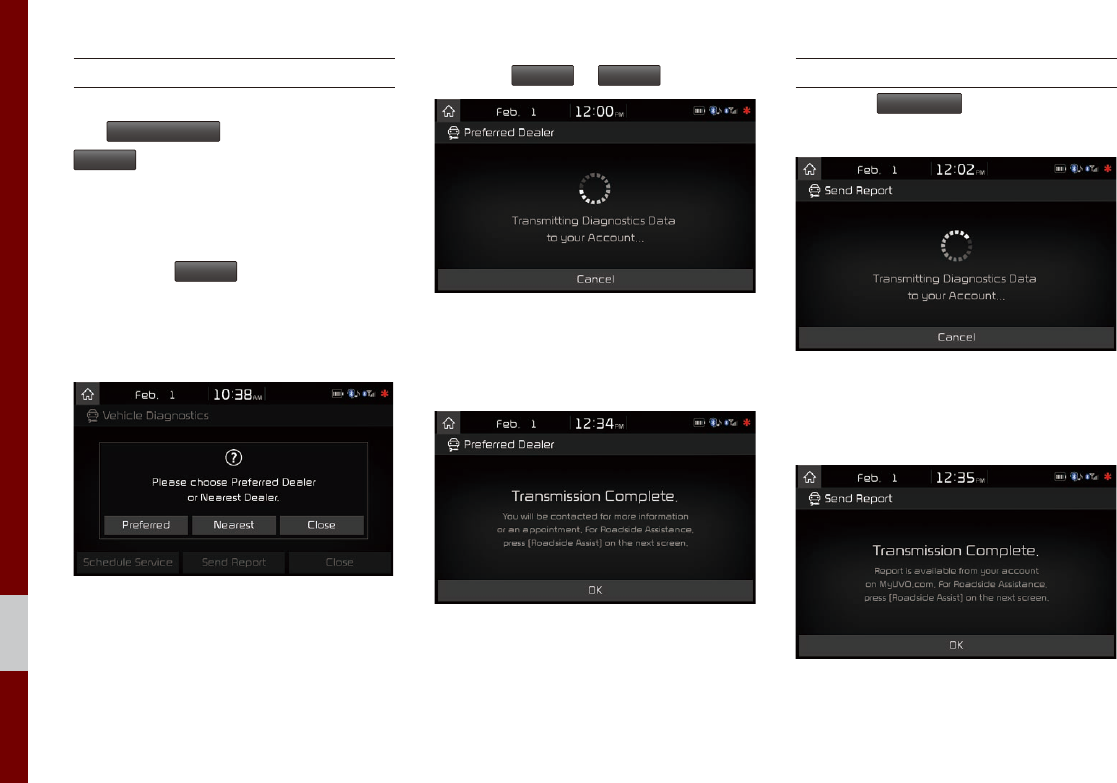
4-10 I UVO eServices
Schedule Service
When scheduling an appointment using
the
Schedule Service
button, pressing the
Preferred
button will allow you to request an
appointment with your preferred Kia dealer
and send your vehicle’s diagnostics infor-
mation.
Pressing the
Nearest
button will allow you
to request an appointment with the near-
est Kia dealer and send your vehicle’s
diagnostics information.
Press the
Preferred
or
Nearest
button.
Request an appointment with Preferred or
Nearest Kia Dealer and send your vehi-
cle’s diagnostics data.
Send Report
Press the
Send Report
in the vehicle diag-
nostics result screen.
Vehicle Diagnostics Data is transmitted to
your account and you can see the report
on MyUVO.com
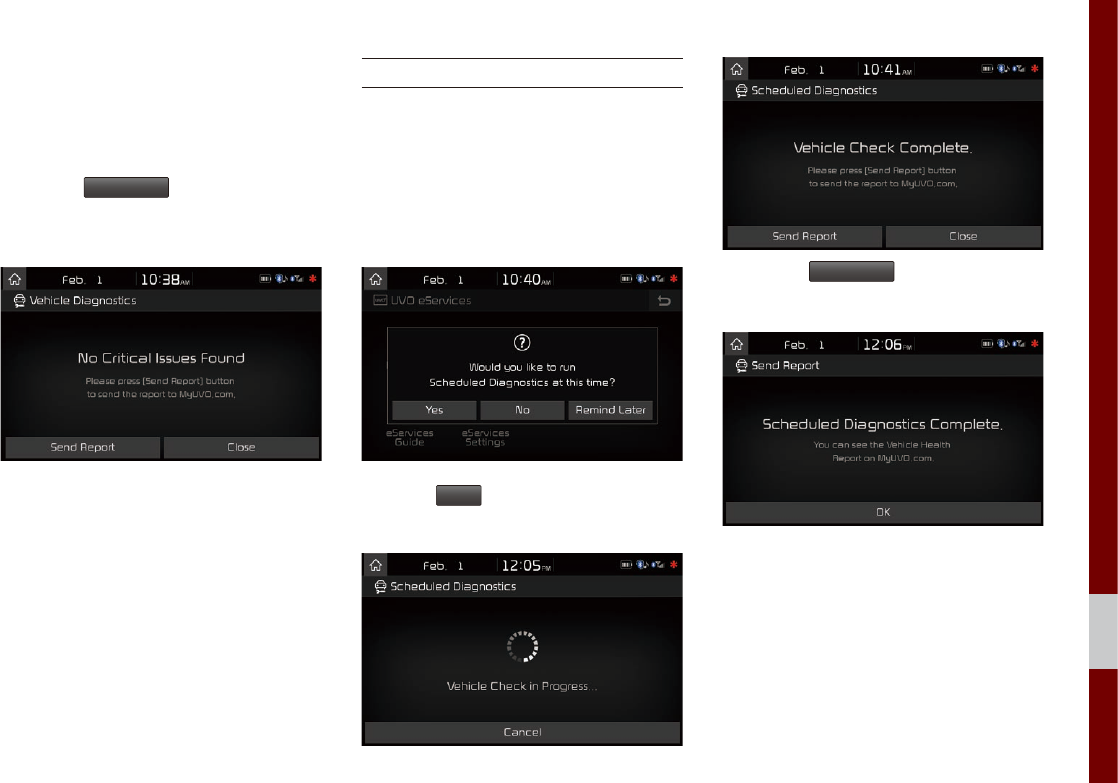
Vehicle Diagnostics I 4-11
04
Even if diagnostic issues are not found
after Vehicle Diagnostics, it is recom-
mended that you send the diagnostic
results to your MyUVO account.
Press the
Send Report
button to send the
diagnostics results to your MyUVO
account.
Scheduled Diagnostics
If you have set up Scheduled Diagnostics
on your UVO eServices App, a vehicle
diagnostics check will automatically start
on the day you selected.
On the date of the Scheduled Diagnostics,
the following window will be displayed.
Press the
Yes
button on the touch screen
to proceed with diagnostics.
Press the
Send Report
button to see the
Vehicle Health Report on MyUVO.com.
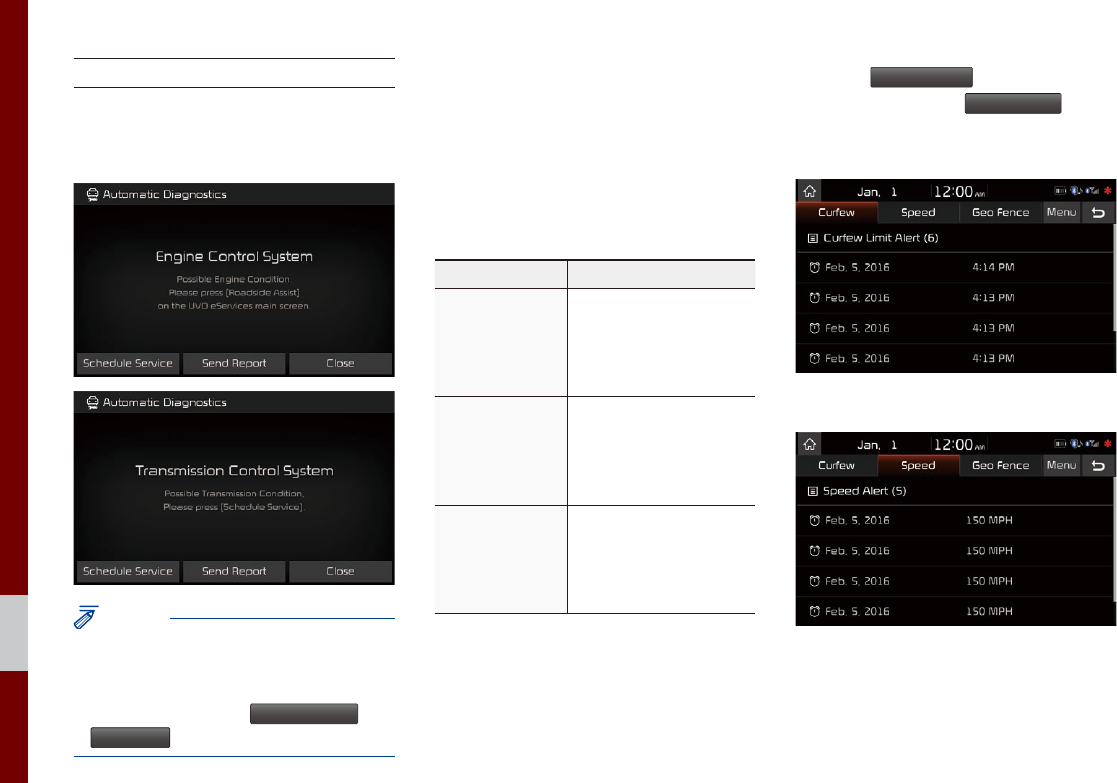
4-12 I UVO eServices
Automatic Diagnostics
If a critical diagnostics issue with your
vehicle’s powertrain is detected, Automatic
Diagnostics will be notified.
NOTICE
• The screen messages differ based on the
vehicle diagnostics severity. Ensure your
phone is connected to the system via USB
cable before using
Schedule Service
and
Send Report
.
My Car Zone
My Car Zone is a feature that provides
alerts and driving history for Curfew Limit
Alerts, Speed Alerts, and Geo Fence
Alerts set by the user.
Name Description
Curfew Limit
Alert
Curfew Limit Alerts are
alerts that are triggered
when a driver is driving
within a predefined time
range.
Speed Alert
Speed Alerts are alerts
that are triggered when
a driver exceeds the
predefined maximum
speed.
Geo Fence
Alert
Geo Fence Alerts are
alerts that are triggered
when a driver enters
into a predefined geo-
graphical location.
My Car Zone features are supported only
when UVO eServices has been activated.
Select the
UVO eServices
icon from All Menus
on the Home screen ▶
My Car Zone
.
Curfew Limit Alerts History
Speed Alerts History
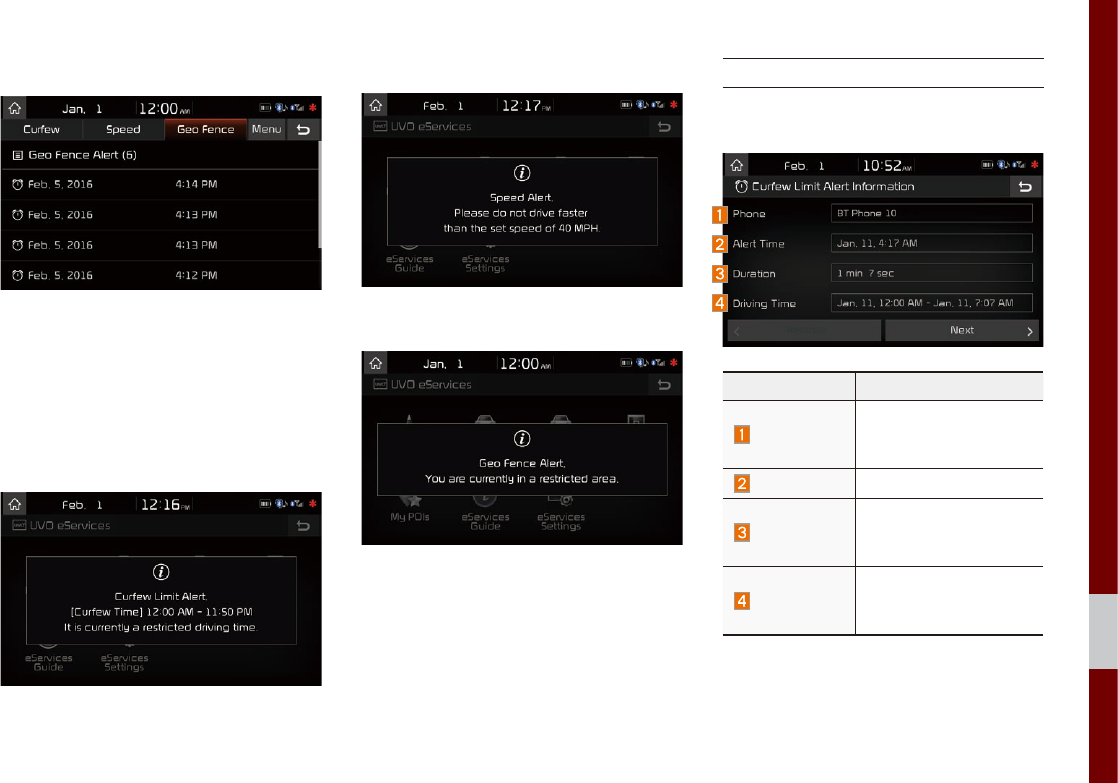
My Car Zone I 4-13
04
Geo Fence Alerts History
When a driver does not keep the pre-de-
fined driving conditions, popup is displayed
with voice guidance and save alerts in the
My Car Zone history.
Curfew Limit Alert
Speed Alert
Geo Fence Alert
Curfew Limit Alert
You can check the Curfew Limit Alert his-
tory for a list of past triggered curfew alerts.
Name Description
Phone
Name of phone con-
nected upon triggered
curfew limit
Alert Time Initial alert time
Duration
Total duration of driving
while curfew limit was
triggered
Driving Time
Total driving time from
turning ignition on until
turning ignition off
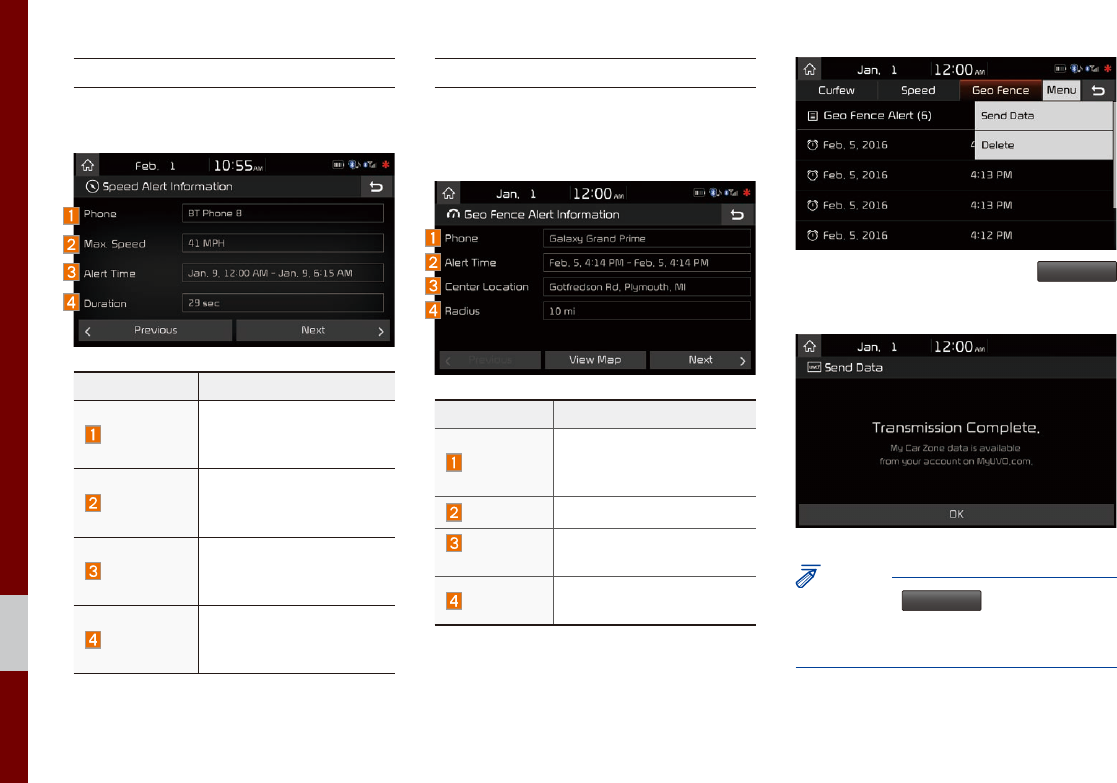
4-14 I UVO eServices
Speed Alert
You can check the Speed Alert history for
triggered speed limit alerts of the vehicle.
Name Description
Phone
Name of phone con-
nected upon triggered
speed limit alert
Max. Speed
Maximum vehicle speed
upon triggered speed
limit alert
Alert Time
Time from first triggered
alert until last triggered
alert
Duration
Total triggered alert time
from turning ignition on
to turning ignition off
Geo Fence Alert
You can check the Geo Fence Alert his-
tory for triggered Geo Fence alerts of the
vehicle.
Name Description
Phone
Name of phone con-
nected upon triggered
geo fence alert
Alert Time Initial alert time
Center
Location
Radius from set center
location address
Radius Radius from set geo
fence address
To check My Car Zone alert history from
your smartphone, you must first send the
alert history to your MyUVO account.
From the Menu tab, Press the
Send Data
button on the touch screen.
NOTICE
• Before using
Send Data
, ensure your phone
is connected to the UVO eSevices system via
USB cable.
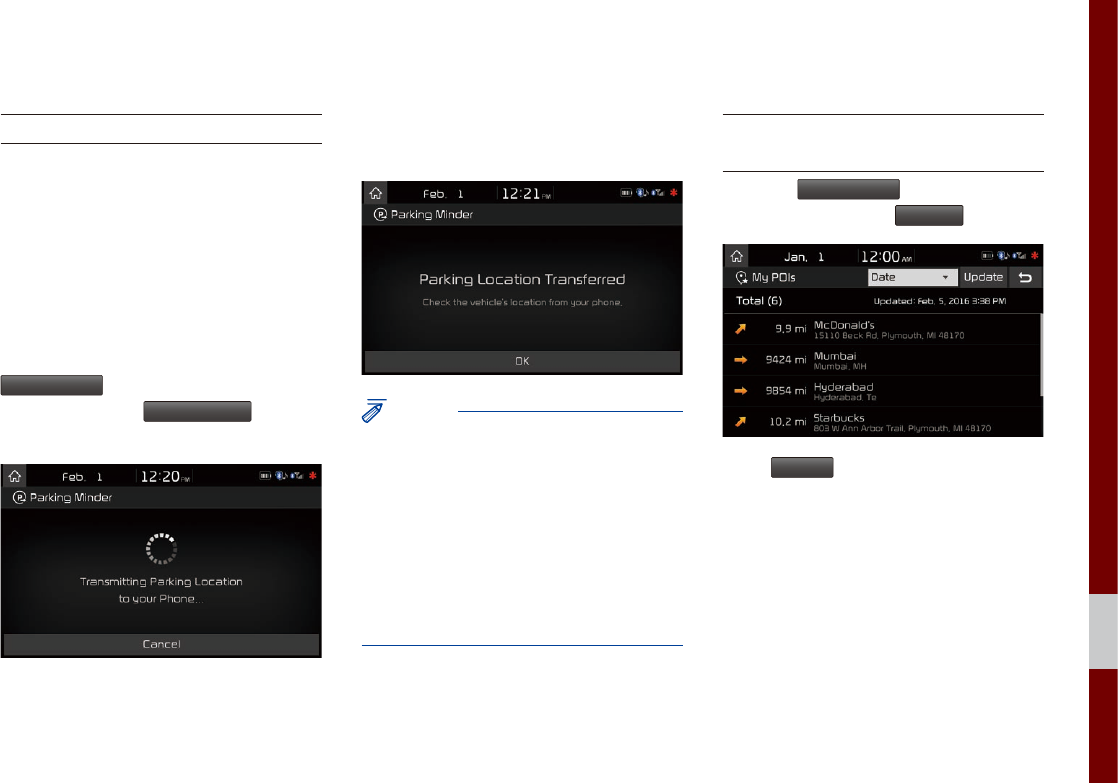
My POIs I 4-15
04
Parking Minder
Sending Parking Location
The location where your vehicle is currently
parked can be sent to your smartphone.
Ensure that your smartphone is connected
via USB and the UVO eServices App is
running before using this feature.
After parking the vehicle, select the
UVO eServices
icon from All Menus on the
Home screen ▶
Parking Minder
to send
the vehicle’s location to your smartphone.
Once the parking location has been sent,
you can view your vehicle’s location from
the UVO eServices App on your smart-
phone.
NOTICE
• When the parking location is being sent, do
not drive the vehicle. Ensure that you have
logged into the UVO eServices App, and your
phone is connected to the multimedia system
via USB cable.
• When ignition is turned off while the phone is
connected via USB, Parking Minder can be
transferred automatically if the option is set up
in UVO eService Settings
My POIs
Sending Points of Interest
to Your Navigation System
Select the
UVO eServices
icon from All Menus
on the Home screen ▶
My POIs
.
Press
Update
button on the touch screen.
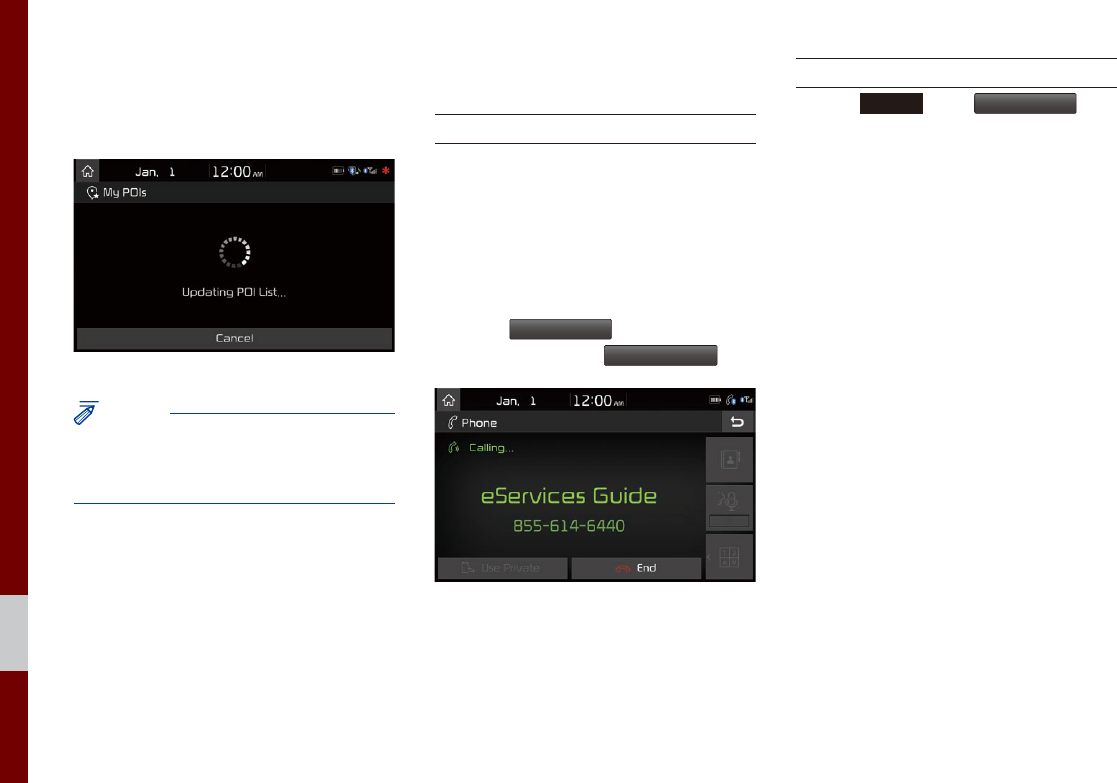
4-16 I UVO eServices
UVO eServices system will attempt to
download the POIs from MyUVO via your
smartphone.
NOTICE
• Ensure that you have logged in to the UVO
eServices App, and your phone is connected
to the UVO eServices system via USB cable.
Once the POIs have been downloaded,
select a POI from the list to see more
details.
eServices Guide
eServices Guide
eServices Guide provides guidance on
how to use UVO eServices.
This feature is only available when the
mobile phone is connected via Bluetooth.
Select the
UVO eServices
icon from All Menus
on the Home screen ▶
eServices Guide
.
UVO eServices Settings
Refer to
SETUP
key ▶
UVO eServices
.

Basic Features
Quick Menu
Destination Search
Route Search
Navigation Settings
Troubleshooting
part.5 Navigation
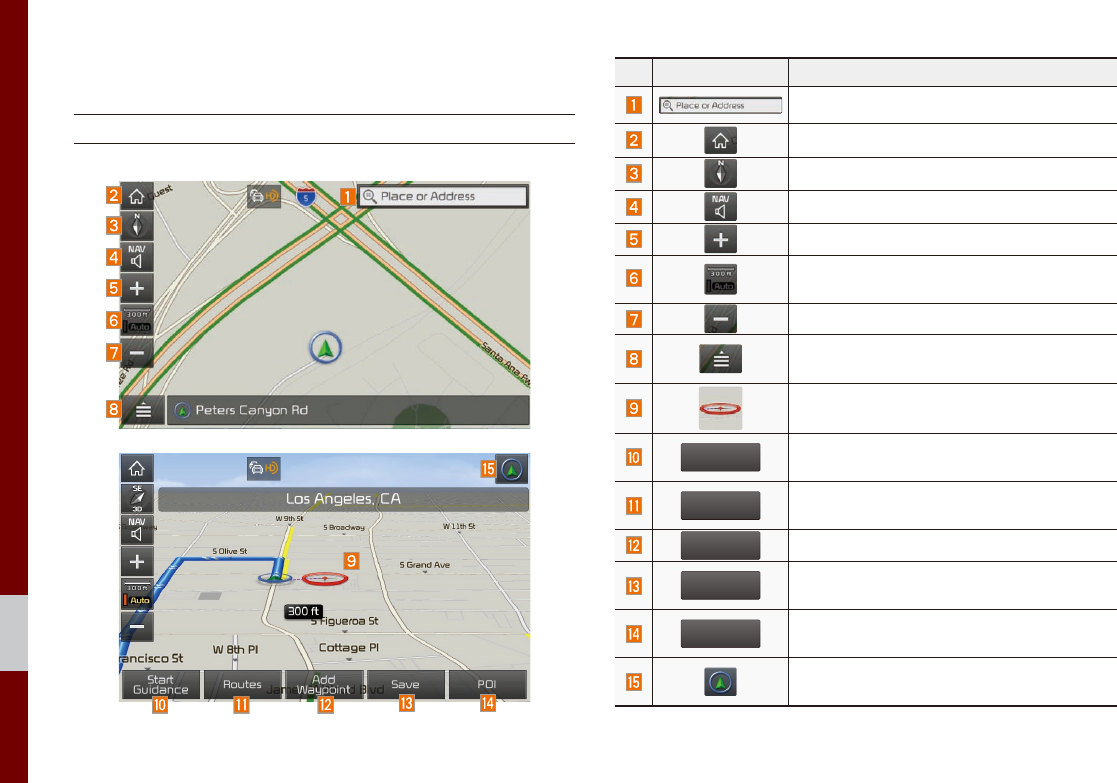
5-2 I Navigation
Navigation
Basic Features
Operating Navigation Screen
Basic features on the map screen.
Name Description
Move to Places Menu.
Go to the Home screen.
Change the map view mode.
Adjusts the volume.
Zoom in the map.
Set the zoom level automatically according
to the guidance.
Zoom out the map.
Quick Menu for destination selection and
options.
Touch to scroll the map.
Start
Guidance
Start the preferred navigation route to
selected location.
Routes
Choose the preferred navigation route to
selected location.
Add
Waypoint
Set a waypoint to the current route.
Save
Save frequently used address to address
book.
POI
Find a POI(Point Of Interest) around the
current position.
View the vehicle’s current position on the
map screen.
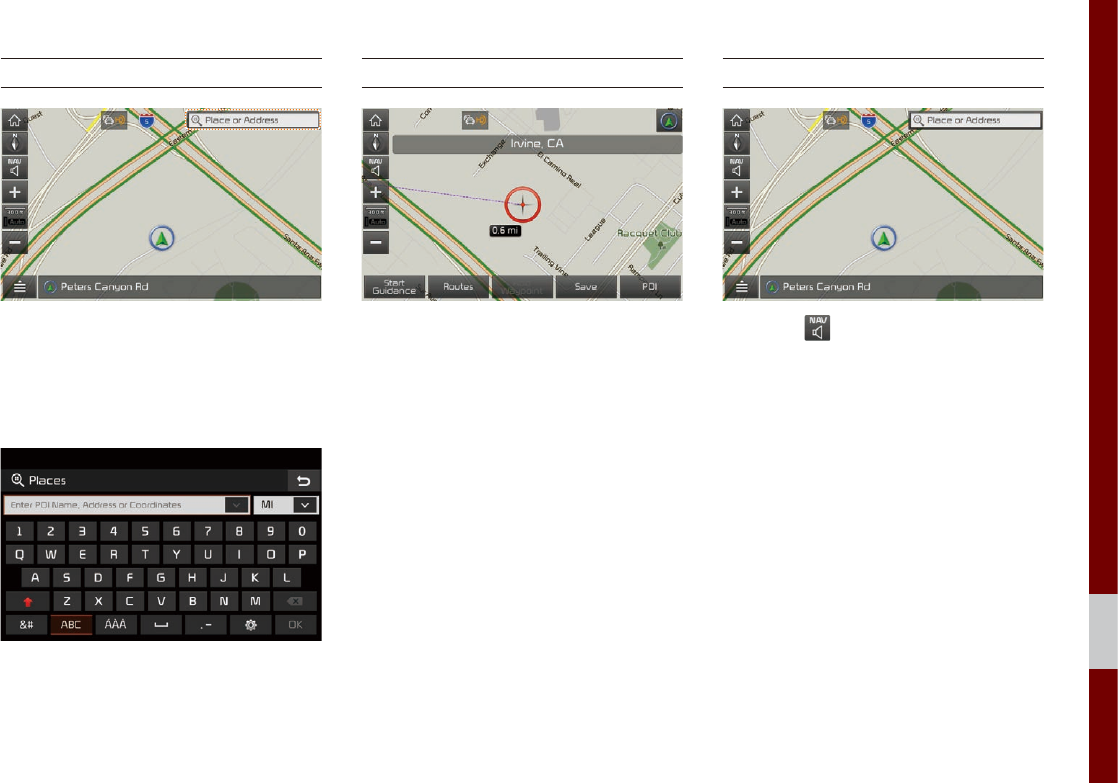
Basic Features I 5-3
05
Places
You can use this menu when the vehi-
cle shift lever is in P (Park) and there
is no destination set. Press the Search
Icon(Place or Address) to move to “Places”.
Please refer to “Places” in “Destination
Search” for more details.
Changing Map View
Touch the compass arrow icon to toggle
between a map oriented to the North, ori-
ented parallel to the vehicle’s heading and
3D View.
Navigation Volume
Select the button to adjust the naviga-
tion volume.
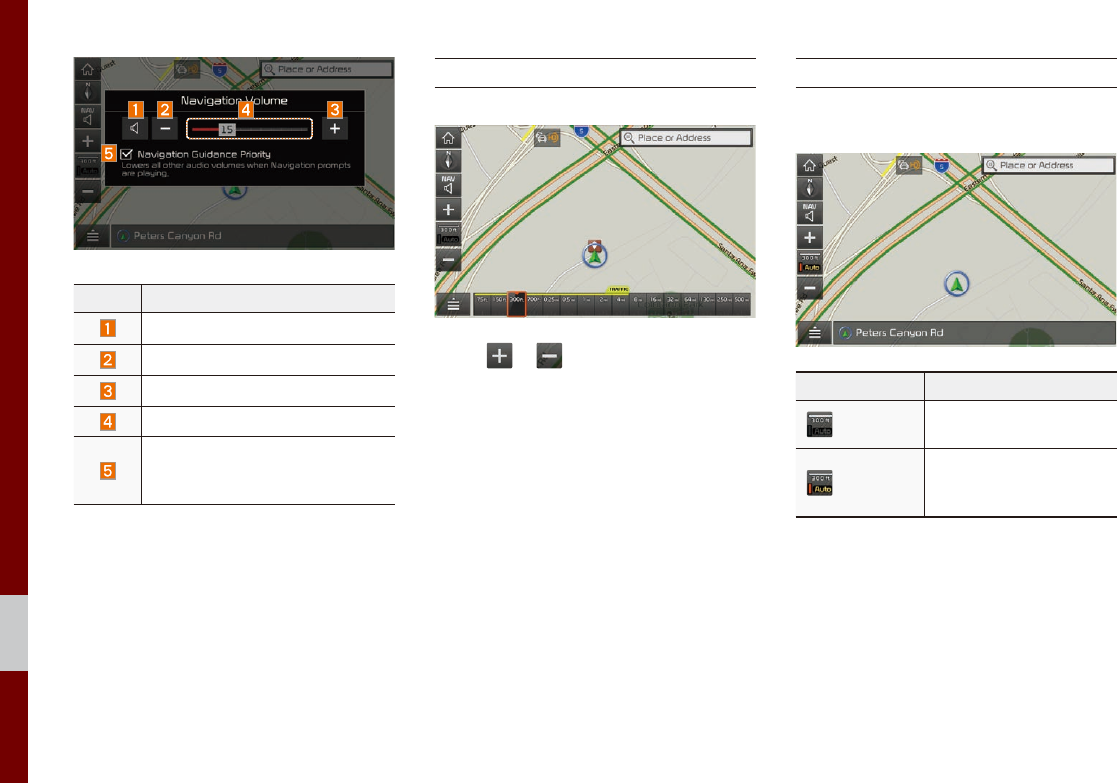
5-4 I Navigation
Name Description
Set the volume to mute.
Turn the volume down.
Turn the volume up.
Slide to set the volume.
Lowers all other audio volumes
when Navigation prompts are
playing.
Zoom In/Zoom Out
Zoom the map view screen in and out.
Select or to set the zoom level.
Map Scale
Sets the zoom level automatically accord-
ing to the type of road.
Name Description
Scale Fix Manually adjust the map
scale.
Auto Scale Change the map scale
automatically depending
on the type of road.
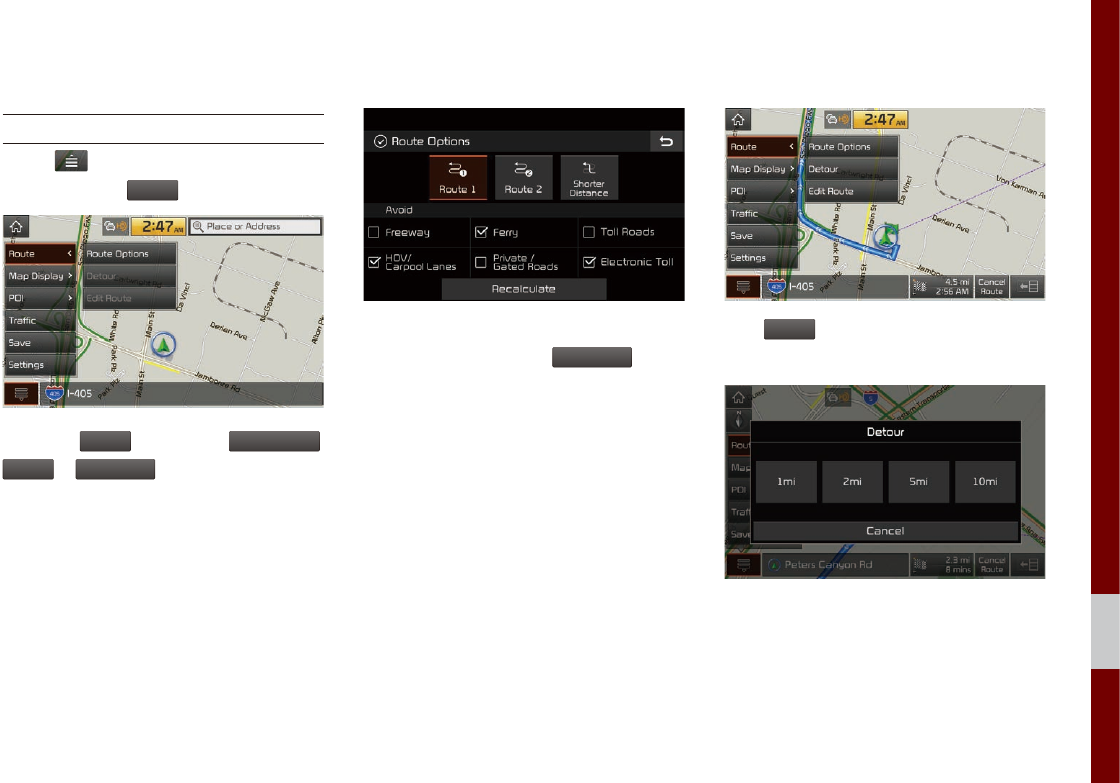
Quick Menu I 5-5
05
Quick Menu
Route
Select button on the bottom left of the
screen ▶ Press
Route
button.
Select the
Route
button to set
Route Options
,
Detour
or
Edit Route
.
Route Options
Select your preferred route and avoid
options. Then select the
Recalculate
button
to save your selection. These options will
become default for future routes.
Detour
The
Detour
button is active only when
there is an active route.
Selected distance is detoured from the
current location.
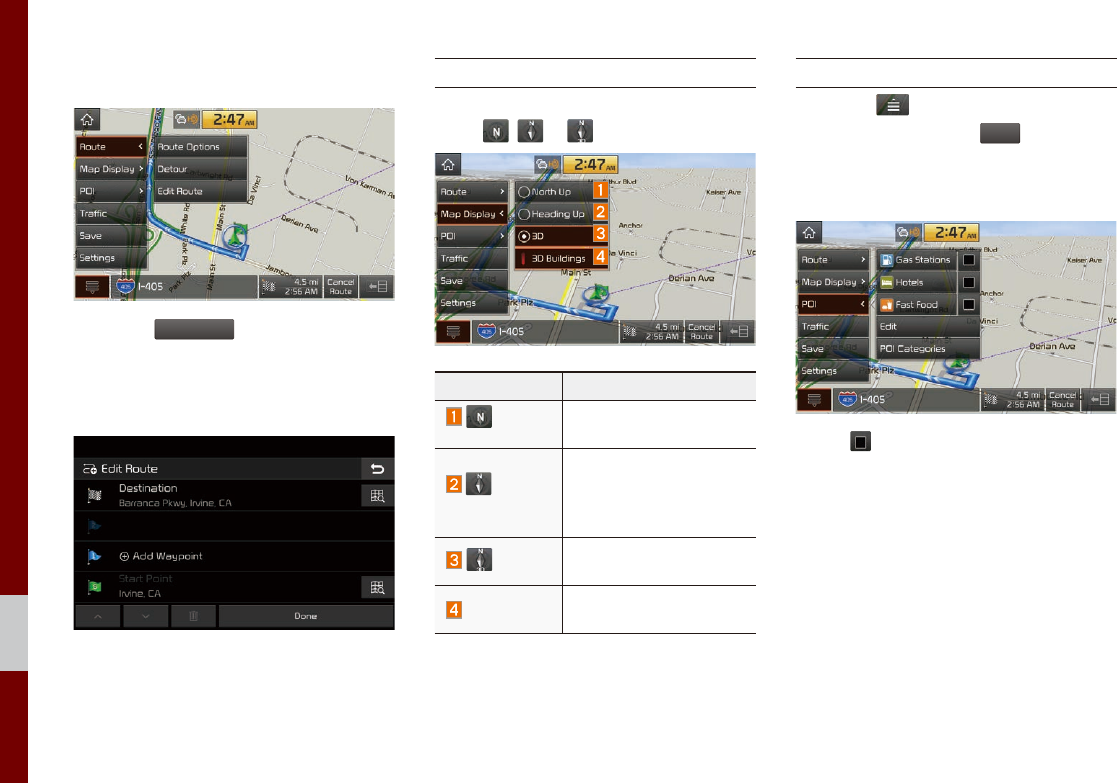
5-6 I Navigation
Edit Route
Select the
Edit Route
button to change the
route.
Refer to the Route > Editing Route section in
the manual for more information(page 5-26).
Map Display
Displays the direction of the map.
Press , or .
Name Description
North
Up (2D)
Displays always has
north at the top of screen.
Heading
Up (2D)
Displays always shows
the vehicle’s direction as
proceeding towards the
top of the screen.
3D Shows the map in
3 dimentions.
3D Buildings
Shows or hides build-
ings on the map.
POI
Select the button on the bottom left of
the screen ▶ Select the
POI
button.
View Nearby POIs
Select check button to set whether to
show nearby POIs or not. When catego-
ries are selected, they will appear on the
map. (ex. Gas Stations)
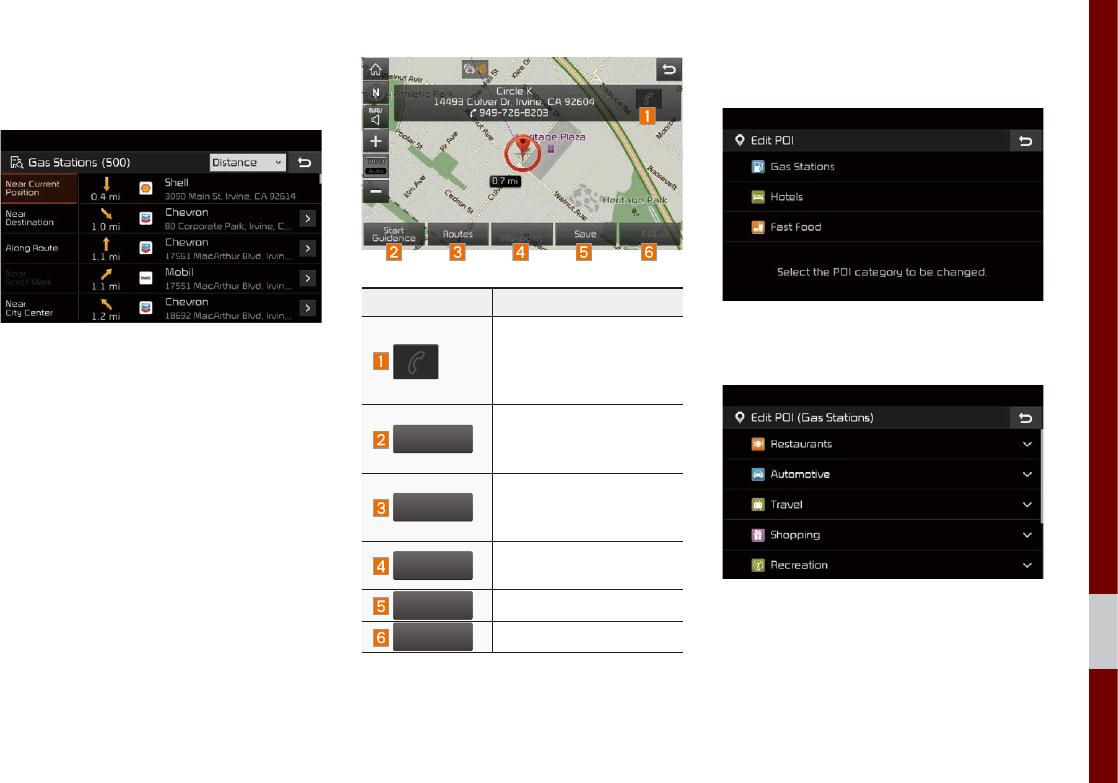
Quick Menu I 5-7
05
The lists of nearby gas stations are dis-
played.
The list can be sorted to display in order of
distance or name.
Name Description
Call to the selected
location (Phone needs
to be connected via
Bluetooth).
Start
Guidance
Start the preferred navi-
gation route to selected
location.
Routes
Choose the preferred
navigation route to
selected location.
Add
Waypoint
Set the location as a
waypoint.
Save
Save the location.
POI
Search nearby POIs.
Edit
Change the shortcut POIs to display.
(ex. Gas Stations)
Select the desired category to change.
(ex Restaurants)
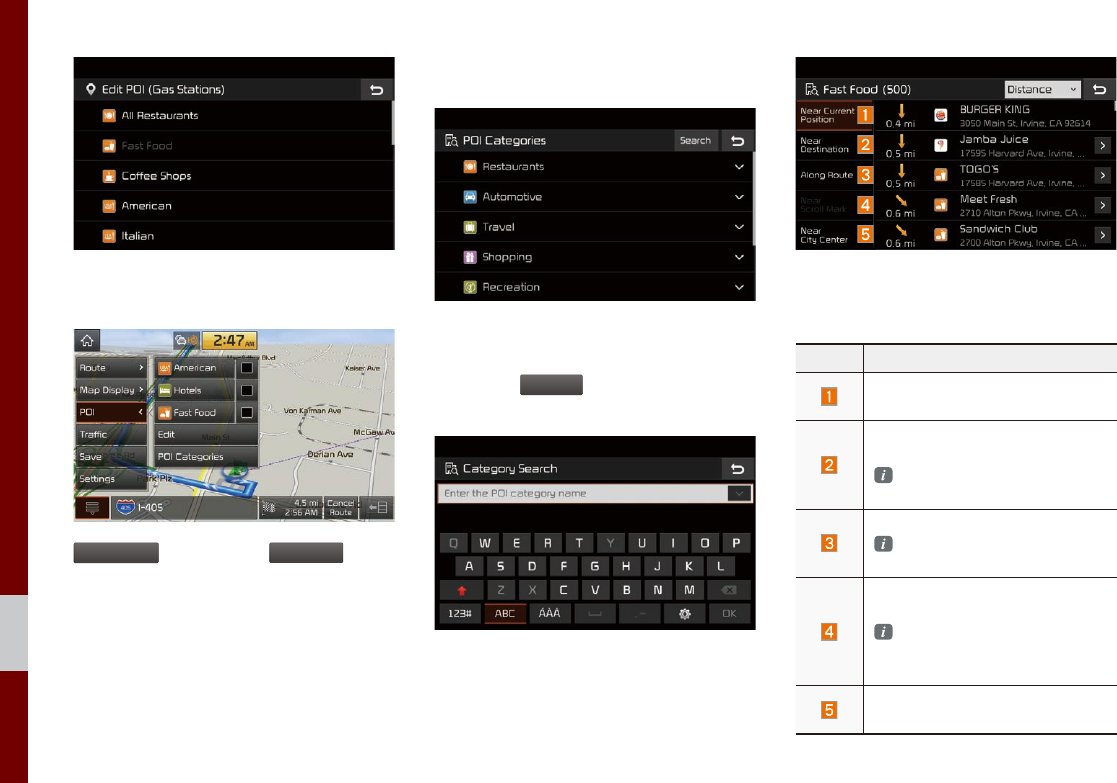
5-8 I Navigation
Select new category to display.
(ex. American)
Gas Stations
is changed to
American
.
POI Categories
Select the item to search.
Press the
Search
button to search the
POI category by name.
Select the desired POI to check the loca-
tion and for detailed information.
Name Description
Search POI around the current
position.
Search POI around the destina-
tion.
Active only when a route’s
planned.
Search POI along route.
Active only when a route’s
planned.
Search POI around the current
cursor when the map scrolled.
Active only when the cursor
position is different from the
vehicle position.
Search POI around the city
selected.
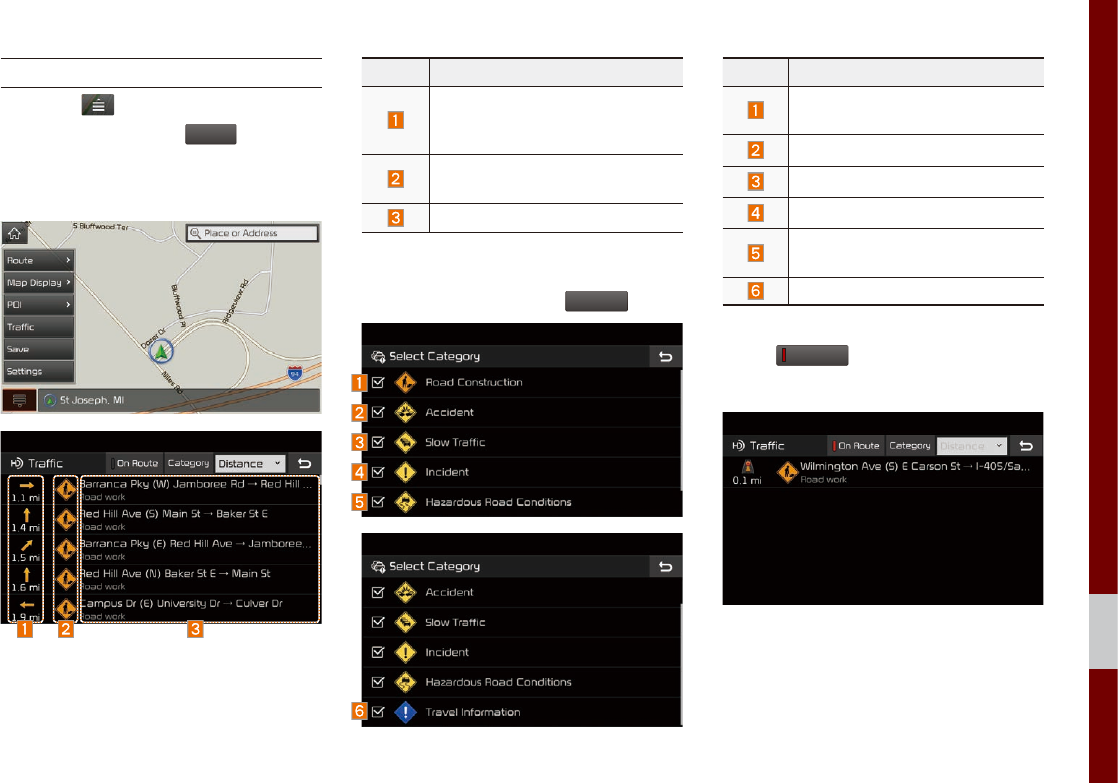
Quick Menu I 5-9
05
Traffic
Select the button on the bottom left of
the screen ▶ Select the
Traffic
button.
Traffic List
On the traffic list, the current traffic/road
event information is displayed in order of
distance.
Name Description
Direction from the current location.
Distance from the current loca-
tion (mi or km).
Displays traffic info symbol based
on the type of event.
Description of traffic event.
Additional traffic information may be dis-
played upon clicking on the
Category
button.
Name Description
Display ‘Road Construction’ infor-
mation.
Display ‘Accident’ information.
Display ‘Slow Traffic’ information.
Display ‘Incident’ information.
Display ‘Hazardous Road
Conditions’ information.
Display ‘Travel Information’.
When
On Route
is activated, only traffic
information on your route is displayed.
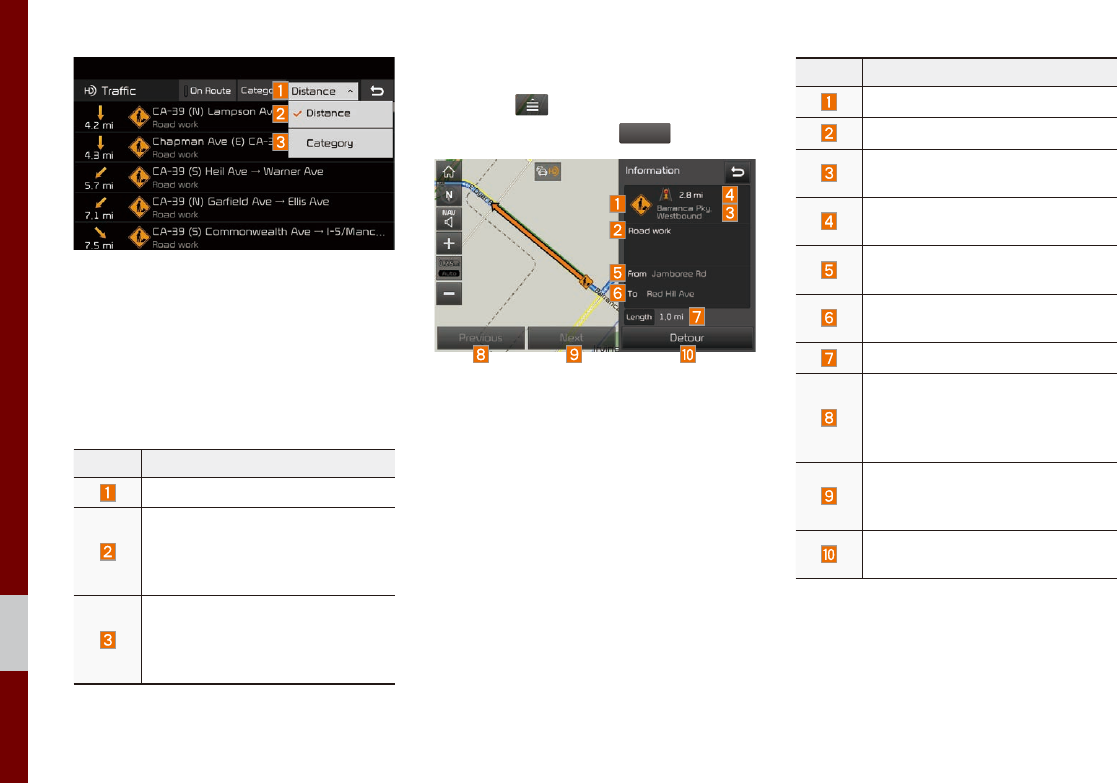
5-10 I Navigation
On the traffic list, the current basic traffic/
road event information is displayed in
order of distance.
Select the combo box to change the
arrangement in order of Category/
Distance.
Name Description
Select the combo box to arrange.
Arrangement by distance: Display
the traffic information in order
of distance closer to the current
location.
Arrangement by category: Display
traffic information arranged in
order of traffic information event
type.
Traffic detail
Select the button on the bottom left of
the screen ▶ Select the
Traffic
button.
Select the traffic information on the traffic
list to display the detailed screen as shown
in the screen.
Display the symbol of traffic event and
arrow which indicates the road from start
to end of the traffic event. Detailed infor-
mation is available on the right screen.
Name Description
Symbol of traffic event.
Event name of traffic information.
Road name/road number includ-
ing direction.
Direction and distance from the
current location.
Intersection where traffic event
starts.
Intersection where traffic event
ends.
Total distance of traffic event.
Check the previous traffic infor-
mation (Enabled only when there
are two or more events on the On
Route)
Check the next traffic information
(Enabled only when there are two
or more events on the On Route)
Detour the route based on the
traffic information.
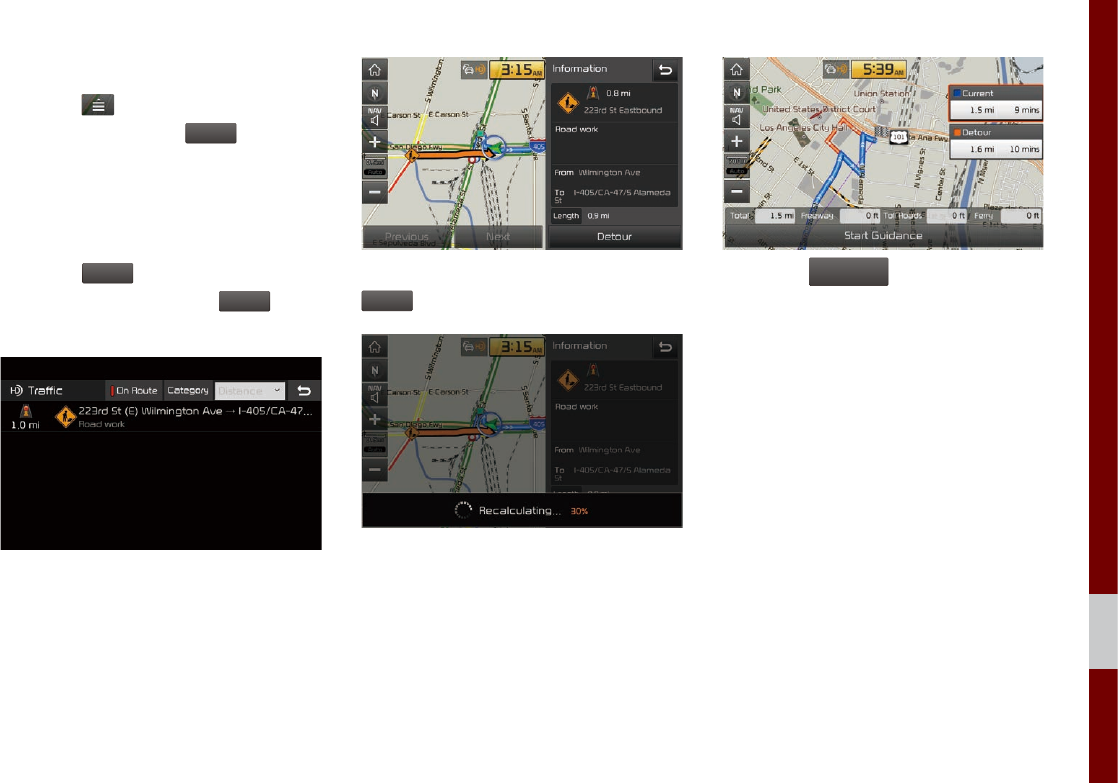
Quick Menu I 5-11
05
Traffic detour
Select the button on the bottom left of
the screen ▶ Select the
Traffic
button.
If there is traffic information on the route, it
is possible to detour the route using traffic
information and search other routes.
When the
Detour
button is enabled in the
View Traffic Detail, press the
Detour
button
to detour.
Select the desired section.
Check the information and press the
Detour
button.
Select the
Start
Guidance
button to apply the
detoured sections and search other routes.
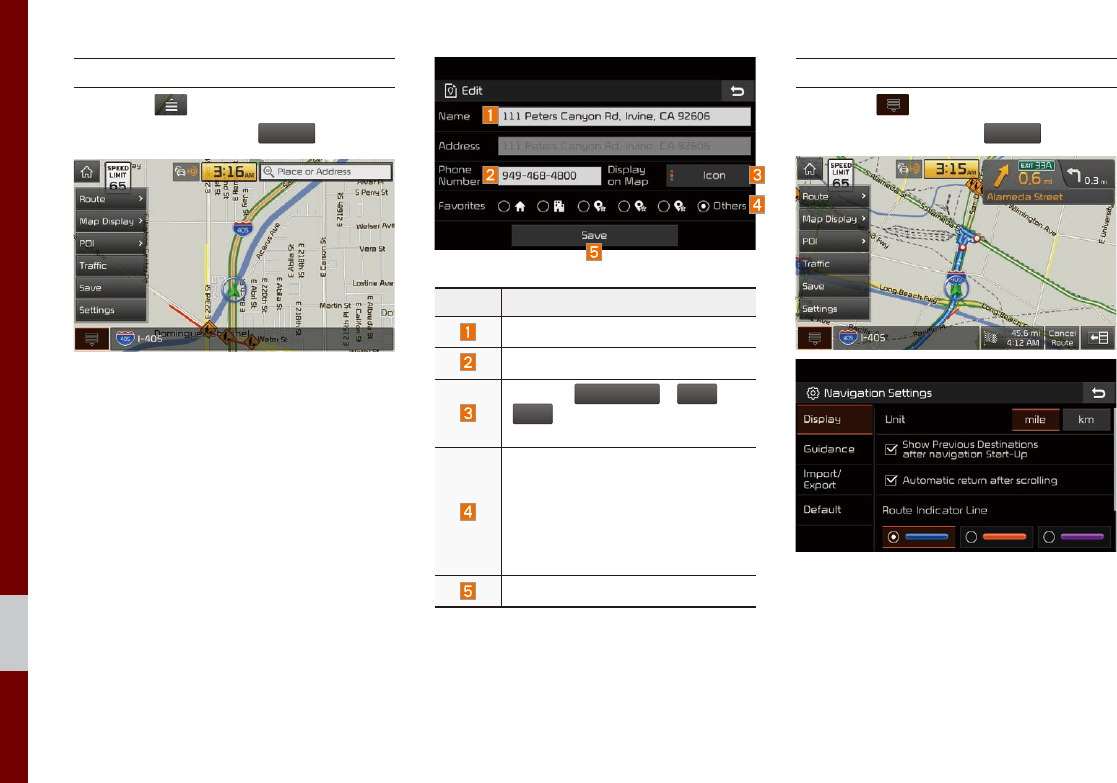
5-12 I Navigation
Save
Select the button on the bottom left of
the screen ▶ Select the
Save
.
To store the location on the current map to
the address book.
Name Description
Change the name.
Enter the phone number.
Press
Icon&Name
,
Icon
o r
None
to display on the map
screen.
Designate to the Favorite item.
When the favorite is designated,
press the button on the bottom
of the Destination menu and
request the route guide immedi-
ately.
Save the setting.
Settings
Select the button on the left bottom of
the screen. ▶ Select the
Settings
.
Change navigation settings. For more
details, refer to “Navigation Settings” on
page 5-29
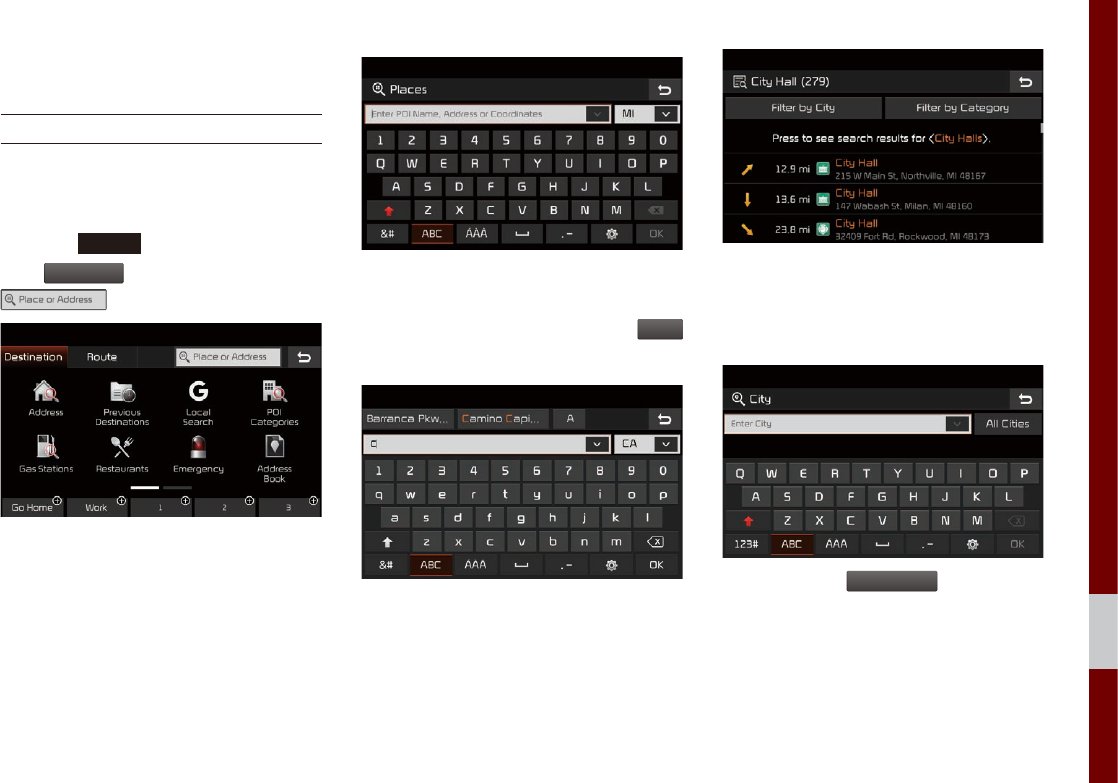
Destination Search I 5-13
05
Destination Search
Places
You can enter POI Name, Address or
Coordinates that you wish to search by.
Press the
NAV
head unit key. ▶ Select
the
Destination
tab. ▶ Select the
Search Bar.
Enter the POI Name, Address and
Coordinates of the location you want in the
input window above, and press the
OK
button.
If you select a location from the search
result list, it will bring you to the point.
If you press the
Filter by City
button on the
search result screen, it will bring you to the
City search screen where you can filter the
search results by city names.
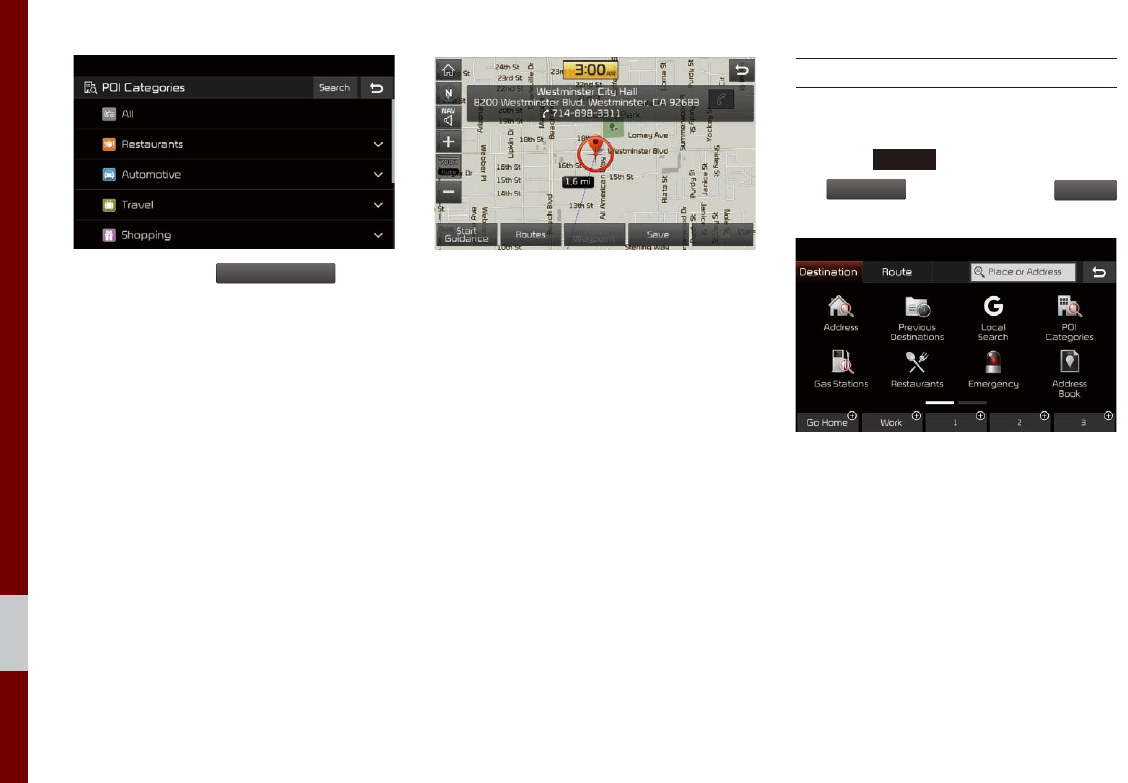
5-14 I Navigation
If you press the
Filter by Category
button
from the search result screen, it will bring
you to the POI Categories screen where
you can filter the search results by POI
Categories.
Once the destination has been identified
either by POI name, address, or coordi-
nates, the map screen will be displayed.
From this screen you can set the desti-
nation or add a waypoint, or add the dis-
played destination to your address book.
Address
Set destination by address search.
Press the
NAV
head unit key. ▶ Select
the
Destination
tab. ▶ Select the
Address
icon.
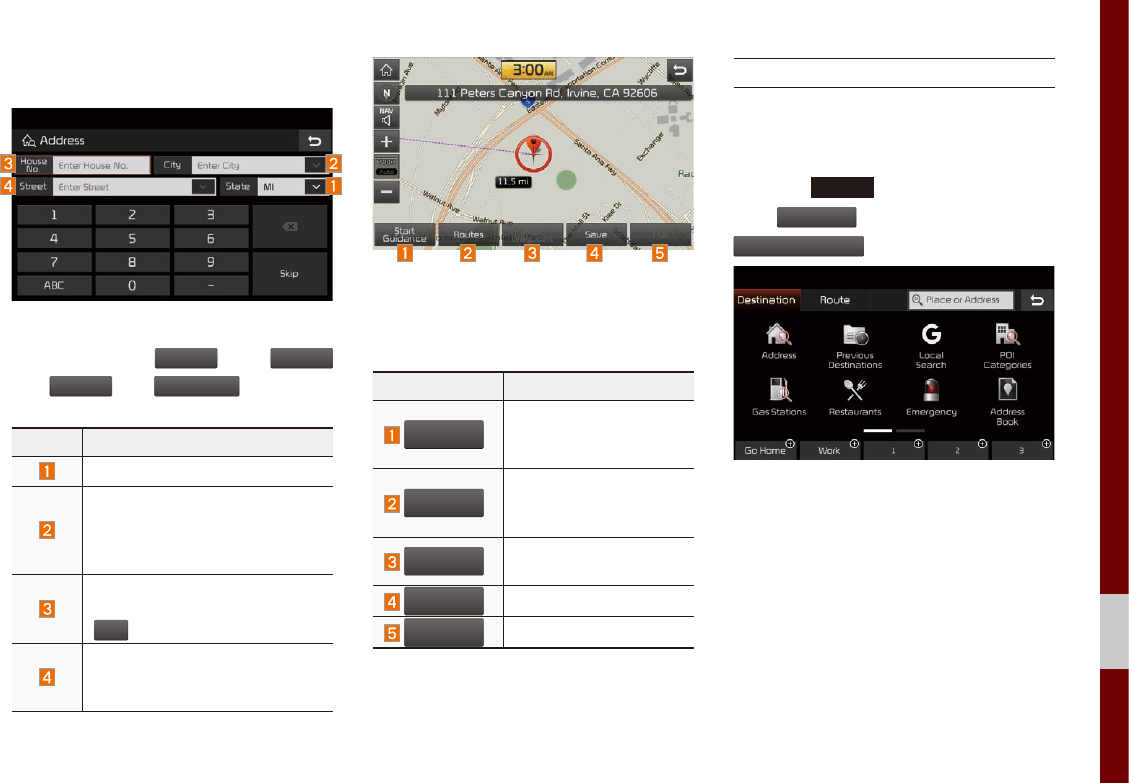
Destination Search I 5-15
05
How to Search Address
Search criteria can be entered in any
order. Example:
State
then
City
then
Street
then
House No.
.
Name Description
Select state to search.
Select a city before entering
the street name. Addresses are
searched only from the selected
city.
Enter house number. If you don’t
know the house number, press
Skip
button.
Enter a street name. If same
street names exist in other cities,
the list of cities will be displayed.
Enter the address to check the location
information on the map.
Name Description
Start
Guidance
Start the preferred navi-
gation route to selected
location.
Routes
Choose the preferred
navigation route to
selected location.
Add
Waypoint
Set the location as a
waypoint.
Save
Save the location.
POI
Search nearby POIs.
Previous Destinations
Select from previously inputted addresses
and POIs.
Press the
NAV
head unit key. ▶ Select
the
Destination
tab. ▶ Select the
Previous Destinations
icon.